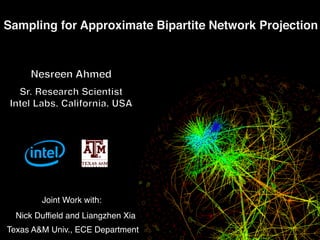
Sampling for Approximate Bipartite Network Projection
- 1. Joint Work with: Nick Duffield and Liangzhen Xia Texas A&M Univ., ECE Department
- 2. § Bipartite networks are a special class of networks § A bipartite network is a graph whose vertices can be divided into two disjoint and independent sets Bipartite Networks v1 v2 v3 v4 u1 u2 u3 u4 u5 u6 Bipartite Graph U<latexit sha1_base64="pmca1lsSN1iD77Cs3TXjIyYjgkk=">AAACAHicbVBNS8NAEN3Urxq/oh48eFksgqeSiKDHohePFUxbaEPZbDft0s0HuxOxhFz8K148KOLVn+HNf+MmzUFbHww83pthZp6fCK7Atr+N2srq2vpGfdPc2t7Z3bP2DzoqTiVlLo1FLHs+UUzwiLnAQbBeIhkJfcG6/vSm8LsPTCoeR/cwS5gXknHEA04JaGloHQ2APYIfZG5umibWMEsMrYbdtEvgZeJUpIEqtIfW12AU0zRkEVBBlOo7dgJeRiRwKlhuDlLFEkKnZMz6mkYkZMrLygdyfKqVEQ5iqSsCXKq/JzISKjULfd0ZEpioRa8Q//P6KQRXXsajJAUW0fmiIBUYYlykgUdcMgpipgmhkutbMZ0QSSjozIoQnMWXl0nnvOnYTefuotG6ruKoo2N0gs6Qgy5RC92iNnIRRTl6Rq/ozXgyXox342PeWjOqmUP0B8bnD9JnkqE=</latexit><latexit sha1_base64="pmca1lsSN1iD77Cs3TXjIyYjgkk=">AAACAHicbVBNS8NAEN3Urxq/oh48eFksgqeSiKDHohePFUxbaEPZbDft0s0HuxOxhFz8K148KOLVn+HNf+MmzUFbHww83pthZp6fCK7Atr+N2srq2vpGfdPc2t7Z3bP2DzoqTiVlLo1FLHs+UUzwiLnAQbBeIhkJfcG6/vSm8LsPTCoeR/cwS5gXknHEA04JaGloHQ2APYIfZG5umibWMEsMrYbdtEvgZeJUpIEqtIfW12AU0zRkEVBBlOo7dgJeRiRwKlhuDlLFEkKnZMz6mkYkZMrLygdyfKqVEQ5iqSsCXKq/JzISKjULfd0ZEpioRa8Q//P6KQRXXsajJAUW0fmiIBUYYlykgUdcMgpipgmhkutbMZ0QSSjozIoQnMWXl0nnvOnYTefuotG6ruKoo2N0gs6Qgy5RC92iNnIRRTl6Rq/ozXgyXox342PeWjOqmUP0B8bnD9JnkqE=</latexit><latexit sha1_base64="pmca1lsSN1iD77Cs3TXjIyYjgkk=">AAACAHicbVBNS8NAEN3Urxq/oh48eFksgqeSiKDHohePFUxbaEPZbDft0s0HuxOxhFz8K148KOLVn+HNf+MmzUFbHww83pthZp6fCK7Atr+N2srq2vpGfdPc2t7Z3bP2DzoqTiVlLo1FLHs+UUzwiLnAQbBeIhkJfcG6/vSm8LsPTCoeR/cwS5gXknHEA04JaGloHQ2APYIfZG5umibWMEsMrYbdtEvgZeJUpIEqtIfW12AU0zRkEVBBlOo7dgJeRiRwKlhuDlLFEkKnZMz6mkYkZMrLygdyfKqVEQ5iqSsCXKq/JzISKjULfd0ZEpioRa8Q//P6KQRXXsajJAUW0fmiIBUYYlykgUdcMgpipgmhkutbMZ0QSSjozIoQnMWXl0nnvOnYTefuotG6ruKoo2N0gs6Qgy5RC92iNnIRRTl6Rq/ozXgyXox342PeWjOqmUP0B8bnD9JnkqE=</latexit><latexit sha1_base64="pmca1lsSN1iD77Cs3TXjIyYjgkk=">AAACAHicbVBNS8NAEN3Urxq/oh48eFksgqeSiKDHohePFUxbaEPZbDft0s0HuxOxhFz8K148KOLVn+HNf+MmzUFbHww83pthZp6fCK7Atr+N2srq2vpGfdPc2t7Z3bP2DzoqTiVlLo1FLHs+UUzwiLnAQbBeIhkJfcG6/vSm8LsPTCoeR/cwS5gXknHEA04JaGloHQ2APYIfZG5umibWMEsMrYbdtEvgZeJUpIEqtIfW12AU0zRkEVBBlOo7dgJeRiRwKlhuDlLFEkKnZMz6mkYkZMrLygdyfKqVEQ5iqSsCXKq/JzISKjULfd0ZEpioRa8Q//P6KQRXXsajJAUW0fmiIBUYYlykgUdcMgpipgmhkutbMZ0QSSjozIoQnMWXl0nnvOnYTefuotG6ruKoo2N0gs6Qgy5RC92iNnIRRTl6Rq/ozXgyXox342PeWjOqmUP0B8bnD9JnkqE=</latexit> V<latexit sha1_base64="TD8f8QDJX2VjJrX5kGCclQL0yKY=">AAACAHicbVBNS8NAEN3Urxq/oh48eFksgqeSiKDHohePFewHtKVstpt26WYTdidiCbn4V7x4UMSrP8Ob/8ZNmoO2Phh4vDfDzDw/FlyD635blZXVtfWN6qa9tb2zu+fsH7R1lCjKWjQSker6RDPBJWsBB8G6sWIk9AXr+NOb3O88MKV5JO9hFrNBSMaSB5wSMNLQOeoDewQ/SNuZbdvYwC4wdGpu3S2Al4lXkhoq0Rw6X/1RRJOQSaCCaN3z3BgGKVHAqWCZ3U80iwmdkjHrGSpJyPQgLR7I8KlRRjiIlCkJuFB/T6Qk1HoW+qYzJDDRi14u/uf1EgiuBimXcQJM0vmiIBEYIpyngUdcMQpiZgihiptbMZ0QRSiYzPIQvMWXl0n7vO65de/uota4LuOoomN0gs6Qhy5RA92iJmohijL0jF7Rm/VkvVjv1se8tWKVM4foD6zPH9P5kqI=</latexit><latexit sha1_base64="TD8f8QDJX2VjJrX5kGCclQL0yKY=">AAACAHicbVBNS8NAEN3Urxq/oh48eFksgqeSiKDHohePFewHtKVstpt26WYTdidiCbn4V7x4UMSrP8Ob/8ZNmoO2Phh4vDfDzDw/FlyD635blZXVtfWN6qa9tb2zu+fsH7R1lCjKWjQSker6RDPBJWsBB8G6sWIk9AXr+NOb3O88MKV5JO9hFrNBSMaSB5wSMNLQOeoDewQ/SNuZbdvYwC4wdGpu3S2Al4lXkhoq0Rw6X/1RRJOQSaCCaN3z3BgGKVHAqWCZ3U80iwmdkjHrGSpJyPQgLR7I8KlRRjiIlCkJuFB/T6Qk1HoW+qYzJDDRi14u/uf1EgiuBimXcQJM0vmiIBEYIpyngUdcMQpiZgihiptbMZ0QRSiYzPIQvMWXl0n7vO65de/uota4LuOoomN0gs6Qhy5RA92iJmohijL0jF7Rm/VkvVjv1se8tWKVM4foD6zPH9P5kqI=</latexit><latexit sha1_base64="TD8f8QDJX2VjJrX5kGCclQL0yKY=">AAACAHicbVBNS8NAEN3Urxq/oh48eFksgqeSiKDHohePFewHtKVstpt26WYTdidiCbn4V7x4UMSrP8Ob/8ZNmoO2Phh4vDfDzDw/FlyD635blZXVtfWN6qa9tb2zu+fsH7R1lCjKWjQSker6RDPBJWsBB8G6sWIk9AXr+NOb3O88MKV5JO9hFrNBSMaSB5wSMNLQOeoDewQ/SNuZbdvYwC4wdGpu3S2Al4lXkhoq0Rw6X/1RRJOQSaCCaN3z3BgGKVHAqWCZ3U80iwmdkjHrGSpJyPQgLR7I8KlRRjiIlCkJuFB/T6Qk1HoW+qYzJDDRi14u/uf1EgiuBimXcQJM0vmiIBEYIpyngUdcMQpiZgihiptbMZ0QRSiYzPIQvMWXl0n7vO65de/uota4LuOoomN0gs6Qhy5RA92iJmohijL0jF7Rm/VkvVjv1se8tWKVM4foD6zPH9P5kqI=</latexit><latexit sha1_base64="TD8f8QDJX2VjJrX5kGCclQL0yKY=">AAACAHicbVBNS8NAEN3Urxq/oh48eFksgqeSiKDHohePFewHtKVstpt26WYTdidiCbn4V7x4UMSrP8Ob/8ZNmoO2Phh4vDfDzDw/FlyD635blZXVtfWN6qa9tb2zu+fsH7R1lCjKWjQSker6RDPBJWsBB8G6sWIk9AXr+NOb3O88MKV5JO9hFrNBSMaSB5wSMNLQOeoDewQ/SNuZbdvYwC4wdGpu3S2Al4lXkhoq0Rw6X/1RRJOQSaCCaN3z3BgGKVHAqWCZ3U80iwmdkjHrGSpJyPQgLR7I8KlRRjiIlCkJuFB/T6Qk1HoW+qYzJDDRi14u/uf1EgiuBimXcQJM0vmiIBEYIpyngUdcMQpiZgihiptbMZ0QRSiYzPIQvMWXl0n7vO65de/uota4LuOoomN0gs6Qhy5RA92iJmohijL0jF7Rm/VkvVjv1se8tWKVM4foD6zPH9P5kqI=</latexit> G = (U, V, K)<latexit sha1_base64="XzH0eWDQ8hPm6AspXsSnvfHrdpM=">AAAB/nicbVBNS8NAEN3Urxq/ouLJy2IRKpSSiKAXoehBwUsF0xbaUDbbTbt0swm7G6GEgn/FiwdFvPo7vPlv3KQ5aOuDgcd7M8zM82NGpbLtb6O0tLyyulZeNzc2t7Z3rN29lowSgYmLIxaJjo8kYZQTV1HFSCcWBIU+I21/fJ357UciJI34g5rExAvRkNOAYqS01LcObi6rbq1VuzsxTahh5uhbFbtu54CLxClIBRRo9q2v3iDCSUi4wgxJ2XXsWHkpEopiRqZmL5EkRniMhqSrKUchkV6anz+Fx1oZwCASuriCufp7IkWhlJPQ150hUiM572Xif143UcGFl1IeJ4pwPFsUJAyqCGZZwAEVBCs20QRhQfWtEI+QQFjpxLIQnPmXF0nrtO7Ydef+rNK4KuIog0NwBKrAAeegAW5BE7gAgxQ8g1fwZjwZL8a78TFrLRnFzD74A+PzByx1kHA=</latexit><latexit sha1_base64="XzH0eWDQ8hPm6AspXsSnvfHrdpM=">AAAB/nicbVBNS8NAEN3Urxq/ouLJy2IRKpSSiKAXoehBwUsF0xbaUDbbTbt0swm7G6GEgn/FiwdFvPo7vPlv3KQ5aOuDgcd7M8zM82NGpbLtb6O0tLyyulZeNzc2t7Z3rN29lowSgYmLIxaJjo8kYZQTV1HFSCcWBIU+I21/fJ357UciJI34g5rExAvRkNOAYqS01LcObi6rbq1VuzsxTahh5uhbFbtu54CLxClIBRRo9q2v3iDCSUi4wgxJ2XXsWHkpEopiRqZmL5EkRniMhqSrKUchkV6anz+Fx1oZwCASuriCufp7IkWhlJPQ150hUiM572Xif143UcGFl1IeJ4pwPFsUJAyqCGZZwAEVBCs20QRhQfWtEI+QQFjpxLIQnPmXF0nrtO7Ydef+rNK4KuIog0NwBKrAAeegAW5BE7gAgxQ8g1fwZjwZL8a78TFrLRnFzD74A+PzByx1kHA=</latexit><latexit sha1_base64="XzH0eWDQ8hPm6AspXsSnvfHrdpM=">AAAB/nicbVBNS8NAEN3Urxq/ouLJy2IRKpSSiKAXoehBwUsF0xbaUDbbTbt0swm7G6GEgn/FiwdFvPo7vPlv3KQ5aOuDgcd7M8zM82NGpbLtb6O0tLyyulZeNzc2t7Z3rN29lowSgYmLIxaJjo8kYZQTV1HFSCcWBIU+I21/fJ357UciJI34g5rExAvRkNOAYqS01LcObi6rbq1VuzsxTahh5uhbFbtu54CLxClIBRRo9q2v3iDCSUi4wgxJ2XXsWHkpEopiRqZmL5EkRniMhqSrKUchkV6anz+Fx1oZwCASuriCufp7IkWhlJPQ150hUiM572Xif143UcGFl1IeJ4pwPFsUJAyqCGZZwAEVBCs20QRhQfWtEI+QQFjpxLIQnPmXF0nrtO7Ydef+rNK4KuIog0NwBKrAAeegAW5BE7gAgxQ8g1fwZjwZL8a78TFrLRnFzD74A+PzByx1kHA=</latexit><latexit sha1_base64="XzH0eWDQ8hPm6AspXsSnvfHrdpM=">AAAB/nicbVBNS8NAEN3Urxq/ouLJy2IRKpSSiKAXoehBwUsF0xbaUDbbTbt0swm7G6GEgn/FiwdFvPo7vPlv3KQ5aOuDgcd7M8zM82NGpbLtb6O0tLyyulZeNzc2t7Z3rN29lowSgYmLIxaJjo8kYZQTV1HFSCcWBIU+I21/fJ357UciJI34g5rExAvRkNOAYqS01LcObi6rbq1VuzsxTahh5uhbFbtu54CLxClIBRRo9q2v3iDCSUi4wgxJ2XXsWHkpEopiRqZmL5EkRniMhqSrKUchkV6anz+Fx1oZwCASuriCufp7IkWhlJPQ150hUiM572Xif143UcGFl1IeJ4pwPFsUJAyqCGZZwAEVBCs20QRhQfWtEI+QQFjpxLIQnPmXF0nrtO7Ydef+rNK4KuIog0NwBKrAAeegAW5BE7gAgxQ8g1fwZjwZL8a78TFrLRnFzD74A+PzByx1kHA=</latexit> K = {(u, v)|u 2 U and v 2 V }<latexit sha1_base64="E/xaG+VReS1vUOZyU4GGdfD/si4=">AAACInicbVBNS8NAEN3U7/pV9ehlsAgVpCQiqAeh6EXwomCr0JSy2W7bpZtN2J0US+xv8eJf8eJBUU+CP8Zt7EGtDwYe780wMy+IpTDouh9Obmp6ZnZufiG/uLS8slpYW6+ZKNGMV1kkI30TUMOlULyKAiW/iTWnYSD5ddA7HfnXfa6NiNQVDmLeCGlHibZgFK3ULBydwzH4aSnZ7e/AHSTgCwVV8JHfog5ToKoFQ+hncs0f5sEin6FZKLplNwNMEm9MimSMi2bhzW9FLAm5QiapMXXPjbGRUo2CST7M+4nhMWU92uF1SxUNuWmk2YtD2LZKC9qRtqUQMvXnREpDYwZhYDtDil3z1xuJ/3n1BNuHjVSoOEGu2PeidiIBIxjlBS2hOUM5sIQyLeytwLpUU4Y21VEI3t+XJ0ltr+y5Ze9yv1g5GccxTzbJFikRjxyQCjkjF6RKGLknj+SZvDgPzpPz6rx/t+ac8cwG+QXn8ws6U55u</latexit><latexit sha1_base64="E/xaG+VReS1vUOZyU4GGdfD/si4=">AAACInicbVBNS8NAEN3U7/pV9ehlsAgVpCQiqAeh6EXwomCr0JSy2W7bpZtN2J0US+xv8eJf8eJBUU+CP8Zt7EGtDwYe780wMy+IpTDouh9Obmp6ZnZufiG/uLS8slpYW6+ZKNGMV1kkI30TUMOlULyKAiW/iTWnYSD5ddA7HfnXfa6NiNQVDmLeCGlHibZgFK3ULBydwzH4aSnZ7e/AHSTgCwVV8JHfog5ToKoFQ+hncs0f5sEin6FZKLplNwNMEm9MimSMi2bhzW9FLAm5QiapMXXPjbGRUo2CST7M+4nhMWU92uF1SxUNuWmk2YtD2LZKC9qRtqUQMvXnREpDYwZhYDtDil3z1xuJ/3n1BNuHjVSoOEGu2PeidiIBIxjlBS2hOUM5sIQyLeytwLpUU4Y21VEI3t+XJ0ltr+y5Ze9yv1g5GccxTzbJFikRjxyQCjkjF6RKGLknj+SZvDgPzpPz6rx/t+ac8cwG+QXn8ws6U55u</latexit><latexit sha1_base64="E/xaG+VReS1vUOZyU4GGdfD/si4=">AAACInicbVBNS8NAEN3U7/pV9ehlsAgVpCQiqAeh6EXwomCr0JSy2W7bpZtN2J0US+xv8eJf8eJBUU+CP8Zt7EGtDwYe780wMy+IpTDouh9Obmp6ZnZufiG/uLS8slpYW6+ZKNGMV1kkI30TUMOlULyKAiW/iTWnYSD5ddA7HfnXfa6NiNQVDmLeCGlHibZgFK3ULBydwzH4aSnZ7e/AHSTgCwVV8JHfog5ToKoFQ+hncs0f5sEin6FZKLplNwNMEm9MimSMi2bhzW9FLAm5QiapMXXPjbGRUo2CST7M+4nhMWU92uF1SxUNuWmk2YtD2LZKC9qRtqUQMvXnREpDYwZhYDtDil3z1xuJ/3n1BNuHjVSoOEGu2PeidiIBIxjlBS2hOUM5sIQyLeytwLpUU4Y21VEI3t+XJ0ltr+y5Ze9yv1g5GccxTzbJFikRjxyQCjkjF6RKGLknj+SZvDgPzpPz6rx/t+ac8cwG+QXn8ws6U55u</latexit><latexit sha1_base64="E/xaG+VReS1vUOZyU4GGdfD/si4=">AAACInicbVBNS8NAEN3U7/pV9ehlsAgVpCQiqAeh6EXwomCr0JSy2W7bpZtN2J0US+xv8eJf8eJBUU+CP8Zt7EGtDwYe780wMy+IpTDouh9Obmp6ZnZufiG/uLS8slpYW6+ZKNGMV1kkI30TUMOlULyKAiW/iTWnYSD5ddA7HfnXfa6NiNQVDmLeCGlHibZgFK3ULBydwzH4aSnZ7e/AHSTgCwVV8JHfog5ToKoFQ+hncs0f5sEin6FZKLplNwNMEm9MimSMi2bhzW9FLAm5QiapMXXPjbGRUo2CST7M+4nhMWU92uF1SxUNuWmk2YtD2LZKC9qRtqUQMvXnREpDYwZhYDtDil3z1xuJ/3n1BNuHjVSoOEGu2PeidiIBIxjlBS2hOUM5sIQyLeytwLpUU4Y21VEI3t+XJ0ltr+y5Ze9yv1g5GccxTzbJFikRjxyQCjkjF6RKGLknj+SZvDgPzpPz6rx/t+ac8cwG+QXn8ws6U55u</latexit> Many systems are naturally modeled as bipartite networks
- 3. Bipartite Networks User-items w1 w2 w3 wK … Document-Words w1 w2 w3 w4 w5 w6 w7 wK … P Q Wiki-talk, user-edits, … Question-Answer Author-Papers
- 4. Bipartite Network ProjectionMany applications focus on analyzing the relationships among a particular set of nodes à Projection v1 v2 v3 v4 u1 u2 u3 u4 u5 u6 Projection on V<latexit sha1_base64="TD8f8QDJX2VjJrX5kGCclQL0yKY=">AAACAHicbVBNS8NAEN3Urxq/oh48eFksgqeSiKDHohePFewHtKVstpt26WYTdidiCbn4V7x4UMSrP8Ob/8ZNmoO2Phh4vDfDzDw/FlyD635blZXVtfWN6qa9tb2zu+fsH7R1lCjKWjQSker6RDPBJWsBB8G6sWIk9AXr+NOb3O88MKV5JO9hFrNBSMaSB5wSMNLQOeoDewQ/SNuZbdvYwC4wdGpu3S2Al4lXkhoq0Rw6X/1RRJOQSaCCaN3z3BgGKVHAqWCZ3U80iwmdkjHrGSpJyPQgLR7I8KlRRjiIlCkJuFB/T6Qk1HoW+qYzJDDRi14u/uf1EgiuBimXcQJM0vmiIBEYIpyngUdcMQpiZgihiptbMZ0QRSiYzPIQvMWXl0n7vO65de/uota4LuOoomN0gs6Qhy5RA92iJmohijL0jF7Rm/VkvVjv1se8tWKVM4foD6zPH9P5kqI=</latexit><latexit sha1_base64="TD8f8QDJX2VjJrX5kGCclQL0yKY=">AAACAHicbVBNS8NAEN3Urxq/oh48eFksgqeSiKDHohePFewHtKVstpt26WYTdidiCbn4V7x4UMSrP8Ob/8ZNmoO2Phh4vDfDzDw/FlyD635blZXVtfWN6qa9tb2zu+fsH7R1lCjKWjQSker6RDPBJWsBB8G6sWIk9AXr+NOb3O88MKV5JO9hFrNBSMaSB5wSMNLQOeoDewQ/SNuZbdvYwC4wdGpu3S2Al4lXkhoq0Rw6X/1RRJOQSaCCaN3z3BgGKVHAqWCZ3U80iwmdkjHrGSpJyPQgLR7I8KlRRjiIlCkJuFB/T6Qk1HoW+qYzJDDRi14u/uf1EgiuBimXcQJM0vmiIBEYIpyngUdcMQpiZgihiptbMZ0QRSiYzPIQvMWXl0n7vO65de/uota4LuOoomN0gs6Qhy5RA92iJmohijL0jF7Rm/VkvVjv1se8tWKVM4foD6zPH9P5kqI=</latexit><latexit sha1_base64="TD8f8QDJX2VjJrX5kGCclQL0yKY=">AAACAHicbVBNS8NAEN3Urxq/oh48eFksgqeSiKDHohePFewHtKVstpt26WYTdidiCbn4V7x4UMSrP8Ob/8ZNmoO2Phh4vDfDzDw/FlyD635blZXVtfWN6qa9tb2zu+fsH7R1lCjKWjQSker6RDPBJWsBB8G6sWIk9AXr+NOb3O88MKV5JO9hFrNBSMaSB5wSMNLQOeoDewQ/SNuZbdvYwC4wdGpu3S2Al4lXkhoq0Rw6X/1RRJOQSaCCaN3z3BgGKVHAqWCZ3U80iwmdkjHrGSpJyPQgLR7I8KlRRjiIlCkJuFB/T6Qk1HoW+qYzJDDRi14u/uf1EgiuBimXcQJM0vmiIBEYIpyngUdcMQpiZgihiptbMZ0QRSiYzPIQvMWXl0n7vO65de/uota4LuOoomN0gs6Qhy5RA92iJmohijL0jF7Rm/VkvVjv1se8tWKVM4foD6zPH9P5kqI=</latexit><latexit sha1_base64="TD8f8QDJX2VjJrX5kGCclQL0yKY=">AAACAHicbVBNS8NAEN3Urxq/oh48eFksgqeSiKDHohePFewHtKVstpt26WYTdidiCbn4V7x4UMSrP8Ob/8ZNmoO2Phh4vDfDzDw/FlyD635blZXVtfWN6qa9tb2zu+fsH7R1lCjKWjQSker6RDPBJWsBB8G6sWIk9AXr+NOb3O88MKV5JO9hFrNBSMaSB5wSMNLQOeoDewQ/SNuZbdvYwC4wdGpu3S2Al4lXkhoq0Rw6X/1RRJOQSaCCaN3z3BgGKVHAqWCZ3U80iwmdkjHrGSpJyPQgLR7I8KlRRjiIlCkJuFB/T6Qk1HoW+qYzJDDRi14u/uf1EgiuBimXcQJM0vmiIBEYIpyngUdcMQpiZgihiptbMZ0QRSiYzPIQvMWXl0n7vO65de/uota4LuOoomN0gs6Qhy5RA92iJmohijL0jF7Rm/VkvVjv1se8tWKVM4foD6zPH9P5kqI=</latexit> V<latexit sha1_base64="TD8f8QDJX2VjJrX5kGCclQL0yKY=">AAACAHicbVBNS8NAEN3Urxq/oh48eFksgqeSiKDHohePFewHtKVstpt26WYTdidiCbn4V7x4UMSrP8Ob/8ZNmoO2Phh4vDfDzDw/FlyD635blZXVtfWN6qa9tb2zu+fsH7R1lCjKWjQSker6RDPBJWsBB8G6sWIk9AXr+NOb3O88MKV5JO9hFrNBSMaSB5wSMNLQOeoDewQ/SNuZbdvYwC4wdGpu3S2Al4lXkhoq0Rw6X/1RRJOQSaCCaN3z3BgGKVHAqWCZ3U80iwmdkjHrGSpJyPQgLR7I8KlRRjiIlCkJuFB/T6Qk1HoW+qYzJDDRi14u/uf1EgiuBimXcQJM0vmiIBEYIpyngUdcMQpiZgihiptbMZ0QRSiYzPIQvMWXl0n7vO65de/uota4LuOoomN0gs6Qhy5RA92iJmohijL0jF7Rm/VkvVjv1se8tWKVM4foD6zPH9P5kqI=</latexit><latexit sha1_base64="TD8f8QDJX2VjJrX5kGCclQL0yKY=">AAACAHicbVBNS8NAEN3Urxq/oh48eFksgqeSiKDHohePFewHtKVstpt26WYTdidiCbn4V7x4UMSrP8Ob/8ZNmoO2Phh4vDfDzDw/FlyD635blZXVtfWN6qa9tb2zu+fsH7R1lCjKWjQSker6RDPBJWsBB8G6sWIk9AXr+NOb3O88MKV5JO9hFrNBSMaSB5wSMNLQOeoDewQ/SNuZbdvYwC4wdGpu3S2Al4lXkhoq0Rw6X/1RRJOQSaCCaN3z3BgGKVHAqWCZ3U80iwmdkjHrGSpJyPQgLR7I8KlRRjiIlCkJuFB/T6Qk1HoW+qYzJDDRi14u/uf1EgiuBimXcQJM0vmiIBEYIpyngUdcMQpiZgihiptbMZ0QRSiYzPIQvMWXl0n7vO65de/uota4LuOoomN0gs6Qhy5RA92iJmohijL0jF7Rm/VkvVjv1se8tWKVM4foD6zPH9P5kqI=</latexit><latexit sha1_base64="TD8f8QDJX2VjJrX5kGCclQL0yKY=">AAACAHicbVBNS8NAEN3Urxq/oh48eFksgqeSiKDHohePFewHtKVstpt26WYTdidiCbn4V7x4UMSrP8Ob/8ZNmoO2Phh4vDfDzDw/FlyD635blZXVtfWN6qa9tb2zu+fsH7R1lCjKWjQSker6RDPBJWsBB8G6sWIk9AXr+NOb3O88MKV5JO9hFrNBSMaSB5wSMNLQOeoDewQ/SNuZbdvYwC4wdGpu3S2Al4lXkhoq0Rw6X/1RRJOQSaCCaN3z3BgGKVHAqWCZ3U80iwmdkjHrGSpJyPQgLR7I8KlRRjiIlCkJuFB/T6Qk1HoW+qYzJDDRi14u/uf1EgiuBimXcQJM0vmiIBEYIpyngUdcMQpiZgihiptbMZ0QRSiYzPIQvMWXl0n7vO65de/uota4LuOoomN0gs6Qhy5RA92iJmohijL0jF7Rm/VkvVjv1se8tWKVM4foD6zPH9P5kqI=</latexit><latexit sha1_base64="TD8f8QDJX2VjJrX5kGCclQL0yKY=">AAACAHicbVBNS8NAEN3Urxq/oh48eFksgqeSiKDHohePFewHtKVstpt26WYTdidiCbn4V7x4UMSrP8Ob/8ZNmoO2Phh4vDfDzDw/FlyD635blZXVtfWN6qa9tb2zu+fsH7R1lCjKWjQSker6RDPBJWsBB8G6sWIk9AXr+NOb3O88MKV5JO9hFrNBSMaSB5wSMNLQOeoDewQ/SNuZbdvYwC4wdGpu3S2Al4lXkhoq0Rw6X/1RRJOQSaCCaN3z3BgGKVHAqWCZ3U80iwmdkjHrGSpJyPQgLR7I8KlRRjiIlCkJuFB/T6Qk1HoW+qYzJDDRi14u/uf1EgiuBimXcQJM0vmiIBEYIpyngUdcMQpiZgihiptbMZ0QRSiYzPIQvMWXl0n7vO65de/uota4LuOoomN0gs6Qhy5RA92iJmohijL0jF7Rm/VkvVjv1se8tWKVM4foD6zPH9P5kqI=</latexit> v1 v2 v3 v4 u1 u2 u3 u4 u5 u6 U<latexit sha1_base64="pmca1lsSN1iD77Cs3TXjIyYjgkk=">AAACAHicbVBNS8NAEN3Urxq/oh48eFksgqeSiKDHohePFUxbaEPZbDft0s0HuxOxhFz8K148KOLVn+HNf+MmzUFbHww83pthZp6fCK7Atr+N2srq2vpGfdPc2t7Z3bP2DzoqTiVlLo1FLHs+UUzwiLnAQbBeIhkJfcG6/vSm8LsPTCoeR/cwS5gXknHEA04JaGloHQ2APYIfZG5umibWMEsMrYbdtEvgZeJUpIEqtIfW12AU0zRkEVBBlOo7dgJeRiRwKlhuDlLFEkKnZMz6mkYkZMrLygdyfKqVEQ5iqSsCXKq/JzISKjULfd0ZEpioRa8Q//P6KQRXXsajJAUW0fmiIBUYYlykgUdcMgpipgmhkutbMZ0QSSjozIoQnMWXl0nnvOnYTefuotG6ruKoo2N0gs6Qgy5RC92iNnIRRTl6Rq/ozXgyXox342PeWjOqmUP0B8bnD9JnkqE=</latexit><latexit sha1_base64="pmca1lsSN1iD77Cs3TXjIyYjgkk=">AAACAHicbVBNS8NAEN3Urxq/oh48eFksgqeSiKDHohePFUxbaEPZbDft0s0HuxOxhFz8K148KOLVn+HNf+MmzUFbHww83pthZp6fCK7Atr+N2srq2vpGfdPc2t7Z3bP2DzoqTiVlLo1FLHs+UUzwiLnAQbBeIhkJfcG6/vSm8LsPTCoeR/cwS5gXknHEA04JaGloHQ2APYIfZG5umibWMEsMrYbdtEvgZeJUpIEqtIfW12AU0zRkEVBBlOo7dgJeRiRwKlhuDlLFEkKnZMz6mkYkZMrLygdyfKqVEQ5iqSsCXKq/JzISKjULfd0ZEpioRa8Q//P6KQRXXsajJAUW0fmiIBUYYlykgUdcMgpipgmhkutbMZ0QSSjozIoQnMWXl0nnvOnYTefuotG6ruKoo2N0gs6Qgy5RC92iNnIRRTl6Rq/ozXgyXox342PeWjOqmUP0B8bnD9JnkqE=</latexit><latexit sha1_base64="pmca1lsSN1iD77Cs3TXjIyYjgkk=">AAACAHicbVBNS8NAEN3Urxq/oh48eFksgqeSiKDHohePFUxbaEPZbDft0s0HuxOxhFz8K148KOLVn+HNf+MmzUFbHww83pthZp6fCK7Atr+N2srq2vpGfdPc2t7Z3bP2DzoqTiVlLo1FLHs+UUzwiLnAQbBeIhkJfcG6/vSm8LsPTCoeR/cwS5gXknHEA04JaGloHQ2APYIfZG5umibWMEsMrYbdtEvgZeJUpIEqtIfW12AU0zRkEVBBlOo7dgJeRiRwKlhuDlLFEkKnZMz6mkYkZMrLygdyfKqVEQ5iqSsCXKq/JzISKjULfd0ZEpioRa8Q//P6KQRXXsajJAUW0fmiIBUYYlykgUdcMgpipgmhkutbMZ0QSSjozIoQnMWXl0nnvOnYTefuotG6ruKoo2N0gs6Qgy5RC92iNnIRRTl6Rq/ozXgyXox342PeWjOqmUP0B8bnD9JnkqE=</latexit><latexit sha1_base64="pmca1lsSN1iD77Cs3TXjIyYjgkk=">AAACAHicbVBNS8NAEN3Urxq/oh48eFksgqeSiKDHohePFUxbaEPZbDft0s0HuxOxhFz8K148KOLVn+HNf+MmzUFbHww83pthZp6fCK7Atr+N2srq2vpGfdPc2t7Z3bP2DzoqTiVlLo1FLHs+UUzwiLnAQbBeIhkJfcG6/vSm8LsPTCoeR/cwS5gXknHEA04JaGloHQ2APYIfZG5umibWMEsMrYbdtEvgZeJUpIEqtIfW12AU0zRkEVBBlOo7dgJeRiRwKlhuDlLFEkKnZMz6mkYkZMrLygdyfKqVEQ5iqSsCXKq/JzISKjULfd0ZEpioRa8Q//P6KQRXXsajJAUW0fmiIBUYYlykgUdcMgpipgmhkutbMZ0QSSjozIoQnMWXl0nnvOnYTefuotG6ruKoo2N0gs6Qgy5RC92iNnIRRTl6Rq/ozXgyXox342PeWjOqmUP0B8bnD9JnkqE=</latexit> Projection onU<latexit sha1_base64="pmca1lsSN1iD77Cs3TXjIyYjgkk=">AAACAHicbVBNS8NAEN3Urxq/oh48eFksgqeSiKDHohePFUxbaEPZbDft0s0HuxOxhFz8K148KOLVn+HNf+MmzUFbHww83pthZp6fCK7Atr+N2srq2vpGfdPc2t7Z3bP2DzoqTiVlLo1FLHs+UUzwiLnAQbBeIhkJfcG6/vSm8LsPTCoeR/cwS5gXknHEA04JaGloHQ2APYIfZG5umibWMEsMrYbdtEvgZeJUpIEqtIfW12AU0zRkEVBBlOo7dgJeRiRwKlhuDlLFEkKnZMz6mkYkZMrLygdyfKqVEQ5iqSsCXKq/JzISKjULfd0ZEpioRa8Q//P6KQRXXsajJAUW0fmiIBUYYlykgUdcMgpipgmhkutbMZ0QSSjozIoQnMWXl0nnvOnYTefuotG6ruKoo2N0gs6Qgy5RC92iNnIRRTl6Rq/ozXgyXox342PeWjOqmUP0B8bnD9JnkqE=</latexit><latexit sha1_base64="pmca1lsSN1iD77Cs3TXjIyYjgkk=">AAACAHicbVBNS8NAEN3Urxq/oh48eFksgqeSiKDHohePFUxbaEPZbDft0s0HuxOxhFz8K148KOLVn+HNf+MmzUFbHww83pthZp6fCK7Atr+N2srq2vpGfdPc2t7Z3bP2DzoqTiVlLo1FLHs+UUzwiLnAQbBeIhkJfcG6/vSm8LsPTCoeR/cwS5gXknHEA04JaGloHQ2APYIfZG5umibWMEsMrYbdtEvgZeJUpIEqtIfW12AU0zRkEVBBlOo7dgJeRiRwKlhuDlLFEkKnZMz6mkYkZMrLygdyfKqVEQ5iqSsCXKq/JzISKjULfd0ZEpioRa8Q//P6KQRXXsajJAUW0fmiIBUYYlykgUdcMgpipgmhkutbMZ0QSSjozIoQnMWXl0nnvOnYTefuotG6ruKoo2N0gs6Qgy5RC92iNnIRRTl6Rq/ozXgyXox342PeWjOqmUP0B8bnD9JnkqE=</latexit><latexit sha1_base64="pmca1lsSN1iD77Cs3TXjIyYjgkk=">AAACAHicbVBNS8NAEN3Urxq/oh48eFksgqeSiKDHohePFUxbaEPZbDft0s0HuxOxhFz8K148KOLVn+HNf+MmzUFbHww83pthZp6fCK7Atr+N2srq2vpGfdPc2t7Z3bP2DzoqTiVlLo1FLHs+UUzwiLnAQbBeIhkJfcG6/vSm8LsPTCoeR/cwS5gXknHEA04JaGloHQ2APYIfZG5umibWMEsMrYbdtEvgZeJUpIEqtIfW12AU0zRkEVBBlOo7dgJeRiRwKlhuDlLFEkKnZMz6mkYkZMrLygdyfKqVEQ5iqSsCXKq/JzISKjULfd0ZEpioRa8Q//P6KQRXXsajJAUW0fmiIBUYYlykgUdcMgpipgmhkutbMZ0QSSjozIoQnMWXl0nnvOnYTefuotG6ruKoo2N0gs6Qgy5RC92iNnIRRTl6Rq/ozXgyXox342PeWjOqmUP0B8bnD9JnkqE=</latexit><latexit sha1_base64="pmca1lsSN1iD77Cs3TXjIyYjgkk=">AAACAHicbVBNS8NAEN3Urxq/oh48eFksgqeSiKDHohePFUxbaEPZbDft0s0HuxOxhFz8K148KOLVn+HNf+MmzUFbHww83pthZp6fCK7Atr+N2srq2vpGfdPc2t7Z3bP2DzoqTiVlLo1FLHs+UUzwiLnAQbBeIhkJfcG6/vSm8LsPTCoeR/cwS5gXknHEA04JaGloHQ2APYIfZG5umibWMEsMrYbdtEvgZeJUpIEqtIfW12AU0zRkEVBBlOo7dgJeRiRwKlhuDlLFEkKnZMz6mkYkZMrLygdyfKqVEQ5iqSsCXKq/JzISKjULfd0ZEpioRa8Q//P6KQRXXsajJAUW0fmiIBUYYlykgUdcMgpipgmhkutbMZ0QSSjozIoQnMWXl0nnvOnYTefuotG6ruKoo2N0gs6Qgy5RC92iNnIRRTl6Rq/ozXgyXox342PeWjOqmUP0B8bnD9JnkqE=</latexit>
- 5. Bipartite Network Projection Let G = (U, V, K) be a bipartite graph<latexit sha1_base64="VYf3MmaafI7eWMCXGY9cCXs5uXc=">AAACInicbVDLSgMxFM34rOOr6tJNsAgKpcyIoFIE0YWCLhRsFTqlZNLbNjTzILkjlqHf4sZfceNCUVeCH2OmVlDrgcDhnPvIPX4shUbHebfGxicmp6ZzM/bs3PzCYn5puaqjRHGo8EhG6tpnGqQIoYICJVzHCljgS7jyu0eZf3UDSosovMReDPWAtUPREpyhkRr5PQ/hFlWQngH2vfLx/kalWC2ebnrlb8MHyqgvYqbMeKBtxeJO37btRr7glJwB6Chxh6RAhjhv5F+9ZsSTAELkkmldc50Y62k2l0vo216iIWa8y9pQMzRkAeh6OjixT9eN0qStSJkXIh2oPztSFmjdC3xTGTDs6L9eJv7n1RJs7dZTEcYJQsi/FrUSSTGiWV60KRRwlD1DGFfC/JXyDlOMo0k1C8H9e/IoqW6VXKfkXmwXDg6HceTIKlkjG8QlO+SAnJBzUiGc3JEH8kSerXvr0Xqx3r5Kx6xhzwr5BevjEzFRosc=</latexit><latexit sha1_base64="VYf3MmaafI7eWMCXGY9cCXs5uXc=">AAACInicbVDLSgMxFM34rOOr6tJNsAgKpcyIoFIE0YWCLhRsFTqlZNLbNjTzILkjlqHf4sZfceNCUVeCH2OmVlDrgcDhnPvIPX4shUbHebfGxicmp6ZzM/bs3PzCYn5puaqjRHGo8EhG6tpnGqQIoYICJVzHCljgS7jyu0eZf3UDSosovMReDPWAtUPREpyhkRr5PQ/hFlWQngH2vfLx/kalWC2ebnrlb8MHyqgvYqbMeKBtxeJO37btRr7glJwB6Chxh6RAhjhv5F+9ZsSTAELkkmldc50Y62k2l0vo216iIWa8y9pQMzRkAeh6OjixT9eN0qStSJkXIh2oPztSFmjdC3xTGTDs6L9eJv7n1RJs7dZTEcYJQsi/FrUSSTGiWV60KRRwlD1DGFfC/JXyDlOMo0k1C8H9e/IoqW6VXKfkXmwXDg6HceTIKlkjG8QlO+SAnJBzUiGc3JEH8kSerXvr0Xqx3r5Kx6xhzwr5BevjEzFRosc=</latexit><latexit sha1_base64="VYf3MmaafI7eWMCXGY9cCXs5uXc=">AAACInicbVDLSgMxFM34rOOr6tJNsAgKpcyIoFIE0YWCLhRsFTqlZNLbNjTzILkjlqHf4sZfceNCUVeCH2OmVlDrgcDhnPvIPX4shUbHebfGxicmp6ZzM/bs3PzCYn5puaqjRHGo8EhG6tpnGqQIoYICJVzHCljgS7jyu0eZf3UDSosovMReDPWAtUPREpyhkRr5PQ/hFlWQngH2vfLx/kalWC2ebnrlb8MHyqgvYqbMeKBtxeJO37btRr7glJwB6Chxh6RAhjhv5F+9ZsSTAELkkmldc50Y62k2l0vo216iIWa8y9pQMzRkAeh6OjixT9eN0qStSJkXIh2oPztSFmjdC3xTGTDs6L9eJv7n1RJs7dZTEcYJQsi/FrUSSTGiWV60KRRwlD1DGFfC/JXyDlOMo0k1C8H9e/IoqW6VXKfkXmwXDg6HceTIKlkjG8QlO+SAnJBzUiGc3JEH8kSerXvr0Xqx3r5Kx6xhzwr5BevjEzFRosc=</latexit><latexit sha1_base64="VYf3MmaafI7eWMCXGY9cCXs5uXc=">AAACInicbVDLSgMxFM34rOOr6tJNsAgKpcyIoFIE0YWCLhRsFTqlZNLbNjTzILkjlqHf4sZfceNCUVeCH2OmVlDrgcDhnPvIPX4shUbHebfGxicmp6ZzM/bs3PzCYn5puaqjRHGo8EhG6tpnGqQIoYICJVzHCljgS7jyu0eZf3UDSosovMReDPWAtUPREpyhkRr5PQ/hFlWQngH2vfLx/kalWC2ebnrlb8MHyqgvYqbMeKBtxeJO37btRr7glJwB6Chxh6RAhjhv5F+9ZsSTAELkkmldc50Y62k2l0vo216iIWa8y9pQMzRkAeh6OjixT9eN0qStSJkXIh2oPztSFmjdC3xTGTDs6L9eJv7n1RJs7dZTEcYJQsi/FrUSSTGiWV60KRRwlD1DGFfC/JXyDlOMo0k1C8H9e/IoqW6VXKfkXmwXDg6HceTIKlkjG8QlO+SAnJBzUiGc3JEH8kSerXvr0Xqx3r5Kx6xhzwr5BevjEzFRosc=</latexit> and (u) = {v : (u, v) 2 K} denote the set of neighbors of u 2 U.<latexit sha1_base64="h/CCaOyjjuouFpF+JSdmHM5rcTE=">AAACR3icbVDLihNBFK2OrzG+oi7dFAYhAxK6RVBmEAZdKLgZwcwMpGO4XX07KaYeTdWtYGjyd27cuvMX3LhQxKXVmV7ojBcKTp0Ht+oUtZKe0vRr0rt0+crVazvX+zdu3rp9Z3D33pG3wQmcCKusOynAo5IGJyRJ4UntEHSh8Lg4fdXqxyt0XlrzntY1zjQsjKykAIrUfPAhJ/xITjdgyk2+n78GrWEUdl/kzWqPj8Lj1W4uDX+bt2JnLdFYQk5L5B6J24oblItlYZ2Pl2gMvM1Mxv3+fDBMx+l2+EWQdWDIujmcD77kpRVBoyGhwPtpltY0a8CRFAo3/Tx4rEGcwgKnERrQ6GfNtocNfxSZklfWxWOIb9m/Ew1o79e6iE4NtPTntZb8nzYNVD2fNdLUgdCIs0VVUJwsb0vlpXQoSK0jAOFkfCsXS3AgKFbflpCd//JFcPRknKXj7N3T4cHLro4d9oA9ZCOWsWfsgL1hh2zCBPvEvrEf7GfyOfme/Ep+n1l7SZe5z/6ZXvIH7i6wng==</latexit><latexit sha1_base64="h/CCaOyjjuouFpF+JSdmHM5rcTE=">AAACR3icbVDLihNBFK2OrzG+oi7dFAYhAxK6RVBmEAZdKLgZwcwMpGO4XX07KaYeTdWtYGjyd27cuvMX3LhQxKXVmV7ojBcKTp0Ht+oUtZKe0vRr0rt0+crVazvX+zdu3rp9Z3D33pG3wQmcCKusOynAo5IGJyRJ4UntEHSh8Lg4fdXqxyt0XlrzntY1zjQsjKykAIrUfPAhJ/xITjdgyk2+n78GrWEUdl/kzWqPj8Lj1W4uDX+bt2JnLdFYQk5L5B6J24oblItlYZ2Pl2gMvM1Mxv3+fDBMx+l2+EWQdWDIujmcD77kpRVBoyGhwPtpltY0a8CRFAo3/Tx4rEGcwgKnERrQ6GfNtocNfxSZklfWxWOIb9m/Ew1o79e6iE4NtPTntZb8nzYNVD2fNdLUgdCIs0VVUJwsb0vlpXQoSK0jAOFkfCsXS3AgKFbflpCd//JFcPRknKXj7N3T4cHLro4d9oA9ZCOWsWfsgL1hh2zCBPvEvrEf7GfyOfme/Ep+n1l7SZe5z/6ZXvIH7i6wng==</latexit><latexit sha1_base64="h/CCaOyjjuouFpF+JSdmHM5rcTE=">AAACR3icbVDLihNBFK2OrzG+oi7dFAYhAxK6RVBmEAZdKLgZwcwMpGO4XX07KaYeTdWtYGjyd27cuvMX3LhQxKXVmV7ojBcKTp0Ht+oUtZKe0vRr0rt0+crVazvX+zdu3rp9Z3D33pG3wQmcCKusOynAo5IGJyRJ4UntEHSh8Lg4fdXqxyt0XlrzntY1zjQsjKykAIrUfPAhJ/xITjdgyk2+n78GrWEUdl/kzWqPj8Lj1W4uDX+bt2JnLdFYQk5L5B6J24oblItlYZ2Pl2gMvM1Mxv3+fDBMx+l2+EWQdWDIujmcD77kpRVBoyGhwPtpltY0a8CRFAo3/Tx4rEGcwgKnERrQ6GfNtocNfxSZklfWxWOIb9m/Ew1o79e6iE4NtPTntZb8nzYNVD2fNdLUgdCIs0VVUJwsb0vlpXQoSK0jAOFkfCsXS3AgKFbflpCd//JFcPRknKXj7N3T4cHLro4d9oA9ZCOWsWfsgL1hh2zCBPvEvrEf7GfyOfme/Ep+n1l7SZe5z/6ZXvIH7i6wng==</latexit><latexit sha1_base64="h/CCaOyjjuouFpF+JSdmHM5rcTE=">AAACR3icbVDLihNBFK2OrzG+oi7dFAYhAxK6RVBmEAZdKLgZwcwMpGO4XX07KaYeTdWtYGjyd27cuvMX3LhQxKXVmV7ojBcKTp0Ht+oUtZKe0vRr0rt0+crVazvX+zdu3rp9Z3D33pG3wQmcCKusOynAo5IGJyRJ4UntEHSh8Lg4fdXqxyt0XlrzntY1zjQsjKykAIrUfPAhJ/xITjdgyk2+n78GrWEUdl/kzWqPj8Lj1W4uDX+bt2JnLdFYQk5L5B6J24oblItlYZ2Pl2gMvM1Mxv3+fDBMx+l2+EWQdWDIujmcD77kpRVBoyGhwPtpltY0a8CRFAo3/Tx4rEGcwgKnERrQ6GfNtocNfxSZklfWxWOIb9m/Ew1o79e6iE4NtPTntZb8nzYNVD2fNdLUgdCIs0VVUJwsb0vlpXQoSK0jAOFkfCsXS3AgKFbflpCd//JFcPRknKXj7N3T4cHLro4d9oA9ZCOWsWfsgL1hh2zCBPvEvrEf7GfyOfme/Ep+n1l7SZe5z/6ZXvIH7i6wng==</latexit> Then the U-projection graph GU = (U, KU , C)<latexit sha1_base64="7L4wvW3IhLyqdzOK/ylgHLoD4v8=">AAACK3icbVDLSgMxFM34tr6qLt0Ei6CgZUYEBRFEFwpuFBwV2jJk0ttONJMZkjtiGfo/bvwVF7rwgVv/w0yt4OtAwuGcc0nuCVMpDLruizMwODQ8Mjo2XpqYnJqeKc/OnZkk0xx8nshEX4TMgBQKfBQo4SLVwOJQwnl4tV/459egjUjUKXZSaMSsrURLcIZWCsp7dYQb1HF+GoGiGEG3vu1/aWupTi6BF0na1iyNrHkQ+HSHLvur9Ciw1/5KKShX3KrbA/1LvD6pkD6Og/JDvZnwLAaFXDJjap6bYiNnGgWX0C3VMwMp41esDTVLFYvBNPLerl26ZJUmbSXaHoW0p36fyFlsTCcObTJmGJnfXiH+59UybG01cqHSDEHxz4damaSY0KI42hTaViE7ljCuhf0r5RHTjKOttyjB+73yX3K2XvXcqneyUdnd69cxRhbIIlkmHtkku+SQHBOfcHJL7skTeXbunEfn1Xn7jA44/Zl58gPO+wc7j6ZA</latexit><latexit sha1_base64="7L4wvW3IhLyqdzOK/ylgHLoD4v8=">AAACK3icbVDLSgMxFM34tr6qLt0Ei6CgZUYEBRFEFwpuFBwV2jJk0ttONJMZkjtiGfo/bvwVF7rwgVv/w0yt4OtAwuGcc0nuCVMpDLruizMwODQ8Mjo2XpqYnJqeKc/OnZkk0xx8nshEX4TMgBQKfBQo4SLVwOJQwnl4tV/459egjUjUKXZSaMSsrURLcIZWCsp7dYQb1HF+GoGiGEG3vu1/aWupTi6BF0na1iyNrHkQ+HSHLvur9Ciw1/5KKShX3KrbA/1LvD6pkD6Og/JDvZnwLAaFXDJjap6bYiNnGgWX0C3VMwMp41esDTVLFYvBNPLerl26ZJUmbSXaHoW0p36fyFlsTCcObTJmGJnfXiH+59UybG01cqHSDEHxz4damaSY0KI42hTaViE7ljCuhf0r5RHTjKOttyjB+73yX3K2XvXcqneyUdnd69cxRhbIIlkmHtkku+SQHBOfcHJL7skTeXbunEfn1Xn7jA44/Zl58gPO+wc7j6ZA</latexit><latexit sha1_base64="7L4wvW3IhLyqdzOK/ylgHLoD4v8=">AAACK3icbVDLSgMxFM34tr6qLt0Ei6CgZUYEBRFEFwpuFBwV2jJk0ttONJMZkjtiGfo/bvwVF7rwgVv/w0yt4OtAwuGcc0nuCVMpDLruizMwODQ8Mjo2XpqYnJqeKc/OnZkk0xx8nshEX4TMgBQKfBQo4SLVwOJQwnl4tV/459egjUjUKXZSaMSsrURLcIZWCsp7dYQb1HF+GoGiGEG3vu1/aWupTi6BF0na1iyNrHkQ+HSHLvur9Ciw1/5KKShX3KrbA/1LvD6pkD6Og/JDvZnwLAaFXDJjap6bYiNnGgWX0C3VMwMp41esDTVLFYvBNPLerl26ZJUmbSXaHoW0p36fyFlsTCcObTJmGJnfXiH+59UybG01cqHSDEHxz4damaSY0KI42hTaViE7ljCuhf0r5RHTjKOttyjB+73yX3K2XvXcqneyUdnd69cxRhbIIlkmHtkku+SQHBOfcHJL7skTeXbunEfn1Xn7jA44/Zl58gPO+wc7j6ZA</latexit><latexit sha1_base64="7L4wvW3IhLyqdzOK/ylgHLoD4v8=">AAACK3icbVDLSgMxFM34tr6qLt0Ei6CgZUYEBRFEFwpuFBwV2jJk0ttONJMZkjtiGfo/bvwVF7rwgVv/w0yt4OtAwuGcc0nuCVMpDLruizMwODQ8Mjo2XpqYnJqeKc/OnZkk0xx8nshEX4TMgBQKfBQo4SLVwOJQwnl4tV/459egjUjUKXZSaMSsrURLcIZWCsp7dYQb1HF+GoGiGEG3vu1/aWupTi6BF0na1iyNrHkQ+HSHLvur9Ciw1/5KKShX3KrbA/1LvD6pkD6Og/JDvZnwLAaFXDJjap6bYiNnGgWX0C3VMwMp41esDTVLFYvBNPLerl26ZJUmbSXaHoW0p36fyFlsTCcObTJmGJnfXiH+59UybG01cqHSDEHxz4damaSY0KI42hTaViE7ljCuhf0r5RHTjKOttyjB+73yX3K2XvXcqneyUdnd69cxRhbIIlkmHtkku+SQHBOfcHJL7skTeXbunEfn1Xn7jA44/Zl58gPO+wc7j6ZA</latexit> is a weighted graph characterized by the set of nodes U<latexit sha1_base64="oGnPJjI5eOCNM5sg5kEVOxk0A0I=">AAACKnicbVDLSgNBEJz1bXxFPXoZDIKnsCuCghcfF48KJgpJCLOzvdnB2ZllpleNS77Hi7/ixYMSvPohTmJATSxoKKq66e4KMyks+n7fm5qemZ2bX1gsLS2vrK6V1zfqVueGQ41rqc1NyCxIoaCGAiXcZAZYGkq4Dm/PBv71HRgrtLrCbgatlHWUiAVn6KR2+aSJ8IAmLYSljN6D6CQIEe0YliWUJ8wwjmDEo9PCLsUEqAWkOqZKR2B7zaNau1zxq/4QdJIEI1IhI1y0y6/NSPM8BYVcMmsbgZ9hq2AGBZfQKzVzCxnjt6wDDUcVS8G2iuGrPbrjlIjG2rhSSIfq74mCpdZ209B1pgwTO+4NxP+8Ro7xYasQKssRFP9eFOeSoqaD3GgkDHCUXUcYN8Ld+hOPLbkQgvGXJ0l9rxr41eByv3J8OopjgWyRbbJLAnJAjsk5uSA1wskTeSFv5N179l69vvfx3TrljWY2yR94n1/yI6eI</latexit><latexit sha1_base64="oGnPJjI5eOCNM5sg5kEVOxk0A0I=">AAACKnicbVDLSgNBEJz1bXxFPXoZDIKnsCuCghcfF48KJgpJCLOzvdnB2ZllpleNS77Hi7/ixYMSvPohTmJATSxoKKq66e4KMyks+n7fm5qemZ2bX1gsLS2vrK6V1zfqVueGQ41rqc1NyCxIoaCGAiXcZAZYGkq4Dm/PBv71HRgrtLrCbgatlHWUiAVn6KR2+aSJ8IAmLYSljN6D6CQIEe0YliWUJ8wwjmDEo9PCLsUEqAWkOqZKR2B7zaNau1zxq/4QdJIEI1IhI1y0y6/NSPM8BYVcMmsbgZ9hq2AGBZfQKzVzCxnjt6wDDUcVS8G2iuGrPbrjlIjG2rhSSIfq74mCpdZ209B1pgwTO+4NxP+8Ro7xYasQKssRFP9eFOeSoqaD3GgkDHCUXUcYN8Ld+hOPLbkQgvGXJ0l9rxr41eByv3J8OopjgWyRbbJLAnJAjsk5uSA1wskTeSFv5N179l69vvfx3TrljWY2yR94n1/yI6eI</latexit><latexit sha1_base64="oGnPJjI5eOCNM5sg5kEVOxk0A0I=">AAACKnicbVDLSgNBEJz1bXxFPXoZDIKnsCuCghcfF48KJgpJCLOzvdnB2ZllpleNS77Hi7/ixYMSvPohTmJATSxoKKq66e4KMyks+n7fm5qemZ2bX1gsLS2vrK6V1zfqVueGQ41rqc1NyCxIoaCGAiXcZAZYGkq4Dm/PBv71HRgrtLrCbgatlHWUiAVn6KR2+aSJ8IAmLYSljN6D6CQIEe0YliWUJ8wwjmDEo9PCLsUEqAWkOqZKR2B7zaNau1zxq/4QdJIEI1IhI1y0y6/NSPM8BYVcMmsbgZ9hq2AGBZfQKzVzCxnjt6wDDUcVS8G2iuGrPbrjlIjG2rhSSIfq74mCpdZ209B1pgwTO+4NxP+8Ro7xYasQKssRFP9eFOeSoqaD3GgkDHCUXUcYN8Ld+hOPLbkQgvGXJ0l9rxr41eByv3J8OopjgWyRbbJLAnJAjsk5uSA1wskTeSFv5N179l69vvfx3TrljWY2yR94n1/yI6eI</latexit><latexit sha1_base64="hP+6LrUf2d3tZaldqaQQvEKMXyw=">AAAB2XicbZDNSgMxFIXv1L86Vq1rN8EiuCozbnQpuHFZwbZCO5RM5k4bmskMyR2hDH0BF25EfC93vo3pz0JbDwQ+zknIvSculLQUBN9ebWd3b/+gfugfNfzjk9Nmo2fz0gjsilzl5jnmFpXU2CVJCp8LgzyLFfbj6f0i77+gsTLXTzQrMMr4WMtUCk7O6oyaraAdLMW2IVxDC9YaNb+GSS7KDDUJxa0dhEFBUcUNSaFw7g9LiwUXUz7GgUPNM7RRtRxzzi6dk7A0N+5oYkv394uKZ9bOstjdzDhN7Ga2MP/LBiWlt1EldVESarH6KC0Vo5wtdmaJNChIzRxwYaSblYkJN1yQa8Z3HYSbG29D77odBu3wMYA6nMMFXEEIN3AHD9CBLghI4BXevYn35n2suqp569LO4I+8zx84xIo4</latexit><latexit sha1_base64="5KiQodg/wWTUV8D+RgwiZdY9lD8=">AAACH3icbZBLSwMxFIXv+La+qls3QRFclRk3Cm4UNy4rWBXaUjKZO51gJhmSO2od+nvc+FfcuFDEP2NaCz4PBD7OSbi5Jy6UdBSGb8HU9Mzs3PzCYm1peWV1rb6+fOFMaQW2hFHGXsXcoZIaWyRJ4VVhkeexwsv4+mSUX96gddLocxoU2M15X8tUCk7e6tWPO4R3ZPNKOsbZLcp+RpiwvuVFxkTGLReEVt57Lx4wypA5JGZSpk2Cbtg5bPXq22EjHIv9hWgC2zBRs1d/7iRGlDlqEoo7147CgroVtySFwmGtUzosuLjmfWx71DxH163Gqw7ZjncSlhrrjyY2dr+/qHju3CCP/c2cU+Z+ZyPzv6xdUnrQraQuSkItPgelpWJk2Kg3lkiLgtTAAxdW+r9+1eNqvoTo98p/4WKvEYWN6CyEBdiELdiFCPbhCE6hCS0Q8ABP8AKvwWPwHLx91jUVTHrbgB8K3j8AxUal8w==</latexit><latexit sha1_base64="5KiQodg/wWTUV8D+RgwiZdY9lD8=">AAACH3icbZBLSwMxFIXv+La+qls3QRFclRk3Cm4UNy4rWBXaUjKZO51gJhmSO2od+nvc+FfcuFDEP2NaCz4PBD7OSbi5Jy6UdBSGb8HU9Mzs3PzCYm1peWV1rb6+fOFMaQW2hFHGXsXcoZIaWyRJ4VVhkeexwsv4+mSUX96gddLocxoU2M15X8tUCk7e6tWPO4R3ZPNKOsbZLcp+RpiwvuVFxkTGLReEVt57Lx4wypA5JGZSpk2Cbtg5bPXq22EjHIv9hWgC2zBRs1d/7iRGlDlqEoo7147CgroVtySFwmGtUzosuLjmfWx71DxH163Gqw7ZjncSlhrrjyY2dr+/qHju3CCP/c2cU+Z+ZyPzv6xdUnrQraQuSkItPgelpWJk2Kg3lkiLgtTAAxdW+r9+1eNqvoTo98p/4WKvEYWN6CyEBdiELdiFCPbhCE6hCS0Q8ABP8AKvwWPwHLx91jUVTHrbgB8K3j8AxUal8w==</latexit><latexit sha1_base64="6gXyjlb3WAe+I/D3YuKLx7+SvDk=">AAACKnicbVA9SwNBEN3z2/gVtbRZDIJVuLNRsInaWCoYE0hC2Nubyy3u7R67c2o88nts/Cs2ForY+kPcxICa+GDg8d4MM/PCTAqLvv/uzczOzS8sLi2XVlbX1jfKm1vXVueGQ51rqU0zZBakUFBHgRKamQGWhhIa4c3Z0G/cgrFCqyvsZ9BJWU+JWHCGTuqWT9oI92jSQljK6B2IXoIQ0Z5hWUJ5wgzjCEY8OC3sU0yAWkCqY6p0BHbQPq53yxW/6o9Ap0kwJhUyxkW3/NKONM9TUMgls7YV+Bl2CmZQcAmDUju3kDF+w3rQclSxFGynGL06oHtOiWisjSuFdKT+nihYam0/DV1nyjCxk95Q/M9r5RgfdQqhshxB8e9FcS4pajrMjUbCAEfZd4RxI9ytP/HYkgshmHx5mlwfVAO/Glz6ldrpOI4lskN2yT4JyCGpkXNyQeqEk0fyTF7Jm/fkvXjv3sd364w3ntkmf+B9fgHw46eE</latexit><latexit sha1_base64="oGnPJjI5eOCNM5sg5kEVOxk0A0I=">AAACKnicbVDLSgNBEJz1bXxFPXoZDIKnsCuCghcfF48KJgpJCLOzvdnB2ZllpleNS77Hi7/ixYMSvPohTmJATSxoKKq66e4KMyks+n7fm5qemZ2bX1gsLS2vrK6V1zfqVueGQ41rqc1NyCxIoaCGAiXcZAZYGkq4Dm/PBv71HRgrtLrCbgatlHWUiAVn6KR2+aSJ8IAmLYSljN6D6CQIEe0YliWUJ8wwjmDEo9PCLsUEqAWkOqZKR2B7zaNau1zxq/4QdJIEI1IhI1y0y6/NSPM8BYVcMmsbgZ9hq2AGBZfQKzVzCxnjt6wDDUcVS8G2iuGrPbrjlIjG2rhSSIfq74mCpdZ209B1pgwTO+4NxP+8Ro7xYasQKssRFP9eFOeSoqaD3GgkDHCUXUcYN8Ld+hOPLbkQgvGXJ0l9rxr41eByv3J8OopjgWyRbbJLAnJAjsk5uSA1wskTeSFv5N179l69vvfx3TrljWY2yR94n1/yI6eI</latexit><latexit sha1_base64="oGnPJjI5eOCNM5sg5kEVOxk0A0I=">AAACKnicbVDLSgNBEJz1bXxFPXoZDIKnsCuCghcfF48KJgpJCLOzvdnB2ZllpleNS77Hi7/ixYMSvPohTmJATSxoKKq66e4KMyks+n7fm5qemZ2bX1gsLS2vrK6V1zfqVueGQ41rqc1NyCxIoaCGAiXcZAZYGkq4Dm/PBv71HRgrtLrCbgatlHWUiAVn6KR2+aSJ8IAmLYSljN6D6CQIEe0YliWUJ8wwjmDEo9PCLsUEqAWkOqZKR2B7zaNau1zxq/4QdJIEI1IhI1y0y6/NSPM8BYVcMmsbgZ9hq2AGBZfQKzVzCxnjt6wDDUcVS8G2iuGrPbrjlIjG2rhSSIfq74mCpdZ209B1pgwTO+4NxP+8Ro7xYasQKssRFP9eFOeSoqaD3GgkDHCUXUcYN8Ld+hOPLbkQgvGXJ0l9rxr41eByv3J8OopjgWyRbbJLAnJAjsk5uSA1wskTeSFv5N179l69vvfx3TrljWY2yR94n1/yI6eI</latexit><latexit sha1_base64="oGnPJjI5eOCNM5sg5kEVOxk0A0I=">AAACKnicbVDLSgNBEJz1bXxFPXoZDIKnsCuCghcfF48KJgpJCLOzvdnB2ZllpleNS77Hi7/ixYMSvPohTmJATSxoKKq66e4KMyks+n7fm5qemZ2bX1gsLS2vrK6V1zfqVueGQ41rqc1NyCxIoaCGAiXcZAZYGkq4Dm/PBv71HRgrtLrCbgatlHWUiAVn6KR2+aSJ8IAmLYSljN6D6CQIEe0YliWUJ8wwjmDEo9PCLsUEqAWkOqZKR2B7zaNau1zxq/4QdJIEI1IhI1y0y6/NSPM8BYVcMmsbgZ9hq2AGBZfQKzVzCxnjt6wDDUcVS8G2iuGrPbrjlIjG2rhSSIfq74mCpdZ209B1pgwTO+4NxP+8Ro7xYasQKssRFP9eFOeSoqaD3GgkDHCUXUcYN8Ld+hOPLbkQgvGXJ0l9rxr41eByv3J8OopjgWyRbbJLAnJAjsk5uSA1wskTeSFv5N179l69vvfx3TrljWY2yR94n1/yI6eI</latexit><latexit sha1_base64="oGnPJjI5eOCNM5sg5kEVOxk0A0I=">AAACKnicbVDLSgNBEJz1bXxFPXoZDIKnsCuCghcfF48KJgpJCLOzvdnB2ZllpleNS77Hi7/ixYMSvPohTmJATSxoKKq66e4KMyks+n7fm5qemZ2bX1gsLS2vrK6V1zfqVueGQ41rqc1NyCxIoaCGAiXcZAZYGkq4Dm/PBv71HRgrtLrCbgatlHWUiAVn6KR2+aSJ8IAmLYSljN6D6CQIEe0YliWUJ8wwjmDEo9PCLsUEqAWkOqZKR2B7zaNau1zxq/4QdJIEI1IhI1y0y6/NSPM8BYVcMmsbgZ9hq2AGBZfQKzVzCxnjt6wDDUcVS8G2iuGrPbrjlIjG2rhSSIfq74mCpdZ209B1pgwTO+4NxP+8Ro7xYasQKssRFP9eFOeSoqaD3GgkDHCUXUcYN8Ld+hOPLbkQgvGXJ0l9rxr41eByv3J8OopjgWyRbbJLAnJAjsk5uSA1wskTeSFv5N179l69vvfx3TrljWY2yR94n1/yI6eI</latexit><latexit sha1_base64="oGnPJjI5eOCNM5sg5kEVOxk0A0I=">AAACKnicbVDLSgNBEJz1bXxFPXoZDIKnsCuCghcfF48KJgpJCLOzvdnB2ZllpleNS77Hi7/ixYMSvPohTmJATSxoKKq66e4KMyks+n7fm5qemZ2bX1gsLS2vrK6V1zfqVueGQ41rqc1NyCxIoaCGAiXcZAZYGkq4Dm/PBv71HRgrtLrCbgatlHWUiAVn6KR2+aSJ8IAmLYSljN6D6CQIEe0YliWUJ8wwjmDEo9PCLsUEqAWkOqZKR2B7zaNau1zxq/4QdJIEI1IhI1y0y6/NSPM8BYVcMmsbgZ9hq2AGBZfQKzVzCxnjt6wDDUcVS8G2iuGrPbrjlIjG2rhSSIfq74mCpdZ209B1pgwTO+4NxP+8Ro7xYasQKssRFP9eFOeSoqaD3GgkDHCUXUcYN8Ld+hOPLbkQgvGXJ0l9rxr41eByv3J8OopjgWyRbbJLAnJAjsk5uSA1wskTeSFv5N179l69vvfx3TrljWY2yR94n1/yI6eI</latexit><latexit sha1_base64="oGnPJjI5eOCNM5sg5kEVOxk0A0I=">AAACKnicbVDLSgNBEJz1bXxFPXoZDIKnsCuCghcfF48KJgpJCLOzvdnB2ZllpleNS77Hi7/ixYMSvPohTmJATSxoKKq66e4KMyks+n7fm5qemZ2bX1gsLS2vrK6V1zfqVueGQ41rqc1NyCxIoaCGAiXcZAZYGkq4Dm/PBv71HRgrtLrCbgatlHWUiAVn6KR2+aSJ8IAmLYSljN6D6CQIEe0YliWUJ8wwjmDEo9PCLsUEqAWkOqZKR2B7zaNau1zxq/4QdJIEI1IhI1y0y6/NSPM8BYVcMmsbgZ9hq2AGBZfQKzVzCxnjt6wDDUcVS8G2iuGrPbrjlIjG2rhSSIfq74mCpdZ209B1pgwTO+4NxP+8Ro7xYasQKssRFP9eFOeSoqaD3GgkDHCUXUcYN8Ld+hOPLbkQgvGXJ0l9rxr41eByv3J8OopjgWyRbbJLAnJAjsk5uSA1wskTeSFv5N179l69vvfx3TrljWY2yR94n1/yI6eI</latexit> and the edges among them KU<latexit sha1_base64="Prv86UyhZ/axESxoiz+U5Q3uoss=">AAACD3icbVA9SwNBEN3zM8avqKXNYlCswp0ICjZBG8EmglEhF8Le3iRZ3N07dufEcOQf2PhXbCwUsbW189+4Sa7w68HA2/dm2JkXpVJY9P1Pb2p6ZnZuvrRQXlxaXlmtrK1f2iQzHJo8kYm5jpgFKTQ0UaCE69QAU5GEq+jmZORf3YKxItEXOEihrVhPi67gDJ3UqeyECHdoVM50TLEPFOIeWMpUonujtxqGR2edZqdS9Wv+GPQvCQpSJQUancpHGCc8U6CRS2ZtK/BTbOfMoOAShuUws5AyfsN60HJUMwW2nY/vGdJtp8S0mxhXGulY/T6RM2XtQEWuUzHs29/eSPzPa2XYPWznQqcZguaTj7qZpJjQUTg0FgY4yoEjjBvhdqW8zwzj6CIsuxCC3yf/JZd7tcCvBef71fpxEUeJbJItsksCckDq5JQ0SJNwck8eyTN58R68J+/Ve5u0TnnFzAb5Ae/9C79znHE=</latexit><latexit sha1_base64="Prv86UyhZ/axESxoiz+U5Q3uoss=">AAACD3icbVA9SwNBEN3zM8avqKXNYlCswp0ICjZBG8EmglEhF8Le3iRZ3N07dufEcOQf2PhXbCwUsbW189+4Sa7w68HA2/dm2JkXpVJY9P1Pb2p6ZnZuvrRQXlxaXlmtrK1f2iQzHJo8kYm5jpgFKTQ0UaCE69QAU5GEq+jmZORf3YKxItEXOEihrVhPi67gDJ3UqeyECHdoVM50TLEPFOIeWMpUonujtxqGR2edZqdS9Wv+GPQvCQpSJQUancpHGCc8U6CRS2ZtK/BTbOfMoOAShuUws5AyfsN60HJUMwW2nY/vGdJtp8S0mxhXGulY/T6RM2XtQEWuUzHs29/eSPzPa2XYPWznQqcZguaTj7qZpJjQUTg0FgY4yoEjjBvhdqW8zwzj6CIsuxCC3yf/JZd7tcCvBef71fpxEUeJbJItsksCckDq5JQ0SJNwck8eyTN58R68J+/Ve5u0TnnFzAb5Ae/9C79znHE=</latexit><latexit sha1_base64="Prv86UyhZ/axESxoiz+U5Q3uoss=">AAACD3icbVA9SwNBEN3zM8avqKXNYlCswp0ICjZBG8EmglEhF8Le3iRZ3N07dufEcOQf2PhXbCwUsbW189+4Sa7w68HA2/dm2JkXpVJY9P1Pb2p6ZnZuvrRQXlxaXlmtrK1f2iQzHJo8kYm5jpgFKTQ0UaCE69QAU5GEq+jmZORf3YKxItEXOEihrVhPi67gDJ3UqeyECHdoVM50TLEPFOIeWMpUonujtxqGR2edZqdS9Wv+GPQvCQpSJQUancpHGCc8U6CRS2ZtK/BTbOfMoOAShuUws5AyfsN60HJUMwW2nY/vGdJtp8S0mxhXGulY/T6RM2XtQEWuUzHs29/eSPzPa2XYPWznQqcZguaTj7qZpJjQUTg0FgY4yoEjjBvhdqW8zwzj6CIsuxCC3yf/JZd7tcCvBef71fpxEUeJbJItsksCckDq5JQ0SJNwck8eyTN58R68J+/Ve5u0TnnFzAb5Ae/9C79znHE=</latexit><latexit sha1_base64="Prv86UyhZ/axESxoiz+U5Q3uoss=">AAACD3icbVA9SwNBEN3zM8avqKXNYlCswp0ICjZBG8EmglEhF8Le3iRZ3N07dufEcOQf2PhXbCwUsbW189+4Sa7w68HA2/dm2JkXpVJY9P1Pb2p6ZnZuvrRQXlxaXlmtrK1f2iQzHJo8kYm5jpgFKTQ0UaCE69QAU5GEq+jmZORf3YKxItEXOEihrVhPi67gDJ3UqeyECHdoVM50TLEPFOIeWMpUonujtxqGR2edZqdS9Wv+GPQvCQpSJQUancpHGCc8U6CRS2ZtK/BTbOfMoOAShuUws5AyfsN60HJUMwW2nY/vGdJtp8S0mxhXGulY/T6RM2XtQEWuUzHs29/eSPzPa2XYPWznQqcZguaTj7qZpJjQUTg0FgY4yoEjjBvhdqW8zwzj6CIsuxCC3yf/JZd7tcCvBef71fpxEUeJbJItsksCckDq5JQ0SJNwck8eyTN58R68J+/Ve5u0TnnFzAb5Ae/9C79znHE=</latexit> with (binary) adjacency matrix A<latexit sha1_base64="aXP8jIJkiWN5qt1KhZigXcA0ZLA=">AAACHnicbVBNS8NAFNz4bfyqevSyWIR6KYkoeqx68VjBVqEN5WW7taubTdh9UUPoL/HiX/HiQRHBk/4bt7EHrQ4sDDPvsW8mTKQw6HmfzsTk1PTM7Ny8u7C4tLxSWl1rmjjVjDdYLGN9EYLhUijeQIGSXySaQxRKfh5eHw/98xuujYjVGWYJDyK4VKInGKCVOqW9NvI71FF+K7BPK6FQoLNtCt0rYFyxjEaAWtzRAT10qYVboFMqe1WvAP1L/BEpkxHqndJ7uxuzNOIKmQRjWr6XYJCDRsEkH7jt1PAE2DVc8palCiJugryIN6BbVunSXqztU0gL9edGDpExWRTaSXtt34x7Q/E/r5Vi7yDIhUpStFm/P+qlkmJMh13RrtCcocwsAaaFvZWyPmhgaBsdluCPR/5LmjtV36v6p7vl2tGojjmyQTZJhfhkn9TICamTBmHknjySZ/LiPDhPzqvz9j064Yx21skvOB9fE0SfJQ==</latexit><latexit sha1_base64="aXP8jIJkiWN5qt1KhZigXcA0ZLA=">AAACHnicbVBNS8NAFNz4bfyqevSyWIR6KYkoeqx68VjBVqEN5WW7taubTdh9UUPoL/HiX/HiQRHBk/4bt7EHrQ4sDDPvsW8mTKQw6HmfzsTk1PTM7Ny8u7C4tLxSWl1rmjjVjDdYLGN9EYLhUijeQIGSXySaQxRKfh5eHw/98xuujYjVGWYJDyK4VKInGKCVOqW9NvI71FF+K7BPK6FQoLNtCt0rYFyxjEaAWtzRAT10qYVboFMqe1WvAP1L/BEpkxHqndJ7uxuzNOIKmQRjWr6XYJCDRsEkH7jt1PAE2DVc8palCiJugryIN6BbVunSXqztU0gL9edGDpExWRTaSXtt34x7Q/E/r5Vi7yDIhUpStFm/P+qlkmJMh13RrtCcocwsAaaFvZWyPmhgaBsdluCPR/5LmjtV36v6p7vl2tGojjmyQTZJhfhkn9TICamTBmHknjySZ/LiPDhPzqvz9j064Yx21skvOB9fE0SfJQ==</latexit><latexit sha1_base64="aXP8jIJkiWN5qt1KhZigXcA0ZLA=">AAACHnicbVBNS8NAFNz4bfyqevSyWIR6KYkoeqx68VjBVqEN5WW7taubTdh9UUPoL/HiX/HiQRHBk/4bt7EHrQ4sDDPvsW8mTKQw6HmfzsTk1PTM7Ny8u7C4tLxSWl1rmjjVjDdYLGN9EYLhUijeQIGSXySaQxRKfh5eHw/98xuujYjVGWYJDyK4VKInGKCVOqW9NvI71FF+K7BPK6FQoLNtCt0rYFyxjEaAWtzRAT10qYVboFMqe1WvAP1L/BEpkxHqndJ7uxuzNOIKmQRjWr6XYJCDRsEkH7jt1PAE2DVc8palCiJugryIN6BbVunSXqztU0gL9edGDpExWRTaSXtt34x7Q/E/r5Vi7yDIhUpStFm/P+qlkmJMh13RrtCcocwsAaaFvZWyPmhgaBsdluCPR/5LmjtV36v6p7vl2tGojjmyQTZJhfhkn9TICamTBmHknjySZ/LiPDhPzqvz9j064Yx21skvOB9fE0SfJQ==</latexit><latexit sha1_base64="aXP8jIJkiWN5qt1KhZigXcA0ZLA=">AAACHnicbVBNS8NAFNz4bfyqevSyWIR6KYkoeqx68VjBVqEN5WW7taubTdh9UUPoL/HiX/HiQRHBk/4bt7EHrQ4sDDPvsW8mTKQw6HmfzsTk1PTM7Ny8u7C4tLxSWl1rmjjVjDdYLGN9EYLhUijeQIGSXySaQxRKfh5eHw/98xuujYjVGWYJDyK4VKInGKCVOqW9NvI71FF+K7BPK6FQoLNtCt0rYFyxjEaAWtzRAT10qYVboFMqe1WvAP1L/BEpkxHqndJ7uxuzNOIKmQRjWr6XYJCDRsEkH7jt1PAE2DVc8palCiJugryIN6BbVunSXqztU0gL9edGDpExWRTaSXtt34x7Q/E/r5Vi7yDIhUpStFm/P+qlkmJMh13RrtCcocwsAaaFvZWyPmhgaBsdluCPR/5LmjtV36v6p7vl2tGojjmyQTZJhfhkn9TICamTBmHknjySZ/LiPDhPzqvz9j064Yx21skvOB9fE0SfJQ==</latexit>
- 6. A B D C E 3 1 1 1 1 1 1 3 4 2 2 1 22 1 B C D EA 1 2 3 4 Users Items Users-Items Bipartite Graph Users-Projection Graph Items-Projection Graph Wi j = # common neighbors
- 7. Bipartite Network Projection C = {C(u, u0 )}U⇥U is the weighted adjacency matrix<latexit sha1_base64="dJNaEnxCQCBwpYa6oMqRn/sw/Ss=">AAACMHicbVDLSgNBEJyNrxhfUY9eBoOoIGFXBAURxBz0qOCqkA1hdraTjJl9MNOrhmU/yYufohcFRbz6FU5iDhotGCiqupmu8hMpNNr2i1UYG5+YnCpOl2Zm5+YXyotLFzpOFQeXxzJWVz7TIEUELgqUcJUoYKEv4dLv1vr+5Q0oLeLoHHsJNELWjkRLcIZGapaPa/SAelltI91K1ze9vJm51EMRgqZu7u17CHeowkxoih2gtyDaHYSAsuCacYh4j4YMlbjLm+WKXbUHoH+JMyQVMsRps/zoBTFPQ4iQS6Z13bETbGRMoeAS8pKXakgY77I21A2NmDmpkQ0C53TNKAFtxcq8COlA/bmRsVDrXuibSXNfR496ffE/r55ia6+RiShJ0aT7/qiVSoox7bdHA6GAo+wZwrgS5lbKO0wxjqbjkinBGY38l1xsVx276pztVA6PhnUUyQpZJRvEIbvkkJyQU+ISTu7JE3klb9aD9Wy9Wx/fowVruLNMfsH6/AIcu6kl</latexit><latexit sha1_base64="dJNaEnxCQCBwpYa6oMqRn/sw/Ss=">AAACMHicbVDLSgNBEJyNrxhfUY9eBoOoIGFXBAURxBz0qOCqkA1hdraTjJl9MNOrhmU/yYufohcFRbz6FU5iDhotGCiqupmu8hMpNNr2i1UYG5+YnCpOl2Zm5+YXyotLFzpOFQeXxzJWVz7TIEUELgqUcJUoYKEv4dLv1vr+5Q0oLeLoHHsJNELWjkRLcIZGapaPa/SAelltI91K1ze9vJm51EMRgqZu7u17CHeowkxoih2gtyDaHYSAsuCacYh4j4YMlbjLm+WKXbUHoH+JMyQVMsRps/zoBTFPQ4iQS6Z13bETbGRMoeAS8pKXakgY77I21A2NmDmpkQ0C53TNKAFtxcq8COlA/bmRsVDrXuibSXNfR496ffE/r55ia6+RiShJ0aT7/qiVSoox7bdHA6GAo+wZwrgS5lbKO0wxjqbjkinBGY38l1xsVx276pztVA6PhnUUyQpZJRvEIbvkkJyQU+ISTu7JE3klb9aD9Wy9Wx/fowVruLNMfsH6/AIcu6kl</latexit><latexit sha1_base64="dJNaEnxCQCBwpYa6oMqRn/sw/Ss=">AAACMHicbVDLSgNBEJyNrxhfUY9eBoOoIGFXBAURxBz0qOCqkA1hdraTjJl9MNOrhmU/yYufohcFRbz6FU5iDhotGCiqupmu8hMpNNr2i1UYG5+YnCpOl2Zm5+YXyotLFzpOFQeXxzJWVz7TIEUELgqUcJUoYKEv4dLv1vr+5Q0oLeLoHHsJNELWjkRLcIZGapaPa/SAelltI91K1ze9vJm51EMRgqZu7u17CHeowkxoih2gtyDaHYSAsuCacYh4j4YMlbjLm+WKXbUHoH+JMyQVMsRps/zoBTFPQ4iQS6Z13bETbGRMoeAS8pKXakgY77I21A2NmDmpkQ0C53TNKAFtxcq8COlA/bmRsVDrXuibSXNfR496ffE/r55ia6+RiShJ0aT7/qiVSoox7bdHA6GAo+wZwrgS5lbKO0wxjqbjkinBGY38l1xsVx276pztVA6PhnUUyQpZJRvEIbvkkJyQU+ISTu7JE3klb9aD9Wy9Wx/fowVruLNMfsH6/AIcu6kl</latexit><latexit sha1_base64="dJNaEnxCQCBwpYa6oMqRn/sw/Ss=">AAACMHicbVDLSgNBEJyNrxhfUY9eBoOoIGFXBAURxBz0qOCqkA1hdraTjJl9MNOrhmU/yYufohcFRbz6FU5iDhotGCiqupmu8hMpNNr2i1UYG5+YnCpOl2Zm5+YXyotLFzpOFQeXxzJWVz7TIEUELgqUcJUoYKEv4dLv1vr+5Q0oLeLoHHsJNELWjkRLcIZGapaPa/SAelltI91K1ze9vJm51EMRgqZu7u17CHeowkxoih2gtyDaHYSAsuCacYh4j4YMlbjLm+WKXbUHoH+JMyQVMsRps/zoBTFPQ4iQS6Z13bETbGRMoeAS8pKXakgY77I21A2NmDmpkQ0C53TNKAFtxcq8COlA/bmRsVDrXuibSXNfR496ffE/r55ia6+RiShJ0aT7/qiVSoox7bdHA6GAo+wZwrgS5lbKO0wxjqbjkinBGY38l1xsVx276pztVA6PhnUUyQpZJRvEIbvkkJyQU+ISTu7JE3klb9aD9Wy9Wx/fowVruLNMfsH6/AIcu6kl</latexit> C = AA| =<latexit sha1_base64="JGeLmNfpHI+UcE08LgOwuHlJAjo=">AAAB/XicbVDLSgNBEOz1GeMrPm5eBoPgKeyKoBchMRePEcwDkjXMTjrJkNnZZWZWiCH4K148KOLV//Dm3zhJ9qCJBQ01Vd1MdwWx4Nq47reztLyyurae2chubm3v7Ob29ms6ShTDKotEpBoB1Si4xKrhRmAjVkjDQGA9GJQnfv0BleaRvDPDGP2Q9iTvckaNldq5wzK5IiVSum9xaVAxKuy7ncu7BXcKski8lOQhRaWd+2p1IpaEKA0TVOum58bGH1FlOBM4zrYSjTFlA9rDpqWShqj90XT7MTmxSod0I2VLGjJVf0+MaKj1MAxsZ0hNX897E/E/r5mY7qU/4jJODEo2+6ibCGIiMomCdLhCZsTQEsoUt7sS1qeKMhuEztoQvPmTF0ntrOC5Be/2PF+8TuPIwBEcwyl4cAFFuIEKVIHBIzzDK7w5T86L8+58zFqXnHTmAP7A+fwBlISTXg==</latexit><latexit sha1_base64="JGeLmNfpHI+UcE08LgOwuHlJAjo=">AAAB/XicbVDLSgNBEOz1GeMrPm5eBoPgKeyKoBchMRePEcwDkjXMTjrJkNnZZWZWiCH4K148KOLV//Dm3zhJ9qCJBQ01Vd1MdwWx4Nq47reztLyyurae2chubm3v7Ob29ms6ShTDKotEpBoB1Si4xKrhRmAjVkjDQGA9GJQnfv0BleaRvDPDGP2Q9iTvckaNldq5wzK5IiVSum9xaVAxKuy7ncu7BXcKski8lOQhRaWd+2p1IpaEKA0TVOum58bGH1FlOBM4zrYSjTFlA9rDpqWShqj90XT7MTmxSod0I2VLGjJVf0+MaKj1MAxsZ0hNX897E/E/r5mY7qU/4jJODEo2+6ibCGIiMomCdLhCZsTQEsoUt7sS1qeKMhuEztoQvPmTF0ntrOC5Be/2PF+8TuPIwBEcwyl4cAFFuIEKVIHBIzzDK7w5T86L8+58zFqXnHTmAP7A+fwBlISTXg==</latexit><latexit sha1_base64="JGeLmNfpHI+UcE08LgOwuHlJAjo=">AAAB/XicbVDLSgNBEOz1GeMrPm5eBoPgKeyKoBchMRePEcwDkjXMTjrJkNnZZWZWiCH4K148KOLV//Dm3zhJ9qCJBQ01Vd1MdwWx4Nq47reztLyyurae2chubm3v7Ob29ms6ShTDKotEpBoB1Si4xKrhRmAjVkjDQGA9GJQnfv0BleaRvDPDGP2Q9iTvckaNldq5wzK5IiVSum9xaVAxKuy7ncu7BXcKski8lOQhRaWd+2p1IpaEKA0TVOum58bGH1FlOBM4zrYSjTFlA9rDpqWShqj90XT7MTmxSod0I2VLGjJVf0+MaKj1MAxsZ0hNX897E/E/r5mY7qU/4jJODEo2+6ibCGIiMomCdLhCZsTQEsoUt7sS1qeKMhuEztoQvPmTF0ntrOC5Be/2PF+8TuPIwBEcwyl4cAFFuIEKVIHBIzzDK7w5T86L8+58zFqXnHTmAP7A+fwBlISTXg==</latexit><latexit sha1_base64="JGeLmNfpHI+UcE08LgOwuHlJAjo=">AAAB/XicbVDLSgNBEOz1GeMrPm5eBoPgKeyKoBchMRePEcwDkjXMTjrJkNnZZWZWiCH4K148KOLV//Dm3zhJ9qCJBQ01Vd1MdwWx4Nq47reztLyyurae2chubm3v7Ob29ms6ShTDKotEpBoB1Si4xKrhRmAjVkjDQGA9GJQnfv0BleaRvDPDGP2Q9iTvckaNldq5wzK5IiVSum9xaVAxKuy7ncu7BXcKski8lOQhRaWd+2p1IpaEKA0TVOum58bGH1FlOBM4zrYSjTFlA9rDpqWShqj90XT7MTmxSod0I2VLGjJVf0+MaKj1MAxsZ0hNX897E/E/r5mY7qU/4jJODEo2+6ibCGIiMomCdLhCZsTQEsoUt7sS1qeKMhuEztoQvPmTF0ntrOC5Be/2PF+8TuPIwBEcwyl4cAFFuIEKVIHBIzzDK7w5T86L8+58zFqXnHTmAP7A+fwBlISTXg==</latexit> C(u, u0 ) = | (u) (u0 )|<latexit sha1_base64="zfppgIZab+hpYSvD+XweKqvyR4k=">AAACDXicbVBLS0JBFJ5rL7OX1bLNkIUKIfdGUJtAclFLg3yAipw7jjo4c+9lHoGof6BNf6VNiyLatm/Xv2l8BKV9cOCb7zuHOefzI86Udt0vJ7a0vLK6Fl9PbGxube8kd/fKKjSS0BIJeSirPijKWUBLmmlOq5GkIHxOK36vMPYr91QqFgZ3uh/RhoBOwNqMgLZSM3lUyJgTk85e4mH9GoSAjMniOoEI/zzT2WEzmXJz7gR4kXgzkkIzFJvJz3orJEbQQBMOStU8N9KNAUjNCKejRN0oGgHpQYfWLA1AUNUYTK4Z4WOrtHA7lLYCjSfq74kBCKX6wredAnRXzXtj8T+vZnT7ojFgQWQ0Dcj0o7bhWId4HA1uMUmJ5n1LgEhmd8WkCxKItgEmbAje/MmLpHya89ycd3uWyl/N4oijA3SIMshD5yiPblARlRBBD+gJvaBX59F5dt6c92lrzJnN7KM/cD6+AV97mTo=</latexit><latexit sha1_base64="zfppgIZab+hpYSvD+XweKqvyR4k=">AAACDXicbVBLS0JBFJ5rL7OX1bLNkIUKIfdGUJtAclFLg3yAipw7jjo4c+9lHoGof6BNf6VNiyLatm/Xv2l8BKV9cOCb7zuHOefzI86Udt0vJ7a0vLK6Fl9PbGxube8kd/fKKjSS0BIJeSirPijKWUBLmmlOq5GkIHxOK36vMPYr91QqFgZ3uh/RhoBOwNqMgLZSM3lUyJgTk85e4mH9GoSAjMniOoEI/zzT2WEzmXJz7gR4kXgzkkIzFJvJz3orJEbQQBMOStU8N9KNAUjNCKejRN0oGgHpQYfWLA1AUNUYTK4Z4WOrtHA7lLYCjSfq74kBCKX6wredAnRXzXtj8T+vZnT7ojFgQWQ0Dcj0o7bhWId4HA1uMUmJ5n1LgEhmd8WkCxKItgEmbAje/MmLpHya89ycd3uWyl/N4oijA3SIMshD5yiPblARlRBBD+gJvaBX59F5dt6c92lrzJnN7KM/cD6+AV97mTo=</latexit><latexit sha1_base64="zfppgIZab+hpYSvD+XweKqvyR4k=">AAACDXicbVBLS0JBFJ5rL7OX1bLNkIUKIfdGUJtAclFLg3yAipw7jjo4c+9lHoGof6BNf6VNiyLatm/Xv2l8BKV9cOCb7zuHOefzI86Udt0vJ7a0vLK6Fl9PbGxube8kd/fKKjSS0BIJeSirPijKWUBLmmlOq5GkIHxOK36vMPYr91QqFgZ3uh/RhoBOwNqMgLZSM3lUyJgTk85e4mH9GoSAjMniOoEI/zzT2WEzmXJz7gR4kXgzkkIzFJvJz3orJEbQQBMOStU8N9KNAUjNCKejRN0oGgHpQYfWLA1AUNUYTK4Z4WOrtHA7lLYCjSfq74kBCKX6wredAnRXzXtj8T+vZnT7ojFgQWQ0Dcj0o7bhWId4HA1uMUmJ5n1LgEhmd8WkCxKItgEmbAje/MmLpHya89ycd3uWyl/N4oijA3SIMshD5yiPblARlRBBD+gJvaBX59F5dt6c92lrzJnN7KM/cD6+AV97mTo=</latexit><latexit sha1_base64="zfppgIZab+hpYSvD+XweKqvyR4k=">AAACDXicbVBLS0JBFJ5rL7OX1bLNkIUKIfdGUJtAclFLg3yAipw7jjo4c+9lHoGof6BNf6VNiyLatm/Xv2l8BKV9cOCb7zuHOefzI86Udt0vJ7a0vLK6Fl9PbGxube8kd/fKKjSS0BIJeSirPijKWUBLmmlOq5GkIHxOK36vMPYr91QqFgZ3uh/RhoBOwNqMgLZSM3lUyJgTk85e4mH9GoSAjMniOoEI/zzT2WEzmXJz7gR4kXgzkkIzFJvJz3orJEbQQBMOStU8N9KNAUjNCKejRN0oGgHpQYfWLA1AUNUYTK4Z4WOrtHA7lLYCjSfq74kBCKX6wredAnRXzXtj8T+vZnT7ojFgQWQ0Dcj0o7bhWId4HA1uMUmJ5n1LgEhmd8WkCxKItgEmbAje/MmLpHya89ycd3uWyl/N4oijA3SIMshD5yiPblARlRBBD+gJvaBX59F5dt6c92lrzJnN7KM/cD6+AV97mTo=</latexit> AT A Users Items NU x NV NV x NU
- 8. Maximum All-pairs Dot-product (MAD) Search Given a bipartite network G = (U, V, K) with (binary) adjacency matrix A 2 RU⇥V <latexit sha1_base64="PnTKWLPxhDbZmx2fB8EHAzoHbf0=">AAACXnicbVFRa9RAEN5ErfVq7akvgi+Dh3CFciQi6ItQ9aGCL1XMtXA5j9m9ud56ySbsTtqGkD/pm/jiT3FzPUFbBxa+/b6ZnZlvZZlpx1H0Iwhv3b6zdXf7Xm/n/u6Dvf7DR2NXVFZRooqssKcSHWXaUMKaMzotLWEuMzqRq/edfnJO1unCfOG6pGmOZ0YvtEL21KxfpUyXbPPmSJ+TAQSpS7T+IQJDfFHYFbRH8AaGycH44OP+n2y40LyEodQGbb0POP+GioyqIUe2+hLat5BqA6m/LqVsPrdfmwRS1jk5GLe9WX8QjaJ1wE0Qb8BAbOJ41v+ezgtV5WRYZejcJI5KnjbdpCqjtpdWjkpUKzyjiYcGfaNps7anheeemcOisP4YhjX7d0WDuXN1Ln1mN6+7rnXk/7RJxYvX00absmK//FWjRZUBF9B5DXNtSXFWe4DKaj8rqCVaVOx/pDMhvr7yTTB+MYqjUfzp5eDw3caObfFUPBNDEYtX4lB8EMciEUr8DIKgF+wEv8KtcDfcu0oNg03NY/FPhE9+A+vPtDk=</latexit><latexit sha1_base64="PnTKWLPxhDbZmx2fB8EHAzoHbf0=">AAACXnicbVFRa9RAEN5ErfVq7akvgi+Dh3CFciQi6ItQ9aGCL1XMtXA5j9m9ud56ySbsTtqGkD/pm/jiT3FzPUFbBxa+/b6ZnZlvZZlpx1H0Iwhv3b6zdXf7Xm/n/u6Dvf7DR2NXVFZRooqssKcSHWXaUMKaMzotLWEuMzqRq/edfnJO1unCfOG6pGmOZ0YvtEL21KxfpUyXbPPmSJ+TAQSpS7T+IQJDfFHYFbRH8AaGycH44OP+n2y40LyEodQGbb0POP+GioyqIUe2+hLat5BqA6m/LqVsPrdfmwRS1jk5GLe9WX8QjaJ1wE0Qb8BAbOJ41v+ezgtV5WRYZejcJI5KnjbdpCqjtpdWjkpUKzyjiYcGfaNps7anheeemcOisP4YhjX7d0WDuXN1Ln1mN6+7rnXk/7RJxYvX00absmK//FWjRZUBF9B5DXNtSXFWe4DKaj8rqCVaVOx/pDMhvr7yTTB+MYqjUfzp5eDw3caObfFUPBNDEYtX4lB8EMciEUr8DIKgF+wEv8KtcDfcu0oNg03NY/FPhE9+A+vPtDk=</latexit><latexit sha1_base64="PnTKWLPxhDbZmx2fB8EHAzoHbf0=">AAACXnicbVFRa9RAEN5ErfVq7akvgi+Dh3CFciQi6ItQ9aGCL1XMtXA5j9m9ud56ySbsTtqGkD/pm/jiT3FzPUFbBxa+/b6ZnZlvZZlpx1H0Iwhv3b6zdXf7Xm/n/u6Dvf7DR2NXVFZRooqssKcSHWXaUMKaMzotLWEuMzqRq/edfnJO1unCfOG6pGmOZ0YvtEL21KxfpUyXbPPmSJ+TAQSpS7T+IQJDfFHYFbRH8AaGycH44OP+n2y40LyEodQGbb0POP+GioyqIUe2+hLat5BqA6m/LqVsPrdfmwRS1jk5GLe9WX8QjaJ1wE0Qb8BAbOJ41v+ezgtV5WRYZejcJI5KnjbdpCqjtpdWjkpUKzyjiYcGfaNps7anheeemcOisP4YhjX7d0WDuXN1Ln1mN6+7rnXk/7RJxYvX00absmK//FWjRZUBF9B5DXNtSXFWe4DKaj8rqCVaVOx/pDMhvr7yTTB+MYqjUfzp5eDw3caObfFUPBNDEYtX4lB8EMciEUr8DIKgF+wEv8KtcDfcu0oNg03NY/FPhE9+A+vPtDk=</latexit><latexit sha1_base64="PnTKWLPxhDbZmx2fB8EHAzoHbf0=">AAACXnicbVFRa9RAEN5ErfVq7akvgi+Dh3CFciQi6ItQ9aGCL1XMtXA5j9m9ud56ySbsTtqGkD/pm/jiT3FzPUFbBxa+/b6ZnZlvZZlpx1H0Iwhv3b6zdXf7Xm/n/u6Dvf7DR2NXVFZRooqssKcSHWXaUMKaMzotLWEuMzqRq/edfnJO1unCfOG6pGmOZ0YvtEL21KxfpUyXbPPmSJ+TAQSpS7T+IQJDfFHYFbRH8AaGycH44OP+n2y40LyEodQGbb0POP+GioyqIUe2+hLat5BqA6m/LqVsPrdfmwRS1jk5GLe9WX8QjaJ1wE0Qb8BAbOJ41v+ezgtV5WRYZejcJI5KnjbdpCqjtpdWjkpUKzyjiYcGfaNps7anheeemcOisP4YhjX7d0WDuXN1Ln1mN6+7rnXk/7RJxYvX00absmK//FWjRZUBF9B5DXNtSXFWe4DKaj8rqCVaVOx/pDMhvr7yTTB+MYqjUfzp5eDw3caObfFUPBNDEYtX4lB8EMciEUr8DIKgF+wEv8KtcDfcu0oNg03NY/FPhE9+A+vPtDk=</latexit> find the top-k vertex pair (u, u0 ) that maximizes C = AA| <latexit sha1_base64="hyMXqJnHMdAZvYvPHlOO6ZDXO+g=">AAACPnicbVBBTxNBFJ4FESwgFY9eXmyIkECza0zgYgL24rEmFkja2rydvqWTzsxuZt4Syqa/jIu/wZtHLx40xqtHp6UmCn7JJF++73t587600MpzHH+OlpYfrDxcXXtUW9/YfLxVf7J96vPSSerIXOfuPEVPWlnqsGJN54UjNKmms3Tcmvlnl+S8yu17nhTUN3hhVaYkcpAG9U6P6YqdqTJlh8AjAs6LgzGEmWBAgcrBdLfcL1/s/UmGFDIYvFJGXZOHaQtewwmcfOgpy+Qk6tqg3oib8RxwnyQL0hALtAf1T71hLktDlqVG77tJXHC/QsdKaprWeqWnAuUYL6gbqEVDvl/Nz5/CTlCGkOUuPMswV/+eqNB4PzFpSBrkkb/rzcT/ed2Ss6N+pWxRMll5uygrdagIZl3CUDmSrCeBoHQq/BXkCB3KUIOflZDcPfk+OX3ZTOJm8u5V4/jNoo418Uw8F7siEYfiWLwVbdERUtyIL+Kb+B59jL5GP6Kft9GlaDHzVPyD6Ndvc4yukg==</latexit><latexit sha1_base64="hyMXqJnHMdAZvYvPHlOO6ZDXO+g=">AAACPnicbVBBTxNBFJ4FESwgFY9eXmyIkECza0zgYgL24rEmFkja2rydvqWTzsxuZt4Syqa/jIu/wZtHLx40xqtHp6UmCn7JJF++73t587600MpzHH+OlpYfrDxcXXtUW9/YfLxVf7J96vPSSerIXOfuPEVPWlnqsGJN54UjNKmms3Tcmvlnl+S8yu17nhTUN3hhVaYkcpAG9U6P6YqdqTJlh8AjAs6LgzGEmWBAgcrBdLfcL1/s/UmGFDIYvFJGXZOHaQtewwmcfOgpy+Qk6tqg3oib8RxwnyQL0hALtAf1T71hLktDlqVG77tJXHC/QsdKaprWeqWnAuUYL6gbqEVDvl/Nz5/CTlCGkOUuPMswV/+eqNB4PzFpSBrkkb/rzcT/ed2Ss6N+pWxRMll5uygrdagIZl3CUDmSrCeBoHQq/BXkCB3KUIOflZDcPfk+OX3ZTOJm8u5V4/jNoo418Uw8F7siEYfiWLwVbdERUtyIL+Kb+B59jL5GP6Kft9GlaDHzVPyD6Ndvc4yukg==</latexit><latexit sha1_base64="hyMXqJnHMdAZvYvPHlOO6ZDXO+g=">AAACPnicbVBBTxNBFJ4FESwgFY9eXmyIkECza0zgYgL24rEmFkja2rydvqWTzsxuZt4Syqa/jIu/wZtHLx40xqtHp6UmCn7JJF++73t587600MpzHH+OlpYfrDxcXXtUW9/YfLxVf7J96vPSSerIXOfuPEVPWlnqsGJN54UjNKmms3Tcmvlnl+S8yu17nhTUN3hhVaYkcpAG9U6P6YqdqTJlh8AjAs6LgzGEmWBAgcrBdLfcL1/s/UmGFDIYvFJGXZOHaQtewwmcfOgpy+Qk6tqg3oib8RxwnyQL0hALtAf1T71hLktDlqVG77tJXHC/QsdKaprWeqWnAuUYL6gbqEVDvl/Nz5/CTlCGkOUuPMswV/+eqNB4PzFpSBrkkb/rzcT/ed2Ss6N+pWxRMll5uygrdagIZl3CUDmSrCeBoHQq/BXkCB3KUIOflZDcPfk+OX3ZTOJm8u5V4/jNoo418Uw8F7siEYfiWLwVbdERUtyIL+Kb+B59jL5GP6Kft9GlaDHzVPyD6Ndvc4yukg==</latexit><latexit sha1_base64="hyMXqJnHMdAZvYvPHlOO6ZDXO+g=">AAACPnicbVBBTxNBFJ4FESwgFY9eXmyIkECza0zgYgL24rEmFkja2rydvqWTzsxuZt4Syqa/jIu/wZtHLx40xqtHp6UmCn7JJF++73t587600MpzHH+OlpYfrDxcXXtUW9/YfLxVf7J96vPSSerIXOfuPEVPWlnqsGJN54UjNKmms3Tcmvlnl+S8yu17nhTUN3hhVaYkcpAG9U6P6YqdqTJlh8AjAs6LgzGEmWBAgcrBdLfcL1/s/UmGFDIYvFJGXZOHaQtewwmcfOgpy+Qk6tqg3oib8RxwnyQL0hALtAf1T71hLktDlqVG77tJXHC/QsdKaprWeqWnAuUYL6gbqEVDvl/Nz5/CTlCGkOUuPMswV/+eqNB4PzFpSBrkkb/rzcT/ed2Ss6N+pWxRMll5uygrdagIZl3CUDmSrCeBoHQq/BXkCB3KUIOflZDcPfk+OX3ZTOJm8u5V4/jNoo418Uw8F7siEYfiWLwVbdERUtyIL+Kb+B59jL5GP6Kft9GlaDHzVPyD6Ndvc4yukg==</latexit> MAD Search cuu0 = # wedges between nodes u and u0 <latexit sha1_base64="k4cWGs/xIJzYuHMiaJp7FzxElMM=">AAACKXicbVBNSwMxEM3W7/pV9eglWERPZVcEvQhFLx4VbBXaUrLZaQ3NZpdkYi1L/44X/4oXBUW9+kdMPwRtfRB4894Mk3lhKoVB3//wcjOzc/MLi0v55ZXVtfXCxmbVJFZzqPBEJvomZAakUFBBgRJuUg0sDiVch52zgX99B9qIRF1hL4VGzNpKtARn6KRmocybmaV2r09PaB3hHnWc1Yu0C1EbDA0BuwCKqiRyVd/+dFCmIlfu5Wm+WSj6JX8IOk2CMSmSMS6ahZd6lHAbg0IumTG1wE+xkTGNgkvo5+vWQMp4h7Wh5qhiMZhGNry0T3edEtFWot1TSIfq74mMxcb04tB1xgxvzaQ3EP/zahZbx41MqNQiKD5a1LKSYkIHsdFIaOAoe44wroX7K+W3TDOOLtxBCMHkydOkelAK/FJweVgsn47jWCTbZIfsk4AckTI5JxekQjh5IE/klbx5j96z9+59jlpz3nhmi/yB9/UN36ClvA==</latexit><latexit sha1_base64="k4cWGs/xIJzYuHMiaJp7FzxElMM=">AAACKXicbVBNSwMxEM3W7/pV9eglWERPZVcEvQhFLx4VbBXaUrLZaQ3NZpdkYi1L/44X/4oXBUW9+kdMPwRtfRB4894Mk3lhKoVB3//wcjOzc/MLi0v55ZXVtfXCxmbVJFZzqPBEJvomZAakUFBBgRJuUg0sDiVch52zgX99B9qIRF1hL4VGzNpKtARn6KRmocybmaV2r09PaB3hHnWc1Yu0C1EbDA0BuwCKqiRyVd/+dFCmIlfu5Wm+WSj6JX8IOk2CMSmSMS6ahZd6lHAbg0IumTG1wE+xkTGNgkvo5+vWQMp4h7Wh5qhiMZhGNry0T3edEtFWot1TSIfq74mMxcb04tB1xgxvzaQ3EP/zahZbx41MqNQiKD5a1LKSYkIHsdFIaOAoe44wroX7K+W3TDOOLtxBCMHkydOkelAK/FJweVgsn47jWCTbZIfsk4AckTI5JxekQjh5IE/klbx5j96z9+59jlpz3nhmi/yB9/UN36ClvA==</latexit><latexit sha1_base64="k4cWGs/xIJzYuHMiaJp7FzxElMM=">AAACKXicbVBNSwMxEM3W7/pV9eglWERPZVcEvQhFLx4VbBXaUrLZaQ3NZpdkYi1L/44X/4oXBUW9+kdMPwRtfRB4894Mk3lhKoVB3//wcjOzc/MLi0v55ZXVtfXCxmbVJFZzqPBEJvomZAakUFBBgRJuUg0sDiVch52zgX99B9qIRF1hL4VGzNpKtARn6KRmocybmaV2r09PaB3hHnWc1Yu0C1EbDA0BuwCKqiRyVd/+dFCmIlfu5Wm+WSj6JX8IOk2CMSmSMS6ahZd6lHAbg0IumTG1wE+xkTGNgkvo5+vWQMp4h7Wh5qhiMZhGNry0T3edEtFWot1TSIfq74mMxcb04tB1xgxvzaQ3EP/zahZbx41MqNQiKD5a1LKSYkIHsdFIaOAoe44wroX7K+W3TDOOLtxBCMHkydOkelAK/FJweVgsn47jWCTbZIfsk4AckTI5JxekQjh5IE/klbx5j96z9+59jlpz3nhmi/yB9/UN36ClvA==</latexit><latexit sha1_base64="k4cWGs/xIJzYuHMiaJp7FzxElMM=">AAACKXicbVBNSwMxEM3W7/pV9eglWERPZVcEvQhFLx4VbBXaUrLZaQ3NZpdkYi1L/44X/4oXBUW9+kdMPwRtfRB4894Mk3lhKoVB3//wcjOzc/MLi0v55ZXVtfXCxmbVJFZzqPBEJvomZAakUFBBgRJuUg0sDiVch52zgX99B9qIRF1hL4VGzNpKtARn6KRmocybmaV2r09PaB3hHnWc1Yu0C1EbDA0BuwCKqiRyVd/+dFCmIlfu5Wm+WSj6JX8IOk2CMSmSMS6ahZd6lHAbg0IumTG1wE+xkTGNgkvo5+vWQMp4h7Wh5qhiMZhGNry0T3edEtFWot1TSIfq74mMxcb04tB1xgxvzaQ3EP/zahZbx41MqNQiKD5a1LKSYkIHsdFIaOAoe44wroX7K+W3TDOOLtxBCMHkydOkelAK/FJweVgsn47jWCTbZIfsk4AckTI5JxekQjh5IE/klbx5j96z9+59jlpz3nhmi/yB9/UN36ClvA==</latexit> v1 v2 v3 v4 u1 u2 u3 u4 u5 u6 U<latexit sha1_base64="pmca1lsSN1iD77Cs3TXjIyYjgkk=">AAACAHicbVBNS8NAEN3Urxq/oh48eFksgqeSiKDHohePFUxbaEPZbDft0s0HuxOxhFz8K148KOLVn+HNf+MmzUFbHww83pthZp6fCK7Atr+N2srq2vpGfdPc2t7Z3bP2DzoqTiVlLo1FLHs+UUzwiLnAQbBeIhkJfcG6/vSm8LsPTCoeR/cwS5gXknHEA04JaGloHQ2APYIfZG5umibWMEsMrYbdtEvgZeJUpIEqtIfW12AU0zRkEVBBlOo7dgJeRiRwKlhuDlLFEkKnZMz6mkYkZMrLygdyfKqVEQ5iqSsCXKq/JzISKjULfd0ZEpioRa8Q//P6KQRXXsajJAUW0fmiIBUYYlykgUdcMgpipgmhkutbMZ0QSSjozIoQnMWXl0nnvOnYTefuotG6ruKoo2N0gs6Qgy5RC92iNnIRRTl6Rq/ozXgyXox342PeWjOqmUP0B8bnD9JnkqE=</latexit><latexit sha1_base64="pmca1lsSN1iD77Cs3TXjIyYjgkk=">AAACAHicbVBNS8NAEN3Urxq/oh48eFksgqeSiKDHohePFUxbaEPZbDft0s0HuxOxhFz8K148KOLVn+HNf+MmzUFbHww83pthZp6fCK7Atr+N2srq2vpGfdPc2t7Z3bP2DzoqTiVlLo1FLHs+UUzwiLnAQbBeIhkJfcG6/vSm8LsPTCoeR/cwS5gXknHEA04JaGloHQ2APYIfZG5umibWMEsMrYbdtEvgZeJUpIEqtIfW12AU0zRkEVBBlOo7dgJeRiRwKlhuDlLFEkKnZMz6mkYkZMrLygdyfKqVEQ5iqSsCXKq/JzISKjULfd0ZEpioRa8Q//P6KQRXXsajJAUW0fmiIBUYYlykgUdcMgpipgmhkutbMZ0QSSjozIoQnMWXl0nnvOnYTefuotG6ruKoo2N0gs6Qgy5RC92iNnIRRTl6Rq/ozXgyXox342PeWjOqmUP0B8bnD9JnkqE=</latexit><latexit sha1_base64="pmca1lsSN1iD77Cs3TXjIyYjgkk=">AAACAHicbVBNS8NAEN3Urxq/oh48eFksgqeSiKDHohePFUxbaEPZbDft0s0HuxOxhFz8K148KOLVn+HNf+MmzUFbHww83pthZp6fCK7Atr+N2srq2vpGfdPc2t7Z3bP2DzoqTiVlLo1FLHs+UUzwiLnAQbBeIhkJfcG6/vSm8LsPTCoeR/cwS5gXknHEA04JaGloHQ2APYIfZG5umibWMEsMrYbdtEvgZeJUpIEqtIfW12AU0zRkEVBBlOo7dgJeRiRwKlhuDlLFEkKnZMz6mkYkZMrLygdyfKqVEQ5iqSsCXKq/JzISKjULfd0ZEpioRa8Q//P6KQRXXsajJAUW0fmiIBUYYlykgUdcMgpipgmhkutbMZ0QSSjozIoQnMWXl0nnvOnYTefuotG6ruKoo2N0gs6Qgy5RC92iNnIRRTl6Rq/ozXgyXox342PeWjOqmUP0B8bnD9JnkqE=</latexit><latexit sha1_base64="pmca1lsSN1iD77Cs3TXjIyYjgkk=">AAACAHicbVBNS8NAEN3Urxq/oh48eFksgqeSiKDHohePFUxbaEPZbDft0s0HuxOxhFz8K148KOLVn+HNf+MmzUFbHww83pthZp6fCK7Atr+N2srq2vpGfdPc2t7Z3bP2DzoqTiVlLo1FLHs+UUzwiLnAQbBeIhkJfcG6/vSm8LsPTCoeR/cwS5gXknHEA04JaGloHQ2APYIfZG5umibWMEsMrYbdtEvgZeJUpIEqtIfW12AU0zRkEVBBlOo7dgJeRiRwKlhuDlLFEkKnZMz6mkYkZMrLygdyfKqVEQ5iqSsCXKq/JzISKjULfd0ZEpioRa8Q//P6KQRXXsajJAUW0fmiIBUYYlykgUdcMgpipgmhkutbMZ0QSSjozIoQnMWXl0nnvOnYTefuotG6ruKoo2N0gs6Qgy5RC92iNnIRRTl6Rq/ozXgyXox342PeWjOqmUP0B8bnD9JnkqE=</latexit> V<latexit sha1_base64="TD8f8QDJX2VjJrX5kGCclQL0yKY=">AAACAHicbVBNS8NAEN3Urxq/oh48eFksgqeSiKDHohePFewHtKVstpt26WYTdidiCbn4V7x4UMSrP8Ob/8ZNmoO2Phh4vDfDzDw/FlyD635blZXVtfWN6qa9tb2zu+fsH7R1lCjKWjQSker6RDPBJWsBB8G6sWIk9AXr+NOb3O88MKV5JO9hFrNBSMaSB5wSMNLQOeoDewQ/SNuZbdvYwC4wdGpu3S2Al4lXkhoq0Rw6X/1RRJOQSaCCaN3z3BgGKVHAqWCZ3U80iwmdkjHrGSpJyPQgLR7I8KlRRjiIlCkJuFB/T6Qk1HoW+qYzJDDRi14u/uf1EgiuBimXcQJM0vmiIBEYIpyngUdcMQpiZgihiptbMZ0QRSiYzPIQvMWXl0n7vO65de/uota4LuOoomN0gs6Qhy5RA92iJmohijL0jF7Rm/VkvVjv1se8tWKVM4foD6zPH9P5kqI=</latexit><latexit sha1_base64="TD8f8QDJX2VjJrX5kGCclQL0yKY=">AAACAHicbVBNS8NAEN3Urxq/oh48eFksgqeSiKDHohePFewHtKVstpt26WYTdidiCbn4V7x4UMSrP8Ob/8ZNmoO2Phh4vDfDzDw/FlyD635blZXVtfWN6qa9tb2zu+fsH7R1lCjKWjQSker6RDPBJWsBB8G6sWIk9AXr+NOb3O88MKV5JO9hFrNBSMaSB5wSMNLQOeoDewQ/SNuZbdvYwC4wdGpu3S2Al4lXkhoq0Rw6X/1RRJOQSaCCaN3z3BgGKVHAqWCZ3U80iwmdkjHrGSpJyPQgLR7I8KlRRjiIlCkJuFB/T6Qk1HoW+qYzJDDRi14u/uf1EgiuBimXcQJM0vmiIBEYIpyngUdcMQpiZgihiptbMZ0QRSiYzPIQvMWXl0n7vO65de/uota4LuOoomN0gs6Qhy5RA92iJmohijL0jF7Rm/VkvVjv1se8tWKVM4foD6zPH9P5kqI=</latexit><latexit sha1_base64="TD8f8QDJX2VjJrX5kGCclQL0yKY=">AAACAHicbVBNS8NAEN3Urxq/oh48eFksgqeSiKDHohePFewHtKVstpt26WYTdidiCbn4V7x4UMSrP8Ob/8ZNmoO2Phh4vDfDzDw/FlyD635blZXVtfWN6qa9tb2zu+fsH7R1lCjKWjQSker6RDPBJWsBB8G6sWIk9AXr+NOb3O88MKV5JO9hFrNBSMaSB5wSMNLQOeoDewQ/SNuZbdvYwC4wdGpu3S2Al4lXkhoq0Rw6X/1RRJOQSaCCaN3z3BgGKVHAqWCZ3U80iwmdkjHrGSpJyPQgLR7I8KlRRjiIlCkJuFB/T6Qk1HoW+qYzJDDRi14u/uf1EgiuBimXcQJM0vmiIBEYIpyngUdcMQpiZgihiptbMZ0QRSiYzPIQvMWXl0n7vO65de/uota4LuOoomN0gs6Qhy5RA92iJmohijL0jF7Rm/VkvVjv1se8tWKVM4foD6zPH9P5kqI=</latexit><latexit sha1_base64="TD8f8QDJX2VjJrX5kGCclQL0yKY=">AAACAHicbVBNS8NAEN3Urxq/oh48eFksgqeSiKDHohePFewHtKVstpt26WYTdidiCbn4V7x4UMSrP8Ob/8ZNmoO2Phh4vDfDzDw/FlyD635blZXVtfWN6qa9tb2zu+fsH7R1lCjKWjQSker6RDPBJWsBB8G6sWIk9AXr+NOb3O88MKV5JO9hFrNBSMaSB5wSMNLQOeoDewQ/SNuZbdvYwC4wdGpu3S2Al4lXkhoq0Rw6X/1RRJOQSaCCaN3z3BgGKVHAqWCZ3U80iwmdkjHrGSpJyPQgLR7I8KlRRjiIlCkJuFB/T6Qk1HoW+qYzJDDRi14u/uf1EgiuBimXcQJM0vmiIBEYIpyngUdcMQpiZgihiptbMZ0QRSiYzPIQvMWXl0n7vO65de/uota4LuOoomN0gs6Qhy5RA92iJmohijL0jF7Rm/VkvVjv1se8tWKVM4foD6zPH9P5kqI=</latexit> wedge ! (u, v, u0 )<latexit sha1_base64="HpSoODaZTURv7QF7n00/KP22cl8=">AAACD3icbVDJSgNBEO1xjXEb9eilMagRQpgRQY9BLx4jmAUyQ+jpVJImPQvdNYlhyB948Ve8eFDEq1dv/o2T5aCJDwoe71VRVc+LpNBoWd/G0vLK6tp6ZiO7ubW9s2vu7Vd1GCsOFR7KUNU9pkGKACooUEI9UsB8T0LN692M/VoflBZhcI/DCFyfdQLRFpxhKjXNEwfhAZWfDKDVgRF1lOh0kSkVDmg+LvQL8elZlmabZs4qWhPQRWLPSI7MUG6aX04r5LEPAXLJtG7YVoRuwhQKLmGUdWINEeM91oFGSgPmg3aTyT8jepwqLdoOVVoB0on6eyJhvtZD30s7fYZdPe+Nxf+8RoztKzcRQRQjBHy6qB1LiiEdh0NbQgFHOUwJ40qkt1LeZYpxTCMch2DPv7xIqudF2yradxe50vUsjgw5JEckT2xySUrklpRJhXDySJ7JK3kznowX4934mLYuGbOZA/IHxucPSAWbdA==</latexit><latexit sha1_base64="HpSoODaZTURv7QF7n00/KP22cl8=">AAACD3icbVDJSgNBEO1xjXEb9eilMagRQpgRQY9BLx4jmAUyQ+jpVJImPQvdNYlhyB948Ve8eFDEq1dv/o2T5aCJDwoe71VRVc+LpNBoWd/G0vLK6tp6ZiO7ubW9s2vu7Vd1GCsOFR7KUNU9pkGKACooUEI9UsB8T0LN692M/VoflBZhcI/DCFyfdQLRFpxhKjXNEwfhAZWfDKDVgRF1lOh0kSkVDmg+LvQL8elZlmabZs4qWhPQRWLPSI7MUG6aX04r5LEPAXLJtG7YVoRuwhQKLmGUdWINEeM91oFGSgPmg3aTyT8jepwqLdoOVVoB0on6eyJhvtZD30s7fYZdPe+Nxf+8RoztKzcRQRQjBHy6qB1LiiEdh0NbQgFHOUwJ40qkt1LeZYpxTCMch2DPv7xIqudF2yradxe50vUsjgw5JEckT2xySUrklpRJhXDySJ7JK3kznowX4934mLYuGbOZA/IHxucPSAWbdA==</latexit><latexit sha1_base64="HpSoODaZTURv7QF7n00/KP22cl8=">AAACD3icbVDJSgNBEO1xjXEb9eilMagRQpgRQY9BLx4jmAUyQ+jpVJImPQvdNYlhyB948Ve8eFDEq1dv/o2T5aCJDwoe71VRVc+LpNBoWd/G0vLK6tp6ZiO7ubW9s2vu7Vd1GCsOFR7KUNU9pkGKACooUEI9UsB8T0LN692M/VoflBZhcI/DCFyfdQLRFpxhKjXNEwfhAZWfDKDVgRF1lOh0kSkVDmg+LvQL8elZlmabZs4qWhPQRWLPSI7MUG6aX04r5LEPAXLJtG7YVoRuwhQKLmGUdWINEeM91oFGSgPmg3aTyT8jepwqLdoOVVoB0on6eyJhvtZD30s7fYZdPe+Nxf+8RoztKzcRQRQjBHy6qB1LiiEdh0NbQgFHOUwJ40qkt1LeZYpxTCMch2DPv7xIqudF2yradxe50vUsjgw5JEckT2xySUrklpRJhXDySJ7JK3kznowX4934mLYuGbOZA/IHxucPSAWbdA==</latexit><latexit sha1_base64="HpSoODaZTURv7QF7n00/KP22cl8=">AAACD3icbVDJSgNBEO1xjXEb9eilMagRQpgRQY9BLx4jmAUyQ+jpVJImPQvdNYlhyB948Ve8eFDEq1dv/o2T5aCJDwoe71VRVc+LpNBoWd/G0vLK6tp6ZiO7ubW9s2vu7Vd1GCsOFR7KUNU9pkGKACooUEI9UsB8T0LN692M/VoflBZhcI/DCFyfdQLRFpxhKjXNEwfhAZWfDKDVgRF1lOh0kSkVDmg+LvQL8elZlmabZs4qWhPQRWLPSI7MUG6aX04r5LEPAXLJtG7YVoRuwhQKLmGUdWINEeM91oFGSgPmg3aTyT8jepwqLdoOVVoB0on6eyJhvtZD30s7fYZdPe+Nxf+8RoztKzcRQRQjBHy6qB1LiiEdh0NbQgFHOUwJ40qkt1LeZYpxTCMch2DPv7xIqudF2yradxe50vUsjgw5JEckT2xySUrklpRJhXDySJ7JK3kznowX4934mLYuGbOZA/IHxucPSAWbdA==</latexit>
- 9. Maximum All-pairs Dot-product (MAD) Search Given a bipartite network G = (U, V, K) with (binary) adjacency matrix A 2 RU⇥V <latexit sha1_base64="PnTKWLPxhDbZmx2fB8EHAzoHbf0=">AAACXnicbVFRa9RAEN5ErfVq7akvgi+Dh3CFciQi6ItQ9aGCL1XMtXA5j9m9ud56ySbsTtqGkD/pm/jiT3FzPUFbBxa+/b6ZnZlvZZlpx1H0Iwhv3b6zdXf7Xm/n/u6Dvf7DR2NXVFZRooqssKcSHWXaUMKaMzotLWEuMzqRq/edfnJO1unCfOG6pGmOZ0YvtEL21KxfpUyXbPPmSJ+TAQSpS7T+IQJDfFHYFbRH8AaGycH44OP+n2y40LyEodQGbb0POP+GioyqIUe2+hLat5BqA6m/LqVsPrdfmwRS1jk5GLe9WX8QjaJ1wE0Qb8BAbOJ41v+ezgtV5WRYZejcJI5KnjbdpCqjtpdWjkpUKzyjiYcGfaNps7anheeemcOisP4YhjX7d0WDuXN1Ln1mN6+7rnXk/7RJxYvX00absmK//FWjRZUBF9B5DXNtSXFWe4DKaj8rqCVaVOx/pDMhvr7yTTB+MYqjUfzp5eDw3caObfFUPBNDEYtX4lB8EMciEUr8DIKgF+wEv8KtcDfcu0oNg03NY/FPhE9+A+vPtDk=</latexit><latexit sha1_base64="PnTKWLPxhDbZmx2fB8EHAzoHbf0=">AAACXnicbVFRa9RAEN5ErfVq7akvgi+Dh3CFciQi6ItQ9aGCL1XMtXA5j9m9ud56ySbsTtqGkD/pm/jiT3FzPUFbBxa+/b6ZnZlvZZlpx1H0Iwhv3b6zdXf7Xm/n/u6Dvf7DR2NXVFZRooqssKcSHWXaUMKaMzotLWEuMzqRq/edfnJO1unCfOG6pGmOZ0YvtEL21KxfpUyXbPPmSJ+TAQSpS7T+IQJDfFHYFbRH8AaGycH44OP+n2y40LyEodQGbb0POP+GioyqIUe2+hLat5BqA6m/LqVsPrdfmwRS1jk5GLe9WX8QjaJ1wE0Qb8BAbOJ41v+ezgtV5WRYZejcJI5KnjbdpCqjtpdWjkpUKzyjiYcGfaNps7anheeemcOisP4YhjX7d0WDuXN1Ln1mN6+7rnXk/7RJxYvX00absmK//FWjRZUBF9B5DXNtSXFWe4DKaj8rqCVaVOx/pDMhvr7yTTB+MYqjUfzp5eDw3caObfFUPBNDEYtX4lB8EMciEUr8DIKgF+wEv8KtcDfcu0oNg03NY/FPhE9+A+vPtDk=</latexit><latexit sha1_base64="PnTKWLPxhDbZmx2fB8EHAzoHbf0=">AAACXnicbVFRa9RAEN5ErfVq7akvgi+Dh3CFciQi6ItQ9aGCL1XMtXA5j9m9ud56ySbsTtqGkD/pm/jiT3FzPUFbBxa+/b6ZnZlvZZlpx1H0Iwhv3b6zdXf7Xm/n/u6Dvf7DR2NXVFZRooqssKcSHWXaUMKaMzotLWEuMzqRq/edfnJO1unCfOG6pGmOZ0YvtEL21KxfpUyXbPPmSJ+TAQSpS7T+IQJDfFHYFbRH8AaGycH44OP+n2y40LyEodQGbb0POP+GioyqIUe2+hLat5BqA6m/LqVsPrdfmwRS1jk5GLe9WX8QjaJ1wE0Qb8BAbOJ41v+ezgtV5WRYZejcJI5KnjbdpCqjtpdWjkpUKzyjiYcGfaNps7anheeemcOisP4YhjX7d0WDuXN1Ln1mN6+7rnXk/7RJxYvX00absmK//FWjRZUBF9B5DXNtSXFWe4DKaj8rqCVaVOx/pDMhvr7yTTB+MYqjUfzp5eDw3caObfFUPBNDEYtX4lB8EMciEUr8DIKgF+wEv8KtcDfcu0oNg03NY/FPhE9+A+vPtDk=</latexit><latexit sha1_base64="PnTKWLPxhDbZmx2fB8EHAzoHbf0=">AAACXnicbVFRa9RAEN5ErfVq7akvgi+Dh3CFciQi6ItQ9aGCL1XMtXA5j9m9ud56ySbsTtqGkD/pm/jiT3FzPUFbBxa+/b6ZnZlvZZlpx1H0Iwhv3b6zdXf7Xm/n/u6Dvf7DR2NXVFZRooqssKcSHWXaUMKaMzotLWEuMzqRq/edfnJO1unCfOG6pGmOZ0YvtEL21KxfpUyXbPPmSJ+TAQSpS7T+IQJDfFHYFbRH8AaGycH44OP+n2y40LyEodQGbb0POP+GioyqIUe2+hLat5BqA6m/LqVsPrdfmwRS1jk5GLe9WX8QjaJ1wE0Qb8BAbOJ41v+ezgtV5WRYZejcJI5KnjbdpCqjtpdWjkpUKzyjiYcGfaNps7anheeemcOisP4YhjX7d0WDuXN1Ln1mN6+7rnXk/7RJxYvX00absmK//FWjRZUBF9B5DXNtSXFWe4DKaj8rqCVaVOx/pDMhvr7yTTB+MYqjUfzp5eDw3caObfFUPBNDEYtX4lB8EMciEUr8DIKgF+wEv8KtcDfcu0oNg03NY/FPhE9+A+vPtDk=</latexit> find the top-k vertex pair (u, u0 ) that maximizes C = AA| <latexit sha1_base64="hyMXqJnHMdAZvYvPHlOO6ZDXO+g=">AAACPnicbVBBTxNBFJ4FESwgFY9eXmyIkECza0zgYgL24rEmFkja2rydvqWTzsxuZt4Syqa/jIu/wZtHLx40xqtHp6UmCn7JJF++73t587600MpzHH+OlpYfrDxcXXtUW9/YfLxVf7J96vPSSerIXOfuPEVPWlnqsGJN54UjNKmms3Tcmvlnl+S8yu17nhTUN3hhVaYkcpAG9U6P6YqdqTJlh8AjAs6LgzGEmWBAgcrBdLfcL1/s/UmGFDIYvFJGXZOHaQtewwmcfOgpy+Qk6tqg3oib8RxwnyQL0hALtAf1T71hLktDlqVG77tJXHC/QsdKaprWeqWnAuUYL6gbqEVDvl/Nz5/CTlCGkOUuPMswV/+eqNB4PzFpSBrkkb/rzcT/ed2Ss6N+pWxRMll5uygrdagIZl3CUDmSrCeBoHQq/BXkCB3KUIOflZDcPfk+OX3ZTOJm8u5V4/jNoo418Uw8F7siEYfiWLwVbdERUtyIL+Kb+B59jL5GP6Kft9GlaDHzVPyD6Ndvc4yukg==</latexit><latexit sha1_base64="hyMXqJnHMdAZvYvPHlOO6ZDXO+g=">AAACPnicbVBBTxNBFJ4FESwgFY9eXmyIkECza0zgYgL24rEmFkja2rydvqWTzsxuZt4Syqa/jIu/wZtHLx40xqtHp6UmCn7JJF++73t587600MpzHH+OlpYfrDxcXXtUW9/YfLxVf7J96vPSSerIXOfuPEVPWlnqsGJN54UjNKmms3Tcmvlnl+S8yu17nhTUN3hhVaYkcpAG9U6P6YqdqTJlh8AjAs6LgzGEmWBAgcrBdLfcL1/s/UmGFDIYvFJGXZOHaQtewwmcfOgpy+Qk6tqg3oib8RxwnyQL0hALtAf1T71hLktDlqVG77tJXHC/QsdKaprWeqWnAuUYL6gbqEVDvl/Nz5/CTlCGkOUuPMswV/+eqNB4PzFpSBrkkb/rzcT/ed2Ss6N+pWxRMll5uygrdagIZl3CUDmSrCeBoHQq/BXkCB3KUIOflZDcPfk+OX3ZTOJm8u5V4/jNoo418Uw8F7siEYfiWLwVbdERUtyIL+Kb+B59jL5GP6Kft9GlaDHzVPyD6Ndvc4yukg==</latexit><latexit sha1_base64="hyMXqJnHMdAZvYvPHlOO6ZDXO+g=">AAACPnicbVBBTxNBFJ4FESwgFY9eXmyIkECza0zgYgL24rEmFkja2rydvqWTzsxuZt4Syqa/jIu/wZtHLx40xqtHp6UmCn7JJF++73t587600MpzHH+OlpYfrDxcXXtUW9/YfLxVf7J96vPSSerIXOfuPEVPWlnqsGJN54UjNKmms3Tcmvlnl+S8yu17nhTUN3hhVaYkcpAG9U6P6YqdqTJlh8AjAs6LgzGEmWBAgcrBdLfcL1/s/UmGFDIYvFJGXZOHaQtewwmcfOgpy+Qk6tqg3oib8RxwnyQL0hALtAf1T71hLktDlqVG77tJXHC/QsdKaprWeqWnAuUYL6gbqEVDvl/Nz5/CTlCGkOUuPMswV/+eqNB4PzFpSBrkkb/rzcT/ed2Ss6N+pWxRMll5uygrdagIZl3CUDmSrCeBoHQq/BXkCB3KUIOflZDcPfk+OX3ZTOJm8u5V4/jNoo418Uw8F7siEYfiWLwVbdERUtyIL+Kb+B59jL5GP6Kft9GlaDHzVPyD6Ndvc4yukg==</latexit><latexit sha1_base64="hyMXqJnHMdAZvYvPHlOO6ZDXO+g=">AAACPnicbVBBTxNBFJ4FESwgFY9eXmyIkECza0zgYgL24rEmFkja2rydvqWTzsxuZt4Syqa/jIu/wZtHLx40xqtHp6UmCn7JJF++73t587600MpzHH+OlpYfrDxcXXtUW9/YfLxVf7J96vPSSerIXOfuPEVPWlnqsGJN54UjNKmms3Tcmvlnl+S8yu17nhTUN3hhVaYkcpAG9U6P6YqdqTJlh8AjAs6LgzGEmWBAgcrBdLfcL1/s/UmGFDIYvFJGXZOHaQtewwmcfOgpy+Qk6tqg3oib8RxwnyQL0hALtAf1T71hLktDlqVG77tJXHC/QsdKaprWeqWnAuUYL6gbqEVDvl/Nz5/CTlCGkOUuPMswV/+eqNB4PzFpSBrkkb/rzcT/ed2Ss6N+pWxRMll5uygrdagIZl3CUDmSrCeBoHQq/BXkCB3KUIOflZDcPfk+OX3ZTOJm8u5V4/jNoo418Uw8F7siEYfiWLwVbdERUtyIL+Kb+B59jL5GP6Kft9GlaDHzVPyD6Ndvc4yukg==</latexit> MAD Search cuu0 = # wedges between nodes u and u0 <latexit sha1_base64="k4cWGs/xIJzYuHMiaJp7FzxElMM=">AAACKXicbVBNSwMxEM3W7/pV9eglWERPZVcEvQhFLx4VbBXaUrLZaQ3NZpdkYi1L/44X/4oXBUW9+kdMPwRtfRB4894Mk3lhKoVB3//wcjOzc/MLi0v55ZXVtfXCxmbVJFZzqPBEJvomZAakUFBBgRJuUg0sDiVch52zgX99B9qIRF1hL4VGzNpKtARn6KRmocybmaV2r09PaB3hHnWc1Yu0C1EbDA0BuwCKqiRyVd/+dFCmIlfu5Wm+WSj6JX8IOk2CMSmSMS6ahZd6lHAbg0IumTG1wE+xkTGNgkvo5+vWQMp4h7Wh5qhiMZhGNry0T3edEtFWot1TSIfq74mMxcb04tB1xgxvzaQ3EP/zahZbx41MqNQiKD5a1LKSYkIHsdFIaOAoe44wroX7K+W3TDOOLtxBCMHkydOkelAK/FJweVgsn47jWCTbZIfsk4AckTI5JxekQjh5IE/klbx5j96z9+59jlpz3nhmi/yB9/UN36ClvA==</latexit><latexit sha1_base64="k4cWGs/xIJzYuHMiaJp7FzxElMM=">AAACKXicbVBNSwMxEM3W7/pV9eglWERPZVcEvQhFLx4VbBXaUrLZaQ3NZpdkYi1L/44X/4oXBUW9+kdMPwRtfRB4894Mk3lhKoVB3//wcjOzc/MLi0v55ZXVtfXCxmbVJFZzqPBEJvomZAakUFBBgRJuUg0sDiVch52zgX99B9qIRF1hL4VGzNpKtARn6KRmocybmaV2r09PaB3hHnWc1Yu0C1EbDA0BuwCKqiRyVd/+dFCmIlfu5Wm+WSj6JX8IOk2CMSmSMS6ahZd6lHAbg0IumTG1wE+xkTGNgkvo5+vWQMp4h7Wh5qhiMZhGNry0T3edEtFWot1TSIfq74mMxcb04tB1xgxvzaQ3EP/zahZbx41MqNQiKD5a1LKSYkIHsdFIaOAoe44wroX7K+W3TDOOLtxBCMHkydOkelAK/FJweVgsn47jWCTbZIfsk4AckTI5JxekQjh5IE/klbx5j96z9+59jlpz3nhmi/yB9/UN36ClvA==</latexit><latexit sha1_base64="k4cWGs/xIJzYuHMiaJp7FzxElMM=">AAACKXicbVBNSwMxEM3W7/pV9eglWERPZVcEvQhFLx4VbBXaUrLZaQ3NZpdkYi1L/44X/4oXBUW9+kdMPwRtfRB4894Mk3lhKoVB3//wcjOzc/MLi0v55ZXVtfXCxmbVJFZzqPBEJvomZAakUFBBgRJuUg0sDiVch52zgX99B9qIRF1hL4VGzNpKtARn6KRmocybmaV2r09PaB3hHnWc1Yu0C1EbDA0BuwCKqiRyVd/+dFCmIlfu5Wm+WSj6JX8IOk2CMSmSMS6ahZd6lHAbg0IumTG1wE+xkTGNgkvo5+vWQMp4h7Wh5qhiMZhGNry0T3edEtFWot1TSIfq74mMxcb04tB1xgxvzaQ3EP/zahZbx41MqNQiKD5a1LKSYkIHsdFIaOAoe44wroX7K+W3TDOOLtxBCMHkydOkelAK/FJweVgsn47jWCTbZIfsk4AckTI5JxekQjh5IE/klbx5j96z9+59jlpz3nhmi/yB9/UN36ClvA==</latexit><latexit sha1_base64="k4cWGs/xIJzYuHMiaJp7FzxElMM=">AAACKXicbVBNSwMxEM3W7/pV9eglWERPZVcEvQhFLx4VbBXaUrLZaQ3NZpdkYi1L/44X/4oXBUW9+kdMPwRtfRB4894Mk3lhKoVB3//wcjOzc/MLi0v55ZXVtfXCxmbVJFZzqPBEJvomZAakUFBBgRJuUg0sDiVch52zgX99B9qIRF1hL4VGzNpKtARn6KRmocybmaV2r09PaB3hHnWc1Yu0C1EbDA0BuwCKqiRyVd/+dFCmIlfu5Wm+WSj6JX8IOk2CMSmSMS6ahZd6lHAbg0IumTG1wE+xkTGNgkvo5+vWQMp4h7Wh5qhiMZhGNry0T3edEtFWot1TSIfq74mMxcb04tB1xgxvzaQ3EP/zahZbx41MqNQiKD5a1LKSYkIHsdFIaOAoe44wroX7K+W3TDOOLtxBCMHkydOkelAK/FJweVgsn47jWCTbZIfsk4AckTI5JxekQjh5IE/klbx5j96z9+59jlpz3nhmi/yB9/UN36ClvA==</latexit> v1 v2 v3 v4 u1 u2 u3 u4 u5 u6 U<latexit sha1_base64="pmca1lsSN1iD77Cs3TXjIyYjgkk=">AAACAHicbVBNS8NAEN3Urxq/oh48eFksgqeSiKDHohePFUxbaEPZbDft0s0HuxOxhFz8K148KOLVn+HNf+MmzUFbHww83pthZp6fCK7Atr+N2srq2vpGfdPc2t7Z3bP2DzoqTiVlLo1FLHs+UUzwiLnAQbBeIhkJfcG6/vSm8LsPTCoeR/cwS5gXknHEA04JaGloHQ2APYIfZG5umibWMEsMrYbdtEvgZeJUpIEqtIfW12AU0zRkEVBBlOo7dgJeRiRwKlhuDlLFEkKnZMz6mkYkZMrLygdyfKqVEQ5iqSsCXKq/JzISKjULfd0ZEpioRa8Q//P6KQRXXsajJAUW0fmiIBUYYlykgUdcMgpipgmhkutbMZ0QSSjozIoQnMWXl0nnvOnYTefuotG6ruKoo2N0gs6Qgy5RC92iNnIRRTl6Rq/ozXgyXox342PeWjOqmUP0B8bnD9JnkqE=</latexit><latexit sha1_base64="pmca1lsSN1iD77Cs3TXjIyYjgkk=">AAACAHicbVBNS8NAEN3Urxq/oh48eFksgqeSiKDHohePFUxbaEPZbDft0s0HuxOxhFz8K148KOLVn+HNf+MmzUFbHww83pthZp6fCK7Atr+N2srq2vpGfdPc2t7Z3bP2DzoqTiVlLo1FLHs+UUzwiLnAQbBeIhkJfcG6/vSm8LsPTCoeR/cwS5gXknHEA04JaGloHQ2APYIfZG5umibWMEsMrYbdtEvgZeJUpIEqtIfW12AU0zRkEVBBlOo7dgJeRiRwKlhuDlLFEkKnZMz6mkYkZMrLygdyfKqVEQ5iqSsCXKq/JzISKjULfd0ZEpioRa8Q//P6KQRXXsajJAUW0fmiIBUYYlykgUdcMgpipgmhkutbMZ0QSSjozIoQnMWXl0nnvOnYTefuotG6ruKoo2N0gs6Qgy5RC92iNnIRRTl6Rq/ozXgyXox342PeWjOqmUP0B8bnD9JnkqE=</latexit><latexit sha1_base64="pmca1lsSN1iD77Cs3TXjIyYjgkk=">AAACAHicbVBNS8NAEN3Urxq/oh48eFksgqeSiKDHohePFUxbaEPZbDft0s0HuxOxhFz8K148KOLVn+HNf+MmzUFbHww83pthZp6fCK7Atr+N2srq2vpGfdPc2t7Z3bP2DzoqTiVlLo1FLHs+UUzwiLnAQbBeIhkJfcG6/vSm8LsPTCoeR/cwS5gXknHEA04JaGloHQ2APYIfZG5umibWMEsMrYbdtEvgZeJUpIEqtIfW12AU0zRkEVBBlOo7dgJeRiRwKlhuDlLFEkKnZMz6mkYkZMrLygdyfKqVEQ5iqSsCXKq/JzISKjULfd0ZEpioRa8Q//P6KQRXXsajJAUW0fmiIBUYYlykgUdcMgpipgmhkutbMZ0QSSjozIoQnMWXl0nnvOnYTefuotG6ruKoo2N0gs6Qgy5RC92iNnIRRTl6Rq/ozXgyXox342PeWjOqmUP0B8bnD9JnkqE=</latexit><latexit sha1_base64="pmca1lsSN1iD77Cs3TXjIyYjgkk=">AAACAHicbVBNS8NAEN3Urxq/oh48eFksgqeSiKDHohePFUxbaEPZbDft0s0HuxOxhFz8K148KOLVn+HNf+MmzUFbHww83pthZp6fCK7Atr+N2srq2vpGfdPc2t7Z3bP2DzoqTiVlLo1FLHs+UUzwiLnAQbBeIhkJfcG6/vSm8LsPTCoeR/cwS5gXknHEA04JaGloHQ2APYIfZG5umibWMEsMrYbdtEvgZeJUpIEqtIfW12AU0zRkEVBBlOo7dgJeRiRwKlhuDlLFEkKnZMz6mkYkZMrLygdyfKqVEQ5iqSsCXKq/JzISKjULfd0ZEpioRa8Q//P6KQRXXsajJAUW0fmiIBUYYlykgUdcMgpipgmhkutbMZ0QSSjozIoQnMWXl0nnvOnYTefuotG6ruKoo2N0gs6Qgy5RC92iNnIRRTl6Rq/ozXgyXox342PeWjOqmUP0B8bnD9JnkqE=</latexit> V<latexit sha1_base64="TD8f8QDJX2VjJrX5kGCclQL0yKY=">AAACAHicbVBNS8NAEN3Urxq/oh48eFksgqeSiKDHohePFewHtKVstpt26WYTdidiCbn4V7x4UMSrP8Ob/8ZNmoO2Phh4vDfDzDw/FlyD635blZXVtfWN6qa9tb2zu+fsH7R1lCjKWjQSker6RDPBJWsBB8G6sWIk9AXr+NOb3O88MKV5JO9hFrNBSMaSB5wSMNLQOeoDewQ/SNuZbdvYwC4wdGpu3S2Al4lXkhoq0Rw6X/1RRJOQSaCCaN3z3BgGKVHAqWCZ3U80iwmdkjHrGSpJyPQgLR7I8KlRRjiIlCkJuFB/T6Qk1HoW+qYzJDDRi14u/uf1EgiuBimXcQJM0vmiIBEYIpyngUdcMQpiZgihiptbMZ0QRSiYzPIQvMWXl0n7vO65de/uota4LuOoomN0gs6Qhy5RA92iJmohijL0jF7Rm/VkvVjv1se8tWKVM4foD6zPH9P5kqI=</latexit><latexit sha1_base64="TD8f8QDJX2VjJrX5kGCclQL0yKY=">AAACAHicbVBNS8NAEN3Urxq/oh48eFksgqeSiKDHohePFewHtKVstpt26WYTdidiCbn4V7x4UMSrP8Ob/8ZNmoO2Phh4vDfDzDw/FlyD635blZXVtfWN6qa9tb2zu+fsH7R1lCjKWjQSker6RDPBJWsBB8G6sWIk9AXr+NOb3O88MKV5JO9hFrNBSMaSB5wSMNLQOeoDewQ/SNuZbdvYwC4wdGpu3S2Al4lXkhoq0Rw6X/1RRJOQSaCCaN3z3BgGKVHAqWCZ3U80iwmdkjHrGSpJyPQgLR7I8KlRRjiIlCkJuFB/T6Qk1HoW+qYzJDDRi14u/uf1EgiuBimXcQJM0vmiIBEYIpyngUdcMQpiZgihiptbMZ0QRSiYzPIQvMWXl0n7vO65de/uota4LuOoomN0gs6Qhy5RA92iJmohijL0jF7Rm/VkvVjv1se8tWKVM4foD6zPH9P5kqI=</latexit><latexit sha1_base64="TD8f8QDJX2VjJrX5kGCclQL0yKY=">AAACAHicbVBNS8NAEN3Urxq/oh48eFksgqeSiKDHohePFewHtKVstpt26WYTdidiCbn4V7x4UMSrP8Ob/8ZNmoO2Phh4vDfDzDw/FlyD635blZXVtfWN6qa9tb2zu+fsH7R1lCjKWjQSker6RDPBJWsBB8G6sWIk9AXr+NOb3O88MKV5JO9hFrNBSMaSB5wSMNLQOeoDewQ/SNuZbdvYwC4wdGpu3S2Al4lXkhoq0Rw6X/1RRJOQSaCCaN3z3BgGKVHAqWCZ3U80iwmdkjHrGSpJyPQgLR7I8KlRRjiIlCkJuFB/T6Qk1HoW+qYzJDDRi14u/uf1EgiuBimXcQJM0vmiIBEYIpyngUdcMQpiZgihiptbMZ0QRSiYzPIQvMWXl0n7vO65de/uota4LuOoomN0gs6Qhy5RA92iJmohijL0jF7Rm/VkvVjv1se8tWKVM4foD6zPH9P5kqI=</latexit><latexit sha1_base64="TD8f8QDJX2VjJrX5kGCclQL0yKY=">AAACAHicbVBNS8NAEN3Urxq/oh48eFksgqeSiKDHohePFewHtKVstpt26WYTdidiCbn4V7x4UMSrP8Ob/8ZNmoO2Phh4vDfDzDw/FlyD635blZXVtfWN6qa9tb2zu+fsH7R1lCjKWjQSker6RDPBJWsBB8G6sWIk9AXr+NOb3O88MKV5JO9hFrNBSMaSB5wSMNLQOeoDewQ/SNuZbdvYwC4wdGpu3S2Al4lXkhoq0Rw6X/1RRJOQSaCCaN3z3BgGKVHAqWCZ3U80iwmdkjHrGSpJyPQgLR7I8KlRRjiIlCkJuFB/T6Qk1HoW+qYzJDDRi14u/uf1EgiuBimXcQJM0vmiIBEYIpyngUdcMQpiZgihiptbMZ0QRSiYzPIQvMWXl0n7vO65de/uota4LuOoomN0gs6Qhy5RA92iJmohijL0jF7Rm/VkvVjv1se8tWKVM4foD6zPH9P5kqI=</latexit> wedge ! (u, v, u0 )<latexit sha1_base64="HpSoODaZTURv7QF7n00/KP22cl8=">AAACD3icbVDJSgNBEO1xjXEb9eilMagRQpgRQY9BLx4jmAUyQ+jpVJImPQvdNYlhyB948Ve8eFDEq1dv/o2T5aCJDwoe71VRVc+LpNBoWd/G0vLK6tp6ZiO7ubW9s2vu7Vd1GCsOFR7KUNU9pkGKACooUEI9UsB8T0LN692M/VoflBZhcI/DCFyfdQLRFpxhKjXNEwfhAZWfDKDVgRF1lOh0kSkVDmg+LvQL8elZlmabZs4qWhPQRWLPSI7MUG6aX04r5LEPAXLJtG7YVoRuwhQKLmGUdWINEeM91oFGSgPmg3aTyT8jepwqLdoOVVoB0on6eyJhvtZD30s7fYZdPe+Nxf+8RoztKzcRQRQjBHy6qB1LiiEdh0NbQgFHOUwJ40qkt1LeZYpxTCMch2DPv7xIqudF2yradxe50vUsjgw5JEckT2xySUrklpRJhXDySJ7JK3kznowX4934mLYuGbOZA/IHxucPSAWbdA==</latexit><latexit sha1_base64="HpSoODaZTURv7QF7n00/KP22cl8=">AAACD3icbVDJSgNBEO1xjXEb9eilMagRQpgRQY9BLx4jmAUyQ+jpVJImPQvdNYlhyB948Ve8eFDEq1dv/o2T5aCJDwoe71VRVc+LpNBoWd/G0vLK6tp6ZiO7ubW9s2vu7Vd1GCsOFR7KUNU9pkGKACooUEI9UsB8T0LN692M/VoflBZhcI/DCFyfdQLRFpxhKjXNEwfhAZWfDKDVgRF1lOh0kSkVDmg+LvQL8elZlmabZs4qWhPQRWLPSI7MUG6aX04r5LEPAXLJtG7YVoRuwhQKLmGUdWINEeM91oFGSgPmg3aTyT8jepwqLdoOVVoB0on6eyJhvtZD30s7fYZdPe+Nxf+8RoztKzcRQRQjBHy6qB1LiiEdh0NbQgFHOUwJ40qkt1LeZYpxTCMch2DPv7xIqudF2yradxe50vUsjgw5JEckT2xySUrklpRJhXDySJ7JK3kznowX4934mLYuGbOZA/IHxucPSAWbdA==</latexit><latexit sha1_base64="HpSoODaZTURv7QF7n00/KP22cl8=">AAACD3icbVDJSgNBEO1xjXEb9eilMagRQpgRQY9BLx4jmAUyQ+jpVJImPQvdNYlhyB948Ve8eFDEq1dv/o2T5aCJDwoe71VRVc+LpNBoWd/G0vLK6tp6ZiO7ubW9s2vu7Vd1GCsOFR7KUNU9pkGKACooUEI9UsB8T0LN692M/VoflBZhcI/DCFyfdQLRFpxhKjXNEwfhAZWfDKDVgRF1lOh0kSkVDmg+LvQL8elZlmabZs4qWhPQRWLPSI7MUG6aX04r5LEPAXLJtG7YVoRuwhQKLmGUdWINEeM91oFGSgPmg3aTyT8jepwqLdoOVVoB0on6eyJhvtZD30s7fYZdPe+Nxf+8RoztKzcRQRQjBHy6qB1LiiEdh0NbQgFHOUwJ40qkt1LeZYpxTCMch2DPv7xIqudF2yradxe50vUsjgw5JEckT2xySUrklpRJhXDySJ7JK3kznowX4934mLYuGbOZA/IHxucPSAWbdA==</latexit><latexit sha1_base64="HpSoODaZTURv7QF7n00/KP22cl8=">AAACD3icbVDJSgNBEO1xjXEb9eilMagRQpgRQY9BLx4jmAUyQ+jpVJImPQvdNYlhyB948Ve8eFDEq1dv/o2T5aCJDwoe71VRVc+LpNBoWd/G0vLK6tp6ZiO7ubW9s2vu7Vd1GCsOFR7KUNU9pkGKACooUEI9UsB8T0LN692M/VoflBZhcI/DCFyfdQLRFpxhKjXNEwfhAZWfDKDVgRF1lOh0kSkVDmg+LvQL8elZlmabZs4qWhPQRWLPSI7MUG6aX04r5LEPAXLJtG7YVoRuwhQKLmGUdWINEeM91oFGSgPmg3aTyT8jepwqLdoOVVoB0on6eyJhvtZD30s7fYZdPe+Nxf+8RoztKzcRQRQjBHy6qB1LiiEdh0NbQgFHOUwJ40qkt1LeZYpxTCMch2DPv7xIqudF2yradxe50vUsjgw5JEckT2xySUrklpRJhXDySJ7JK3kznowX4934mLYuGbOZA/IHxucPSAWbdA==</latexit> Computing C exhaustively is very expensive and difficult for streaming data
- 10. Streaming Bipartite Graphs Let Gt = (Ut, Vt, Kt) be the bipartite graph at time t<latexit sha1_base64="tRVW4jltMzNWUCt61EOetvSX6wE=">AAACNnicbVBNSyNBEO1R14+4q1GPXgrDgsISZkTQiyB6UFBBwUQhCUNPp5I06Z4ZumvEMORXefF3ePPiQRGv/gR7YoRd3YKCx3tVvKoXpUpa8v0Hb2Jy6sf0zOxcaf7nr4XF8tJy3SaZEVgTiUrMVcQtKhljjSQpvEoNch0pvIz6B4V+eY3GyiS+oEGKLc27sexIwclRYfm0SXhDRucnSDA8DAl2Yb0W0p+66+OQNj51iBCohxDJlBtnhNA1PO0BJyCpEYZUglJYrvhVf1TwHQRjUGHjOgvL9812IjKNMQnFrW0EfkqtvHAQCoelZmYx5aLPu9hwMOYabSsfvT2E345pQycxrmOCEfv3Rs61tQMduUnNqWe/agX5P62RUWenlcs4zQhj8WHUyRRQAkWG0JYGBamBA1wY6W4F0eOGC3JJFyEEX1/+Duqb1cCvBudblb39cRyzbJWtsXUWsG22x47YGasxwW7ZA3tiz96d9+i9eK8foxPeeGeF/VPe2ztzvKp7</latexit><latexit sha1_base64="tRVW4jltMzNWUCt61EOetvSX6wE=">AAACNnicbVBNSyNBEO1R14+4q1GPXgrDgsISZkTQiyB6UFBBwUQhCUNPp5I06Z4ZumvEMORXefF3ePPiQRGv/gR7YoRd3YKCx3tVvKoXpUpa8v0Hb2Jy6sf0zOxcaf7nr4XF8tJy3SaZEVgTiUrMVcQtKhljjSQpvEoNch0pvIz6B4V+eY3GyiS+oEGKLc27sexIwclRYfm0SXhDRucnSDA8DAl2Yb0W0p+66+OQNj51iBCohxDJlBtnhNA1PO0BJyCpEYZUglJYrvhVf1TwHQRjUGHjOgvL9812IjKNMQnFrW0EfkqtvHAQCoelZmYx5aLPu9hwMOYabSsfvT2E345pQycxrmOCEfv3Rs61tQMduUnNqWe/agX5P62RUWenlcs4zQhj8WHUyRRQAkWG0JYGBamBA1wY6W4F0eOGC3JJFyEEX1/+Duqb1cCvBudblb39cRyzbJWtsXUWsG22x47YGasxwW7ZA3tiz96d9+i9eK8foxPeeGeF/VPe2ztzvKp7</latexit><latexit sha1_base64="tRVW4jltMzNWUCt61EOetvSX6wE=">AAACNnicbVBNSyNBEO1R14+4q1GPXgrDgsISZkTQiyB6UFBBwUQhCUNPp5I06Z4ZumvEMORXefF3ePPiQRGv/gR7YoRd3YKCx3tVvKoXpUpa8v0Hb2Jy6sf0zOxcaf7nr4XF8tJy3SaZEVgTiUrMVcQtKhljjSQpvEoNch0pvIz6B4V+eY3GyiS+oEGKLc27sexIwclRYfm0SXhDRucnSDA8DAl2Yb0W0p+66+OQNj51iBCohxDJlBtnhNA1PO0BJyCpEYZUglJYrvhVf1TwHQRjUGHjOgvL9812IjKNMQnFrW0EfkqtvHAQCoelZmYx5aLPu9hwMOYabSsfvT2E345pQycxrmOCEfv3Rs61tQMduUnNqWe/agX5P62RUWenlcs4zQhj8WHUyRRQAkWG0JYGBamBA1wY6W4F0eOGC3JJFyEEX1/+Duqb1cCvBudblb39cRyzbJWtsXUWsG22x47YGasxwW7ZA3tiz96d9+i9eK8foxPeeGeF/VPe2ztzvKp7</latexit><latexit sha1_base64="hP+6LrUf2d3tZaldqaQQvEKMXyw=">AAAB2XicbZDNSgMxFIXv1L86Vq1rN8EiuCozbnQpuHFZwbZCO5RM5k4bmskMyR2hDH0BF25EfC93vo3pz0JbDwQ+zknIvSculLQUBN9ebWd3b/+gfugfNfzjk9Nmo2fz0gjsilzl5jnmFpXU2CVJCp8LgzyLFfbj6f0i77+gsTLXTzQrMMr4WMtUCk7O6oyaraAdLMW2IVxDC9YaNb+GSS7KDDUJxa0dhEFBUcUNSaFw7g9LiwUXUz7GgUPNM7RRtRxzzi6dk7A0N+5oYkv394uKZ9bOstjdzDhN7Ga2MP/LBiWlt1EldVESarH6KC0Vo5wtdmaJNChIzRxwYaSblYkJN1yQa8Z3HYSbG29D77odBu3wMYA6nMMFXEEIN3AHD9CBLghI4BXevYn35n2suqp569LO4I+8zx84xIo4</latexit><latexit sha1_base64="ieJ2+YqIHy2vUBjDogTr1+O9rf8=">AAACK3icbVDBattAEB0laeuqaevkmsvQUEihGKmX9FIo5JBCGkihdgy2EKv12F68K4ndUYkR/qpe+h29+ZJDQ8hvZOW40CR9MPB4b5c387JSK8dRtAw2NreePH3Weh6+2H756nV7Z7vnispK6spCF7afCUda5dRlxZr6pSVhMk3n2eyo8c9/kHWqyL/zvKTEiEmuxkoK9lLaPh0yXbA19VdiXBynjJ/woJvy+56fk5Tf/fUxI+QpYaZKYX0Q4cSKcoqCkZUhXHCIYdrejzrRCviYxGuyD2ucpe3fw1EhK0M5Sy2cG8RRyUndJEhNi3BYOSqFnIkJDTzNhSGX1KuzF/jWKyMcF9ZPzrhS//1RC+Pc3GT+pRE8dQ+9RvyfN6h4/DGpVV5WTLm8CxpXGrnApkMcKUuS9dwTIa3yu6KcCisk+6abEuKHJz8mvQ+dOOrE3yJowR68gQOI4RA+wxc4gy5I+AlL+ANXwa/gMri+q2sjWPe2C/cQ3NwCKJao2g==</latexit><latexit sha1_base64="ieJ2+YqIHy2vUBjDogTr1+O9rf8=">AAACK3icbVDBattAEB0laeuqaevkmsvQUEihGKmX9FIo5JBCGkihdgy2EKv12F68K4ndUYkR/qpe+h29+ZJDQ8hvZOW40CR9MPB4b5c387JSK8dRtAw2NreePH3Weh6+2H756nV7Z7vnispK6spCF7afCUda5dRlxZr6pSVhMk3n2eyo8c9/kHWqyL/zvKTEiEmuxkoK9lLaPh0yXbA19VdiXBynjJ/woJvy+56fk5Tf/fUxI+QpYaZKYX0Q4cSKcoqCkZUhXHCIYdrejzrRCviYxGuyD2ucpe3fw1EhK0M5Sy2cG8RRyUndJEhNi3BYOSqFnIkJDTzNhSGX1KuzF/jWKyMcF9ZPzrhS//1RC+Pc3GT+pRE8dQ+9RvyfN6h4/DGpVV5WTLm8CxpXGrnApkMcKUuS9dwTIa3yu6KcCisk+6abEuKHJz8mvQ+dOOrE3yJowR68gQOI4RA+wxc4gy5I+AlL+ANXwa/gMri+q2sjWPe2C/cQ3NwCKJao2g==</latexit><latexit sha1_base64="3ftdNjlBaN4rZcEx3sBZ9SLFTIA=">AAACNnicbVBNSyNBEO3xM8avqMe9FAZBQcKMF70IogcFXXBhE4UkDD2dStLYPTN014hhyK/y4u/wlosHRbz6E7YnZmFXLSh4vFfFq3pRqqQl3x95U9Mzs3PzpYXy4tLyymplbb1hk8wIrItEJeY64haVjLFOkhRepwa5jhReRTcnhX51i8bKJP5NgxTbmvdi2ZWCk6PCys8W4R0ZnV8gwfA0JDiE7XpIuw3X5yHt/NUhQqA+QiRTbpwRQs/wtA+cgKRGGFIZymGl6tf8ccFXEExAlU3qMqw8tjqJyDTGJBS3thn4KbXzwkEoHJZbmcWUixvew6aDMddo2/n47SFsOaYD3cS4jgnG7L8bOdfWDnTkJjWnvv2sFeR3WjOj7kE7l3GaEcbiw6ibKaAEigyhIw0KUgMHuDDS3Qqizw0X5JIuQgg+v/wVNPZqgV8LfvnVo+NJHCX2g22ybRawfXbEztglqzPB7tmIPbMX78F78l69t4/RKW+ys8H+K+/9D3J8qnc=</latexit><latexit sha1_base64="tRVW4jltMzNWUCt61EOetvSX6wE=">AAACNnicbVBNSyNBEO1R14+4q1GPXgrDgsISZkTQiyB6UFBBwUQhCUNPp5I06Z4ZumvEMORXefF3ePPiQRGv/gR7YoRd3YKCx3tVvKoXpUpa8v0Hb2Jy6sf0zOxcaf7nr4XF8tJy3SaZEVgTiUrMVcQtKhljjSQpvEoNch0pvIz6B4V+eY3GyiS+oEGKLc27sexIwclRYfm0SXhDRucnSDA8DAl2Yb0W0p+66+OQNj51iBCohxDJlBtnhNA1PO0BJyCpEYZUglJYrvhVf1TwHQRjUGHjOgvL9812IjKNMQnFrW0EfkqtvHAQCoelZmYx5aLPu9hwMOYabSsfvT2E345pQycxrmOCEfv3Rs61tQMduUnNqWe/agX5P62RUWenlcs4zQhj8WHUyRRQAkWG0JYGBamBA1wY6W4F0eOGC3JJFyEEX1/+Duqb1cCvBudblb39cRyzbJWtsXUWsG22x47YGasxwW7ZA3tiz96d9+i9eK8foxPeeGeF/VPe2ztzvKp7</latexit><latexit sha1_base64="tRVW4jltMzNWUCt61EOetvSX6wE=">AAACNnicbVBNSyNBEO1R14+4q1GPXgrDgsISZkTQiyB6UFBBwUQhCUNPp5I06Z4ZumvEMORXefF3ePPiQRGv/gR7YoRd3YKCx3tVvKoXpUpa8v0Hb2Jy6sf0zOxcaf7nr4XF8tJy3SaZEVgTiUrMVcQtKhljjSQpvEoNch0pvIz6B4V+eY3GyiS+oEGKLc27sexIwclRYfm0SXhDRucnSDA8DAl2Yb0W0p+66+OQNj51iBCohxDJlBtnhNA1PO0BJyCpEYZUglJYrvhVf1TwHQRjUGHjOgvL9812IjKNMQnFrW0EfkqtvHAQCoelZmYx5aLPu9hwMOYabSsfvT2E345pQycxrmOCEfv3Rs61tQMduUnNqWe/agX5P62RUWenlcs4zQhj8WHUyRRQAkWG0JYGBamBA1wY6W4F0eOGC3JJFyEEX1/+Duqb1cCvBudblb39cRyzbJWtsXUWsG22x47YGasxwW7ZA3tiz96d9+i9eK8foxPeeGeF/VPe2ztzvKp7</latexit><latexit sha1_base64="tRVW4jltMzNWUCt61EOetvSX6wE=">AAACNnicbVBNSyNBEO1R14+4q1GPXgrDgsISZkTQiyB6UFBBwUQhCUNPp5I06Z4ZumvEMORXefF3ePPiQRGv/gR7YoRd3YKCx3tVvKoXpUpa8v0Hb2Jy6sf0zOxcaf7nr4XF8tJy3SaZEVgTiUrMVcQtKhljjSQpvEoNch0pvIz6B4V+eY3GyiS+oEGKLc27sexIwclRYfm0SXhDRucnSDA8DAl2Yb0W0p+66+OQNj51iBCohxDJlBtnhNA1PO0BJyCpEYZUglJYrvhVf1TwHQRjUGHjOgvL9812IjKNMQnFrW0EfkqtvHAQCoelZmYx5aLPu9hwMOYabSsfvT2E345pQycxrmOCEfv3Rs61tQMduUnNqWe/agX5P62RUWenlcs4zQhj8WHUyRRQAkWG0JYGBamBA1wY6W4F0eOGC3JJFyEEX1/+Duqb1cCvBudblb39cRyzbJWtsXUWsG22x47YGasxwW7ZA3tiz96d9+i9eK8foxPeeGeF/VPe2ztzvKp7</latexit><latexit sha1_base64="tRVW4jltMzNWUCt61EOetvSX6wE=">AAACNnicbVBNSyNBEO1R14+4q1GPXgrDgsISZkTQiyB6UFBBwUQhCUNPp5I06Z4ZumvEMORXefF3ePPiQRGv/gR7YoRd3YKCx3tVvKoXpUpa8v0Hb2Jy6sf0zOxcaf7nr4XF8tJy3SaZEVgTiUrMVcQtKhljjSQpvEoNch0pvIz6B4V+eY3GyiS+oEGKLc27sexIwclRYfm0SXhDRucnSDA8DAl2Yb0W0p+66+OQNj51iBCohxDJlBtnhNA1PO0BJyCpEYZUglJYrvhVf1TwHQRjUGHjOgvL9812IjKNMQnFrW0EfkqtvHAQCoelZmYx5aLPu9hwMOYabSsfvT2E345pQycxrmOCEfv3Rs61tQMduUnNqWe/agX5P62RUWenlcs4zQhj8WHUyRRQAkWG0JYGBamBA1wY6W4F0eOGC3JJFyEEX1/+Duqb1cCvBudblb39cRyzbJWtsXUWsG22x47YGasxwW7ZA3tiz96d9+i9eK8foxPeeGeF/VPe2ztzvKp7</latexit><latexit sha1_base64="tRVW4jltMzNWUCt61EOetvSX6wE=">AAACNnicbVBNSyNBEO1R14+4q1GPXgrDgsISZkTQiyB6UFBBwUQhCUNPp5I06Z4ZumvEMORXefF3ePPiQRGv/gR7YoRd3YKCx3tVvKoXpUpa8v0Hb2Jy6sf0zOxcaf7nr4XF8tJy3SaZEVgTiUrMVcQtKhljjSQpvEoNch0pvIz6B4V+eY3GyiS+oEGKLc27sexIwclRYfm0SXhDRucnSDA8DAl2Yb0W0p+66+OQNj51iBCohxDJlBtnhNA1PO0BJyCpEYZUglJYrvhVf1TwHQRjUGHjOgvL9812IjKNMQnFrW0EfkqtvHAQCoelZmYx5aLPu9hwMOYabSsfvT2E345pQycxrmOCEfv3Rs61tQMduUnNqWe/agX5P62RUWenlcs4zQhj8WHUyRRQAkWG0JYGBamBA1wY6W4F0eOGC3JJFyEEX1/+Duqb1cCvBudblb39cRyzbJWtsXUWsG22x47YGasxwW7ZA3tiz96d9+i9eK8foxPeeGeF/VPe2ztzvKp7</latexit><latexit sha1_base64="tRVW4jltMzNWUCt61EOetvSX6wE=">AAACNnicbVBNSyNBEO1R14+4q1GPXgrDgsISZkTQiyB6UFBBwUQhCUNPp5I06Z4ZumvEMORXefF3ePPiQRGv/gR7YoRd3YKCx3tVvKoXpUpa8v0Hb2Jy6sf0zOxcaf7nr4XF8tJy3SaZEVgTiUrMVcQtKhljjSQpvEoNch0pvIz6B4V+eY3GyiS+oEGKLc27sexIwclRYfm0SXhDRucnSDA8DAl2Yb0W0p+66+OQNj51iBCohxDJlBtnhNA1PO0BJyCpEYZUglJYrvhVf1TwHQRjUGHjOgvL9812IjKNMQnFrW0EfkqtvHAQCoelZmYx5aLPu9hwMOYabSsfvT2E345pQycxrmOCEfv3Rs61tQMduUnNqWe/agX5P62RUWenlcs4zQhj8WHUyRRQAkWG0JYGBamBA1wY6W4F0eOGC3JJFyEEX1/+Duqb1cCvBudblb39cRyzbJWtsXUWsG22x47YGasxwW7ZA3tiz96d9+i9eK8foxPeeGeF/VPe2ztzvKp7</latexit> induced by the first t arriving edges<latexit sha1_base64="APXsXBGxbbepLhYlS81R9LB2adQ=">AAACI3icbVDLSgMxFM3UV62vUZdugkVwVWZEUFwV3bisYFuhLSWTudOGZjJDcqdYSv/Fjb/ixoVS3LjwX0wfgrYeCBzOuZebc4JUCoOe9+nkVlbX1jfym4Wt7Z3dPXf/oGaSTHOo8kQm+iFgBqRQUEWBEh5SDSwOJNSD3s3Er/dBG5Goexyk0IpZR4lIcIZWartXTYRH1PFQqDDjENJgQLELNBLaIB3hj02Z1qIvVIdC2AEzKtBC2y16JW8Kukz8OSmSOSptd9wME57FoJBLZkzD91JsDZlGwSWMCs3MQMp4j3WgYaliMZjWcJpxRE+sEtIo0fYppFP198aQxcYM4sBOxgy7ZtGbiP95jQyjy5aNn2YIis8ORZmkmNBJYTQUGjjKgSWMa2H/SnmXacbR1jopwV+MvExqZyXfK/l358Xy9byOPDkix+SU+OSClMktqZAq4eSJvJA38u48O6/O2PmYjeac+c4h+QPn6xuppaTR</latexit><latexit sha1_base64="APXsXBGxbbepLhYlS81R9LB2adQ=">AAACI3icbVDLSgMxFM3UV62vUZdugkVwVWZEUFwV3bisYFuhLSWTudOGZjJDcqdYSv/Fjb/ixoVS3LjwX0wfgrYeCBzOuZebc4JUCoOe9+nkVlbX1jfym4Wt7Z3dPXf/oGaSTHOo8kQm+iFgBqRQUEWBEh5SDSwOJNSD3s3Er/dBG5Goexyk0IpZR4lIcIZWartXTYRH1PFQqDDjENJgQLELNBLaIB3hj02Z1qIvVIdC2AEzKtBC2y16JW8Kukz8OSmSOSptd9wME57FoJBLZkzD91JsDZlGwSWMCs3MQMp4j3WgYaliMZjWcJpxRE+sEtIo0fYppFP198aQxcYM4sBOxgy7ZtGbiP95jQyjy5aNn2YIis8ORZmkmNBJYTQUGjjKgSWMa2H/SnmXacbR1jopwV+MvExqZyXfK/l358Xy9byOPDkix+SU+OSClMktqZAq4eSJvJA38u48O6/O2PmYjeac+c4h+QPn6xuppaTR</latexit><latexit sha1_base64="APXsXBGxbbepLhYlS81R9LB2adQ=">AAACI3icbVDLSgMxFM3UV62vUZdugkVwVWZEUFwV3bisYFuhLSWTudOGZjJDcqdYSv/Fjb/ixoVS3LjwX0wfgrYeCBzOuZebc4JUCoOe9+nkVlbX1jfym4Wt7Z3dPXf/oGaSTHOo8kQm+iFgBqRQUEWBEh5SDSwOJNSD3s3Er/dBG5Goexyk0IpZR4lIcIZWartXTYRH1PFQqDDjENJgQLELNBLaIB3hj02Z1qIvVIdC2AEzKtBC2y16JW8Kukz8OSmSOSptd9wME57FoJBLZkzD91JsDZlGwSWMCs3MQMp4j3WgYaliMZjWcJpxRE+sEtIo0fYppFP198aQxcYM4sBOxgy7ZtGbiP95jQyjy5aNn2YIis8ORZmkmNBJYTQUGjjKgSWMa2H/SnmXacbR1jopwV+MvExqZyXfK/l358Xy9byOPDkix+SU+OSClMktqZAq4eSJvJA38u48O6/O2PmYjeac+c4h+QPn6xuppaTR</latexit><latexit sha1_base64="APXsXBGxbbepLhYlS81R9LB2adQ=">AAACI3icbVDLSgMxFM3UV62vUZdugkVwVWZEUFwV3bisYFuhLSWTudOGZjJDcqdYSv/Fjb/ixoVS3LjwX0wfgrYeCBzOuZebc4JUCoOe9+nkVlbX1jfym4Wt7Z3dPXf/oGaSTHOo8kQm+iFgBqRQUEWBEh5SDSwOJNSD3s3Er/dBG5Goexyk0IpZR4lIcIZWartXTYRH1PFQqDDjENJgQLELNBLaIB3hj02Z1qIvVIdC2AEzKtBC2y16JW8Kukz8OSmSOSptd9wME57FoJBLZkzD91JsDZlGwSWMCs3MQMp4j3WgYaliMZjWcJpxRE+sEtIo0fYppFP198aQxcYM4sBOxgy7ZtGbiP95jQyjy5aNn2YIis8ORZmkmNBJYTQUGjjKgSWMa2H/SnmXacbR1jopwV+MvExqZyXfK/l358Xy9byOPDkix+SU+OSClMktqZAq4eSJvJA38u48O6/O2PmYjeac+c4h+QPn6xuppaTR</latexit> Assume we have a stream of bipartite edges e1, ..., et, ...<latexit sha1_base64="LHwcd2Fj6x75Pv/Yk+hUrTTK+Mw=">AAACMnicbVDJSgNBFOxxN25Rj14eBsGDDDMi6NHlojcFo0IShp7Om6SxZ6H7TTQM+SYvfongQQ+KePUj7Ik5uBU0FPWW6ldhpqQhz3tyxsYnJqemZ2Yrc/MLi0vV5ZULk+ZaYF2kKtVXITeoZIJ1kqTwKtPI41DhZXh9VNYve6iNTJNz6mfYinknkZEUnKwUVE+ahLek4+LAmDxGuEHo8h4CB0PlHkgjCGXGtd2NgO0OGhhg4G+B67pbgAENWQUqQbXmud4Q8Jf4I1JjI5wG1YdmOxXWNCGhuDEN38uoVZRWQuGg0swNZlxc8w42LE14jKZVDE8ewIZV2hCl2r6EYKh+nyh4bEw/Dm1nzKlrftdK8b9aI6dor1XIJMsJE/FlFOUKKIUyP2hLjYJU3xIutLR/BdHlmguyKZch+L9P/ksutl3fc/2zndr+4SiOGbbG1tkm89ku22fH7JTVmWB37JG9sFfn3nl23pz3r9YxZzSzyn7A+fgE/JanUg==</latexit><latexit sha1_base64="LHwcd2Fj6x75Pv/Yk+hUrTTK+Mw=">AAACMnicbVDJSgNBFOxxN25Rj14eBsGDDDMi6NHlojcFo0IShp7Om6SxZ6H7TTQM+SYvfongQQ+KePUj7Ik5uBU0FPWW6ldhpqQhz3tyxsYnJqemZ2Yrc/MLi0vV5ZULk+ZaYF2kKtVXITeoZIJ1kqTwKtPI41DhZXh9VNYve6iNTJNz6mfYinknkZEUnKwUVE+ahLek4+LAmDxGuEHo8h4CB0PlHkgjCGXGtd2NgO0OGhhg4G+B67pbgAENWQUqQbXmud4Q8Jf4I1JjI5wG1YdmOxXWNCGhuDEN38uoVZRWQuGg0swNZlxc8w42LE14jKZVDE8ewIZV2hCl2r6EYKh+nyh4bEw/Dm1nzKlrftdK8b9aI6dor1XIJMsJE/FlFOUKKIUyP2hLjYJU3xIutLR/BdHlmguyKZch+L9P/ksutl3fc/2zndr+4SiOGbbG1tkm89ku22fH7JTVmWB37JG9sFfn3nl23pz3r9YxZzSzyn7A+fgE/JanUg==</latexit><latexit sha1_base64="LHwcd2Fj6x75Pv/Yk+hUrTTK+Mw=">AAACMnicbVDJSgNBFOxxN25Rj14eBsGDDDMi6NHlojcFo0IShp7Om6SxZ6H7TTQM+SYvfongQQ+KePUj7Ik5uBU0FPWW6ldhpqQhz3tyxsYnJqemZ2Yrc/MLi0vV5ZULk+ZaYF2kKtVXITeoZIJ1kqTwKtPI41DhZXh9VNYve6iNTJNz6mfYinknkZEUnKwUVE+ahLek4+LAmDxGuEHo8h4CB0PlHkgjCGXGtd2NgO0OGhhg4G+B67pbgAENWQUqQbXmud4Q8Jf4I1JjI5wG1YdmOxXWNCGhuDEN38uoVZRWQuGg0swNZlxc8w42LE14jKZVDE8ewIZV2hCl2r6EYKh+nyh4bEw/Dm1nzKlrftdK8b9aI6dor1XIJMsJE/FlFOUKKIUyP2hLjYJU3xIutLR/BdHlmguyKZch+L9P/ksutl3fc/2zndr+4SiOGbbG1tkm89ku22fH7JTVmWB37JG9sFfn3nl23pz3r9YxZzSzyn7A+fgE/JanUg==</latexit><latexit sha1_base64="LHwcd2Fj6x75Pv/Yk+hUrTTK+Mw=">AAACMnicbVDJSgNBFOxxN25Rj14eBsGDDDMi6NHlojcFo0IShp7Om6SxZ6H7TTQM+SYvfongQQ+KePUj7Ik5uBU0FPWW6ldhpqQhz3tyxsYnJqemZ2Yrc/MLi0vV5ZULk+ZaYF2kKtVXITeoZIJ1kqTwKtPI41DhZXh9VNYve6iNTJNz6mfYinknkZEUnKwUVE+ahLek4+LAmDxGuEHo8h4CB0PlHkgjCGXGtd2NgO0OGhhg4G+B67pbgAENWQUqQbXmud4Q8Jf4I1JjI5wG1YdmOxXWNCGhuDEN38uoVZRWQuGg0swNZlxc8w42LE14jKZVDE8ewIZV2hCl2r6EYKh+nyh4bEw/Dm1nzKlrftdK8b9aI6dor1XIJMsJE/FlFOUKKIUyP2hLjYJU3xIutLR/BdHlmguyKZch+L9P/ksutl3fc/2zndr+4SiOGbbG1tkm89ku22fH7JTVmWB37JG9sFfn3nl23pz3r9YxZzSzyn7A+fgE/JanUg==</latexit> Let Ct be the corresponding projection matrix<latexit sha1_base64="gMMQWHqvd4gzA+2OJLfxFaFqhZA=">AAACLHicbVBNSwMxEM36WetX1aOXYBE8lV0R9Cj24sFDBatCu5RsOm2j2WRJZsWy7A/y4l8RxINFvPo7zLYV/HoQeHkzj5l5USKFRd8feTOzc/MLi6Wl8vLK6tp6ZWPz0urUcGhyLbW5jpgFKRQ0UaCE68QAiyMJV9Ftvahf3YGxQqsLHCYQxqyvRE9whk7qVOpthHs0cXYGSPN6B7/+NAKKA6BcGwM20aorVJ8mRt8AL6w0ZmjEfV6m5U6l6tf8MehfEkxJlUzR6FSe213N0xgUcsmsbQV+gmHGDAouIS+3UwsJ47esDy1HFYvBhtn42JzuOqVLe9q4p5CO1e+OjMXWDuPIdboVB/Z3rRD/q7VS7B2FmVBJiqD4ZFAvlRQ1LZKjXWHc6XLoCONGuF0pHzDDOLp8ixCC3yf/JZf7tcCvBecH1eOTaRwlsk12yB4JyCE5JqekQZqEkwfyRF7JyHv0Xrw3733SOuNNPVvkB7yPTz8iqL8=</latexit><latexit sha1_base64="gMMQWHqvd4gzA+2OJLfxFaFqhZA=">AAACLHicbVBNSwMxEM36WetX1aOXYBE8lV0R9Cj24sFDBatCu5RsOm2j2WRJZsWy7A/y4l8RxINFvPo7zLYV/HoQeHkzj5l5USKFRd8feTOzc/MLi6Wl8vLK6tp6ZWPz0urUcGhyLbW5jpgFKRQ0UaCE68QAiyMJV9Ftvahf3YGxQqsLHCYQxqyvRE9whk7qVOpthHs0cXYGSPN6B7/+NAKKA6BcGwM20aorVJ8mRt8AL6w0ZmjEfV6m5U6l6tf8MehfEkxJlUzR6FSe213N0xgUcsmsbQV+gmHGDAouIS+3UwsJ47esDy1HFYvBhtn42JzuOqVLe9q4p5CO1e+OjMXWDuPIdboVB/Z3rRD/q7VS7B2FmVBJiqD4ZFAvlRQ1LZKjXWHc6XLoCONGuF0pHzDDOLp8ixCC3yf/JZf7tcCvBecH1eOTaRwlsk12yB4JyCE5JqekQZqEkwfyRF7JyHv0Xrw3733SOuNNPVvkB7yPTz8iqL8=</latexit><latexit sha1_base64="gMMQWHqvd4gzA+2OJLfxFaFqhZA=">AAACLHicbVBNSwMxEM36WetX1aOXYBE8lV0R9Cj24sFDBatCu5RsOm2j2WRJZsWy7A/y4l8RxINFvPo7zLYV/HoQeHkzj5l5USKFRd8feTOzc/MLi6Wl8vLK6tp6ZWPz0urUcGhyLbW5jpgFKRQ0UaCE68QAiyMJV9Ftvahf3YGxQqsLHCYQxqyvRE9whk7qVOpthHs0cXYGSPN6B7/+NAKKA6BcGwM20aorVJ8mRt8AL6w0ZmjEfV6m5U6l6tf8MehfEkxJlUzR6FSe213N0xgUcsmsbQV+gmHGDAouIS+3UwsJ47esDy1HFYvBhtn42JzuOqVLe9q4p5CO1e+OjMXWDuPIdboVB/Z3rRD/q7VS7B2FmVBJiqD4ZFAvlRQ1LZKjXWHc6XLoCONGuF0pHzDDOLp8ixCC3yf/JZf7tcCvBecH1eOTaRwlsk12yB4JyCE5JqekQZqEkwfyRF7JyHv0Xrw3733SOuNNPVvkB7yPTz8iqL8=</latexit><latexit sha1_base64="gMMQWHqvd4gzA+2OJLfxFaFqhZA=">AAACLHicbVBNSwMxEM36WetX1aOXYBE8lV0R9Cj24sFDBatCu5RsOm2j2WRJZsWy7A/y4l8RxINFvPo7zLYV/HoQeHkzj5l5USKFRd8feTOzc/MLi6Wl8vLK6tp6ZWPz0urUcGhyLbW5jpgFKRQ0UaCE68QAiyMJV9Ftvahf3YGxQqsLHCYQxqyvRE9whk7qVOpthHs0cXYGSPN6B7/+NAKKA6BcGwM20aorVJ8mRt8AL6w0ZmjEfV6m5U6l6tf8MehfEkxJlUzR6FSe213N0xgUcsmsbQV+gmHGDAouIS+3UwsJ47esDy1HFYvBhtn42JzuOqVLe9q4p5CO1e+OjMXWDuPIdboVB/Z3rRD/q7VS7B2FmVBJiqD4ZFAvlRQ1LZKjXWHc6XLoCONGuF0pHzDDOLp8ixCC3yf/JZf7tcCvBecH1eOTaRwlsk12yB4JyCE5JqekQZqEkwfyRF7JyHv0Xrw3733SOuNNPVvkB7yPTz8iqL8=</latexit> Our goal is to estimate the largest entries in Ct , for any t<latexit sha1_base64="BCuhZrLDCfzseEJ58AzXK8wCous=">AAACTHicbVBNaxRBEO1ZNYnrR1Y95lK4BDzIMiOBCLkEc/GWCNkksLMsNb01u016uofuGnEZ5gd68eDNX+HFQ0QEeyYraJJ3eryqVx8vK7XyHMffot69+w82Nrce9h89fvJ0e/Ds+Zm3lZM0llZbd5GhJ60MjVmxpovSERaZpvPs8qitn38k55U1p7wqaVrgwqhcSeQgzQYy7WbUma6ogZTpE7uiPq4cLCxqUB7YAnlWBTIBLwk0ukUQgAw7RR6UgeZoxn+t6cFryK0DNCtoGKAP/dlgGI/iDnCbJGsyFGuczAZf07mVVRFWSI3eT5K45GmNjpXU1PTTylOJ8hIXNAnUYEF+WnePNLAblHl3Qm4NQ6f+66ix8H5VZKEz/LT0N2uteFdtUnH+dlorU1ZMRl4vyivdBtQmC3PlSLJeBYLSqXAryCU6lBzyb0NIbr58m5y9GSXxKPmwNzx8t45jS+yIl+KVSMS+OBTvxYkYCyk+i+/iSvyMvkQ/ol/R7+vWXrT2vBD/obfxB7wps30=</latexit><latexit sha1_base64="BCuhZrLDCfzseEJ58AzXK8wCous=">AAACTHicbVBNaxRBEO1ZNYnrR1Y95lK4BDzIMiOBCLkEc/GWCNkksLMsNb01u016uofuGnEZ5gd68eDNX+HFQ0QEeyYraJJ3eryqVx8vK7XyHMffot69+w82Nrce9h89fvJ0e/Ds+Zm3lZM0llZbd5GhJ60MjVmxpovSERaZpvPs8qitn38k55U1p7wqaVrgwqhcSeQgzQYy7WbUma6ogZTpE7uiPq4cLCxqUB7YAnlWBTIBLwk0ukUQgAw7RR6UgeZoxn+t6cFryK0DNCtoGKAP/dlgGI/iDnCbJGsyFGuczAZf07mVVRFWSI3eT5K45GmNjpXU1PTTylOJ8hIXNAnUYEF+WnePNLAblHl3Qm4NQ6f+66ix8H5VZKEz/LT0N2uteFdtUnH+dlorU1ZMRl4vyivdBtQmC3PlSLJeBYLSqXAryCU6lBzyb0NIbr58m5y9GSXxKPmwNzx8t45jS+yIl+KVSMS+OBTvxYkYCyk+i+/iSvyMvkQ/ol/R7+vWXrT2vBD/obfxB7wps30=</latexit><latexit sha1_base64="BCuhZrLDCfzseEJ58AzXK8wCous=">AAACTHicbVBNaxRBEO1ZNYnrR1Y95lK4BDzIMiOBCLkEc/GWCNkksLMsNb01u016uofuGnEZ5gd68eDNX+HFQ0QEeyYraJJ3eryqVx8vK7XyHMffot69+w82Nrce9h89fvJ0e/Ds+Zm3lZM0llZbd5GhJ60MjVmxpovSERaZpvPs8qitn38k55U1p7wqaVrgwqhcSeQgzQYy7WbUma6ogZTpE7uiPq4cLCxqUB7YAnlWBTIBLwk0ukUQgAw7RR6UgeZoxn+t6cFryK0DNCtoGKAP/dlgGI/iDnCbJGsyFGuczAZf07mVVRFWSI3eT5K45GmNjpXU1PTTylOJ8hIXNAnUYEF+WnePNLAblHl3Qm4NQ6f+66ix8H5VZKEz/LT0N2uteFdtUnH+dlorU1ZMRl4vyivdBtQmC3PlSLJeBYLSqXAryCU6lBzyb0NIbr58m5y9GSXxKPmwNzx8t45jS+yIl+KVSMS+OBTvxYkYCyk+i+/iSvyMvkQ/ol/R7+vWXrT2vBD/obfxB7wps30=</latexit><latexit sha1_base64="BCuhZrLDCfzseEJ58AzXK8wCous=">AAACTHicbVBNaxRBEO1ZNYnrR1Y95lK4BDzIMiOBCLkEc/GWCNkksLMsNb01u016uofuGnEZ5gd68eDNX+HFQ0QEeyYraJJ3eryqVx8vK7XyHMffot69+w82Nrce9h89fvJ0e/Ds+Zm3lZM0llZbd5GhJ60MjVmxpovSERaZpvPs8qitn38k55U1p7wqaVrgwqhcSeQgzQYy7WbUma6ogZTpE7uiPq4cLCxqUB7YAnlWBTIBLwk0ukUQgAw7RR6UgeZoxn+t6cFryK0DNCtoGKAP/dlgGI/iDnCbJGsyFGuczAZf07mVVRFWSI3eT5K45GmNjpXU1PTTylOJ8hIXNAnUYEF+WnePNLAblHl3Qm4NQ6f+66ix8H5VZKEz/LT0N2uteFdtUnH+dlorU1ZMRl4vyivdBtQmC3PlSLJeBYLSqXAryCU6lBzyb0NIbr58m5y9GSXxKPmwNzx8t45jS+yIl+KVSMS+OBTvxYkYCyk+i+/iSvyMvkQ/ol/R7+vWXrT2vBD/obfxB7wps30=</latexit>
- 11. Streaming Bipartite Graphs Let Ct be the corresponding projection matrix<latexit sha1_base64="gMMQWHqvd4gzA+2OJLfxFaFqhZA=">AAACLHicbVBNSwMxEM36WetX1aOXYBE8lV0R9Cj24sFDBatCu5RsOm2j2WRJZsWy7A/y4l8RxINFvPo7zLYV/HoQeHkzj5l5USKFRd8feTOzc/MLi6Wl8vLK6tp6ZWPz0urUcGhyLbW5jpgFKRQ0UaCE68QAiyMJV9Ftvahf3YGxQqsLHCYQxqyvRE9whk7qVOpthHs0cXYGSPN6B7/+NAKKA6BcGwM20aorVJ8mRt8AL6w0ZmjEfV6m5U6l6tf8MehfEkxJlUzR6FSe213N0xgUcsmsbQV+gmHGDAouIS+3UwsJ47esDy1HFYvBhtn42JzuOqVLe9q4p5CO1e+OjMXWDuPIdboVB/Z3rRD/q7VS7B2FmVBJiqD4ZFAvlRQ1LZKjXWHc6XLoCONGuF0pHzDDOLp8ixCC3yf/JZf7tcCvBecH1eOTaRwlsk12yB4JyCE5JqekQZqEkwfyRF7JyHv0Xrw3733SOuNNPVvkB7yPTz8iqL8=</latexit><latexit sha1_base64="gMMQWHqvd4gzA+2OJLfxFaFqhZA=">AAACLHicbVBNSwMxEM36WetX1aOXYBE8lV0R9Cj24sFDBatCu5RsOm2j2WRJZsWy7A/y4l8RxINFvPo7zLYV/HoQeHkzj5l5USKFRd8feTOzc/MLi6Wl8vLK6tp6ZWPz0urUcGhyLbW5jpgFKRQ0UaCE68QAiyMJV9Ftvahf3YGxQqsLHCYQxqyvRE9whk7qVOpthHs0cXYGSPN6B7/+NAKKA6BcGwM20aorVJ8mRt8AL6w0ZmjEfV6m5U6l6tf8MehfEkxJlUzR6FSe213N0xgUcsmsbQV+gmHGDAouIS+3UwsJ47esDy1HFYvBhtn42JzuOqVLe9q4p5CO1e+OjMXWDuPIdboVB/Z3rRD/q7VS7B2FmVBJiqD4ZFAvlRQ1LZKjXWHc6XLoCONGuF0pHzDDOLp8ixCC3yf/JZf7tcCvBecH1eOTaRwlsk12yB4JyCE5JqekQZqEkwfyRF7JyHv0Xrw3733SOuNNPVvkB7yPTz8iqL8=</latexit><latexit sha1_base64="gMMQWHqvd4gzA+2OJLfxFaFqhZA=">AAACLHicbVBNSwMxEM36WetX1aOXYBE8lV0R9Cj24sFDBatCu5RsOm2j2WRJZsWy7A/y4l8RxINFvPo7zLYV/HoQeHkzj5l5USKFRd8feTOzc/MLi6Wl8vLK6tp6ZWPz0urUcGhyLbW5jpgFKRQ0UaCE68QAiyMJV9Ftvahf3YGxQqsLHCYQxqyvRE9whk7qVOpthHs0cXYGSPN6B7/+NAKKA6BcGwM20aorVJ8mRt8AL6w0ZmjEfV6m5U6l6tf8MehfEkxJlUzR6FSe213N0xgUcsmsbQV+gmHGDAouIS+3UwsJ47esDy1HFYvBhtn42JzuOqVLe9q4p5CO1e+OjMXWDuPIdboVB/Z3rRD/q7VS7B2FmVBJiqD4ZFAvlRQ1LZKjXWHc6XLoCONGuF0pHzDDOLp8ixCC3yf/JZf7tcCvBecH1eOTaRwlsk12yB4JyCE5JqekQZqEkwfyRF7JyHv0Xrw3733SOuNNPVvkB7yPTz8iqL8=</latexit><latexit sha1_base64="gMMQWHqvd4gzA+2OJLfxFaFqhZA=">AAACLHicbVBNSwMxEM36WetX1aOXYBE8lV0R9Cj24sFDBatCu5RsOm2j2WRJZsWy7A/y4l8RxINFvPo7zLYV/HoQeHkzj5l5USKFRd8feTOzc/MLi6Wl8vLK6tp6ZWPz0urUcGhyLbW5jpgFKRQ0UaCE68QAiyMJV9Ftvahf3YGxQqsLHCYQxqyvRE9whk7qVOpthHs0cXYGSPN6B7/+NAKKA6BcGwM20aorVJ8mRt8AL6w0ZmjEfV6m5U6l6tf8MehfEkxJlUzR6FSe213N0xgUcsmsbQV+gmHGDAouIS+3UwsJ47esDy1HFYvBhtn42JzuOqVLe9q4p5CO1e+OjMXWDuPIdboVB/Z3rRD/q7VS7B2FmVBJiqD4ZFAvlRQ1LZKjXWHc6XLoCONGuF0pHzDDOLp8ixCC3yf/JZf7tcCvBecH1eOTaRwlsk12yB4JyCE5JqekQZqEkwfyRF7JyHv0Xrw3733SOuNNPVvkB7yPTz8iqL8=</latexit> Our goal is to estimate the largest entries in Ct , for any t<latexit sha1_base64="BCuhZrLDCfzseEJ58AzXK8wCous=">AAACTHicbVBNaxRBEO1ZNYnrR1Y95lK4BDzIMiOBCLkEc/GWCNkksLMsNb01u016uofuGnEZ5gd68eDNX+HFQ0QEeyYraJJ3eryqVx8vK7XyHMffot69+w82Nrce9h89fvJ0e/Ds+Zm3lZM0llZbd5GhJ60MjVmxpovSERaZpvPs8qitn38k55U1p7wqaVrgwqhcSeQgzQYy7WbUma6ogZTpE7uiPq4cLCxqUB7YAnlWBTIBLwk0ukUQgAw7RR6UgeZoxn+t6cFryK0DNCtoGKAP/dlgGI/iDnCbJGsyFGuczAZf07mVVRFWSI3eT5K45GmNjpXU1PTTylOJ8hIXNAnUYEF+WnePNLAblHl3Qm4NQ6f+66ix8H5VZKEz/LT0N2uteFdtUnH+dlorU1ZMRl4vyivdBtQmC3PlSLJeBYLSqXAryCU6lBzyb0NIbr58m5y9GSXxKPmwNzx8t45jS+yIl+KVSMS+OBTvxYkYCyk+i+/iSvyMvkQ/ol/R7+vWXrT2vBD/obfxB7wps30=</latexit><latexit sha1_base64="BCuhZrLDCfzseEJ58AzXK8wCous=">AAACTHicbVBNaxRBEO1ZNYnrR1Y95lK4BDzIMiOBCLkEc/GWCNkksLMsNb01u016uofuGnEZ5gd68eDNX+HFQ0QEeyYraJJ3eryqVx8vK7XyHMffot69+w82Nrce9h89fvJ0e/Ds+Zm3lZM0llZbd5GhJ60MjVmxpovSERaZpvPs8qitn38k55U1p7wqaVrgwqhcSeQgzQYy7WbUma6ogZTpE7uiPq4cLCxqUB7YAnlWBTIBLwk0ukUQgAw7RR6UgeZoxn+t6cFryK0DNCtoGKAP/dlgGI/iDnCbJGsyFGuczAZf07mVVRFWSI3eT5K45GmNjpXU1PTTylOJ8hIXNAnUYEF+WnePNLAblHl3Qm4NQ6f+66ix8H5VZKEz/LT0N2uteFdtUnH+dlorU1ZMRl4vyivdBtQmC3PlSLJeBYLSqXAryCU6lBzyb0NIbr58m5y9GSXxKPmwNzx8t45jS+yIl+KVSMS+OBTvxYkYCyk+i+/iSvyMvkQ/ol/R7+vWXrT2vBD/obfxB7wps30=</latexit><latexit sha1_base64="BCuhZrLDCfzseEJ58AzXK8wCous=">AAACTHicbVBNaxRBEO1ZNYnrR1Y95lK4BDzIMiOBCLkEc/GWCNkksLMsNb01u016uofuGnEZ5gd68eDNX+HFQ0QEeyYraJJ3eryqVx8vK7XyHMffot69+w82Nrce9h89fvJ0e/Ds+Zm3lZM0llZbd5GhJ60MjVmxpovSERaZpvPs8qitn38k55U1p7wqaVrgwqhcSeQgzQYy7WbUma6ogZTpE7uiPq4cLCxqUB7YAnlWBTIBLwk0ukUQgAw7RR6UgeZoxn+t6cFryK0DNCtoGKAP/dlgGI/iDnCbJGsyFGuczAZf07mVVRFWSI3eT5K45GmNjpXU1PTTylOJ8hIXNAnUYEF+WnePNLAblHl3Qm4NQ6f+66ix8H5VZKEz/LT0N2uteFdtUnH+dlorU1ZMRl4vyivdBtQmC3PlSLJeBYLSqXAryCU6lBzyb0NIbr58m5y9GSXxKPmwNzx8t45jS+yIl+KVSMS+OBTvxYkYCyk+i+/iSvyMvkQ/ol/R7+vWXrT2vBD/obfxB7wps30=</latexit><latexit sha1_base64="BCuhZrLDCfzseEJ58AzXK8wCous=">AAACTHicbVBNaxRBEO1ZNYnrR1Y95lK4BDzIMiOBCLkEc/GWCNkksLMsNb01u016uofuGnEZ5gd68eDNX+HFQ0QEeyYraJJ3eryqVx8vK7XyHMffot69+w82Nrce9h89fvJ0e/Ds+Zm3lZM0llZbd5GhJ60MjVmxpovSERaZpvPs8qitn38k55U1p7wqaVrgwqhcSeQgzQYy7WbUma6ogZTpE7uiPq4cLCxqUB7YAnlWBTIBLwk0ukUQgAw7RR6UgeZoxn+t6cFryK0DNCtoGKAP/dlgGI/iDnCbJGsyFGuczAZf07mVVRFWSI3eT5K45GmNjpXU1PTTylOJ8hIXNAnUYEF+WnePNLAblHl3Qm4NQ6f+66ix8H5VZKEz/LT0N2uteFdtUnH+dlorU1ZMRl4vyivdBtQmC3PlSLJeBYLSqXAryCU6lBzyb0NIbr58m5y9GSXxKPmwNzx8t45jS+yIl+KVSMS+OBTvxYkYCyk+i+/iSvyMvkQ/ol/R7+vWXrT2vBD/obfxB7wps30=</latexit> cuu0 = # wedges between nodes u and u0 <latexit sha1_base64="k4cWGs/xIJzYuHMiaJp7FzxElMM=">AAACKXicbVBNSwMxEM3W7/pV9eglWERPZVcEvQhFLx4VbBXaUrLZaQ3NZpdkYi1L/44X/4oXBUW9+kdMPwRtfRB4894Mk3lhKoVB3//wcjOzc/MLi0v55ZXVtfXCxmbVJFZzqPBEJvomZAakUFBBgRJuUg0sDiVch52zgX99B9qIRF1hL4VGzNpKtARn6KRmocybmaV2r09PaB3hHnWc1Yu0C1EbDA0BuwCKqiRyVd/+dFCmIlfu5Wm+WSj6JX8IOk2CMSmSMS6ahZd6lHAbg0IumTG1wE+xkTGNgkvo5+vWQMp4h7Wh5qhiMZhGNry0T3edEtFWot1TSIfq74mMxcb04tB1xgxvzaQ3EP/zahZbx41MqNQiKD5a1LKSYkIHsdFIaOAoe44wroX7K+W3TDOOLtxBCMHkydOkelAK/FJweVgsn47jWCTbZIfsk4AckTI5JxekQjh5IE/klbx5j96z9+59jlpz3nhmi/yB9/UN36ClvA==</latexit><latexit sha1_base64="k4cWGs/xIJzYuHMiaJp7FzxElMM=">AAACKXicbVBNSwMxEM3W7/pV9eglWERPZVcEvQhFLx4VbBXaUrLZaQ3NZpdkYi1L/44X/4oXBUW9+kdMPwRtfRB4894Mk3lhKoVB3//wcjOzc/MLi0v55ZXVtfXCxmbVJFZzqPBEJvomZAakUFBBgRJuUg0sDiVch52zgX99B9qIRF1hL4VGzNpKtARn6KRmocybmaV2r09PaB3hHnWc1Yu0C1EbDA0BuwCKqiRyVd/+dFCmIlfu5Wm+WSj6JX8IOk2CMSmSMS6ahZd6lHAbg0IumTG1wE+xkTGNgkvo5+vWQMp4h7Wh5qhiMZhGNry0T3edEtFWot1TSIfq74mMxcb04tB1xgxvzaQ3EP/zahZbx41MqNQiKD5a1LKSYkIHsdFIaOAoe44wroX7K+W3TDOOLtxBCMHkydOkelAK/FJweVgsn47jWCTbZIfsk4AckTI5JxekQjh5IE/klbx5j96z9+59jlpz3nhmi/yB9/UN36ClvA==</latexit><latexit sha1_base64="k4cWGs/xIJzYuHMiaJp7FzxElMM=">AAACKXicbVBNSwMxEM3W7/pV9eglWERPZVcEvQhFLx4VbBXaUrLZaQ3NZpdkYi1L/44X/4oXBUW9+kdMPwRtfRB4894Mk3lhKoVB3//wcjOzc/MLi0v55ZXVtfXCxmbVJFZzqPBEJvomZAakUFBBgRJuUg0sDiVch52zgX99B9qIRF1hL4VGzNpKtARn6KRmocybmaV2r09PaB3hHnWc1Yu0C1EbDA0BuwCKqiRyVd/+dFCmIlfu5Wm+WSj6JX8IOk2CMSmSMS6ahZd6lHAbg0IumTG1wE+xkTGNgkvo5+vWQMp4h7Wh5qhiMZhGNry0T3edEtFWot1TSIfq74mMxcb04tB1xgxvzaQ3EP/zahZbx41MqNQiKD5a1LKSYkIHsdFIaOAoe44wroX7K+W3TDOOLtxBCMHkydOkelAK/FJweVgsn47jWCTbZIfsk4AckTI5JxekQjh5IE/klbx5j96z9+59jlpz3nhmi/yB9/UN36ClvA==</latexit><latexit sha1_base64="k4cWGs/xIJzYuHMiaJp7FzxElMM=">AAACKXicbVBNSwMxEM3W7/pV9eglWERPZVcEvQhFLx4VbBXaUrLZaQ3NZpdkYi1L/44X/4oXBUW9+kdMPwRtfRB4894Mk3lhKoVB3//wcjOzc/MLi0v55ZXVtfXCxmbVJFZzqPBEJvomZAakUFBBgRJuUg0sDiVch52zgX99B9qIRF1hL4VGzNpKtARn6KRmocybmaV2r09PaB3hHnWc1Yu0C1EbDA0BuwCKqiRyVd/+dFCmIlfu5Wm+WSj6JX8IOk2CMSmSMS6ahZd6lHAbg0IumTG1wE+xkTGNgkvo5+vWQMp4h7Wh5qhiMZhGNry0T3edEtFWot1TSIfq74mMxcb04tB1xgxvzaQ3EP/zahZbx41MqNQiKD5a1LKSYkIHsdFIaOAoe44wroX7K+W3TDOOLtxBCMHkydOkelAK/FJweVgsn47jWCTbZIfsk4AckTI5JxekQjh5IE/klbx5j96z9+59jlpz3nhmi/yB9/UN36ClvA==</latexit> We achieve this by maintaining estimates of:<latexit sha1_base64="F2kvehpQFd1XPKPH9jjt5w3CdJo=">AAACLHicbVDLSgMxFM34rPVVdekmWARXZUYExZXYjcsK9gFtKZn0ThuaZIbkjliGfpAbf0UQFxZx63eYPhbaeuDC4dxHTk6YSGHR98feyura+sZmbiu/vbO7t184OKzZODUcqjyWsWmEzIIUGqooUEIjMcBUKKEeDsqTfv0RjBWxfsBhAm3FelpEgjN0UqdQbk1vZKFMYURbCE9oVFYHynhfwCNQ7AtLwyFVTGh0JXSPgkWhGIKlcXQ9yncKRb/kT0GXSTAnRTJHpVN4a3VjnirQyCWzthn4CbYzZlBwCaN8K7WQMD5gPWg6qpkC286mRkf01CldGsXGlUY6VX9vZExZO1Shm3Qe+3axNxH/6zVTjK7amdBJiqD57KEolRRjOkmOdoUBjnLoCONGOK+U95lhHF2+kxCCxS8vk9p5KfBLwf1F8eZ2HkeOHJMTckYCckluyB2pkCrh5Jm8kg8y9l68d+/T+5qNrnjznSPyB973D2L+qNc=</latexit><latexit sha1_base64="F2kvehpQFd1XPKPH9jjt5w3CdJo=">AAACLHicbVDLSgMxFM34rPVVdekmWARXZUYExZXYjcsK9gFtKZn0ThuaZIbkjliGfpAbf0UQFxZx63eYPhbaeuDC4dxHTk6YSGHR98feyura+sZmbiu/vbO7t184OKzZODUcqjyWsWmEzIIUGqooUEIjMcBUKKEeDsqTfv0RjBWxfsBhAm3FelpEgjN0UqdQbk1vZKFMYURbCE9oVFYHynhfwCNQ7AtLwyFVTGh0JXSPgkWhGIKlcXQ9yncKRb/kT0GXSTAnRTJHpVN4a3VjnirQyCWzthn4CbYzZlBwCaN8K7WQMD5gPWg6qpkC286mRkf01CldGsXGlUY6VX9vZExZO1Shm3Qe+3axNxH/6zVTjK7amdBJiqD57KEolRRjOkmOdoUBjnLoCONGOK+U95lhHF2+kxCCxS8vk9p5KfBLwf1F8eZ2HkeOHJMTckYCckluyB2pkCrh5Jm8kg8y9l68d+/T+5qNrnjznSPyB973D2L+qNc=</latexit><latexit sha1_base64="F2kvehpQFd1XPKPH9jjt5w3CdJo=">AAACLHicbVDLSgMxFM34rPVVdekmWARXZUYExZXYjcsK9gFtKZn0ThuaZIbkjliGfpAbf0UQFxZx63eYPhbaeuDC4dxHTk6YSGHR98feyura+sZmbiu/vbO7t184OKzZODUcqjyWsWmEzIIUGqooUEIjMcBUKKEeDsqTfv0RjBWxfsBhAm3FelpEgjN0UqdQbk1vZKFMYURbCE9oVFYHynhfwCNQ7AtLwyFVTGh0JXSPgkWhGIKlcXQ9yncKRb/kT0GXSTAnRTJHpVN4a3VjnirQyCWzthn4CbYzZlBwCaN8K7WQMD5gPWg6qpkC286mRkf01CldGsXGlUY6VX9vZExZO1Shm3Qe+3axNxH/6zVTjK7amdBJiqD57KEolRRjOkmOdoUBjnLoCONGOK+U95lhHF2+kxCCxS8vk9p5KfBLwf1F8eZ2HkeOHJMTckYCckluyB2pkCrh5Jm8kg8y9l68d+/T+5qNrnjznSPyB973D2L+qNc=</latexit><latexit sha1_base64="F2kvehpQFd1XPKPH9jjt5w3CdJo=">AAACLHicbVDLSgMxFM34rPVVdekmWARXZUYExZXYjcsK9gFtKZn0ThuaZIbkjliGfpAbf0UQFxZx63eYPhbaeuDC4dxHTk6YSGHR98feyura+sZmbiu/vbO7t184OKzZODUcqjyWsWmEzIIUGqooUEIjMcBUKKEeDsqTfv0RjBWxfsBhAm3FelpEgjN0UqdQbk1vZKFMYURbCE9oVFYHynhfwCNQ7AtLwyFVTGh0JXSPgkWhGIKlcXQ9yncKRb/kT0GXSTAnRTJHpVN4a3VjnirQyCWzthn4CbYzZlBwCaN8K7WQMD5gPWg6qpkC286mRkf01CldGsXGlUY6VX9vZExZO1Shm3Qe+3axNxH/6zVTjK7amdBJiqD57KEolRRjOkmOdoUBjnLoCONGOK+U95lhHF2+kxCCxS8vk9p5KfBLwf1F8eZ2HkeOHJMTckYCckluyB2pkCrh5Jm8kg8y9l68d+/T+5qNrnjznSPyB973D2L+qNc=</latexit> We propose an adaptive sampling, single-pass, fixed reservoir streaming algorithm + unbiased estimators
